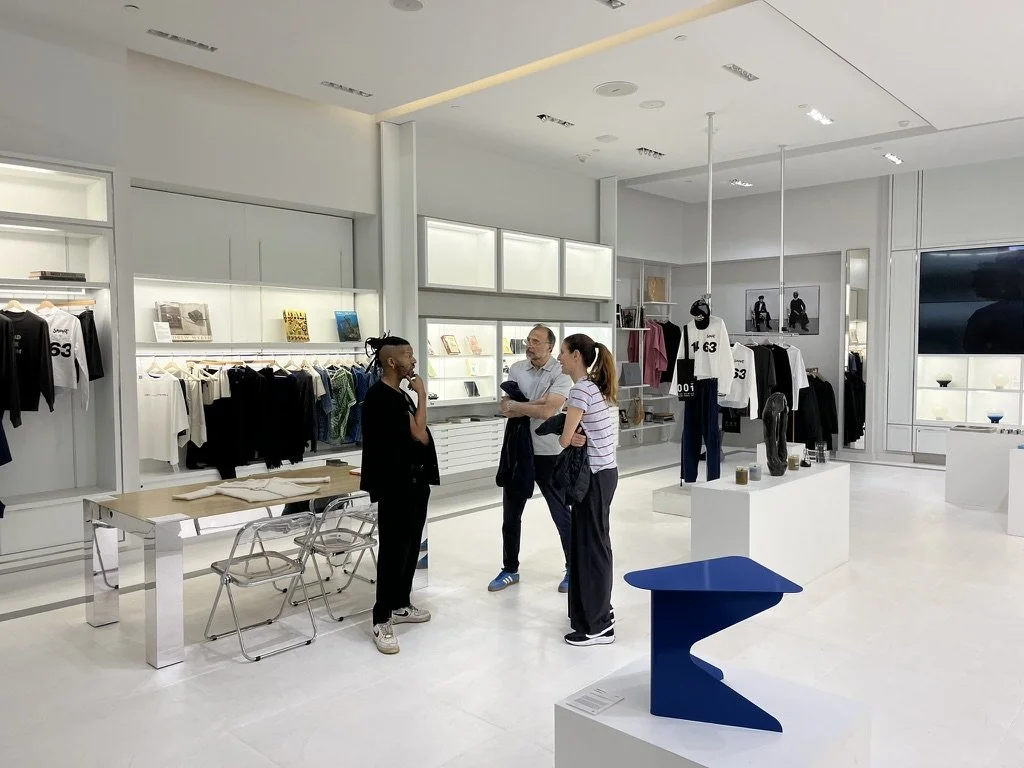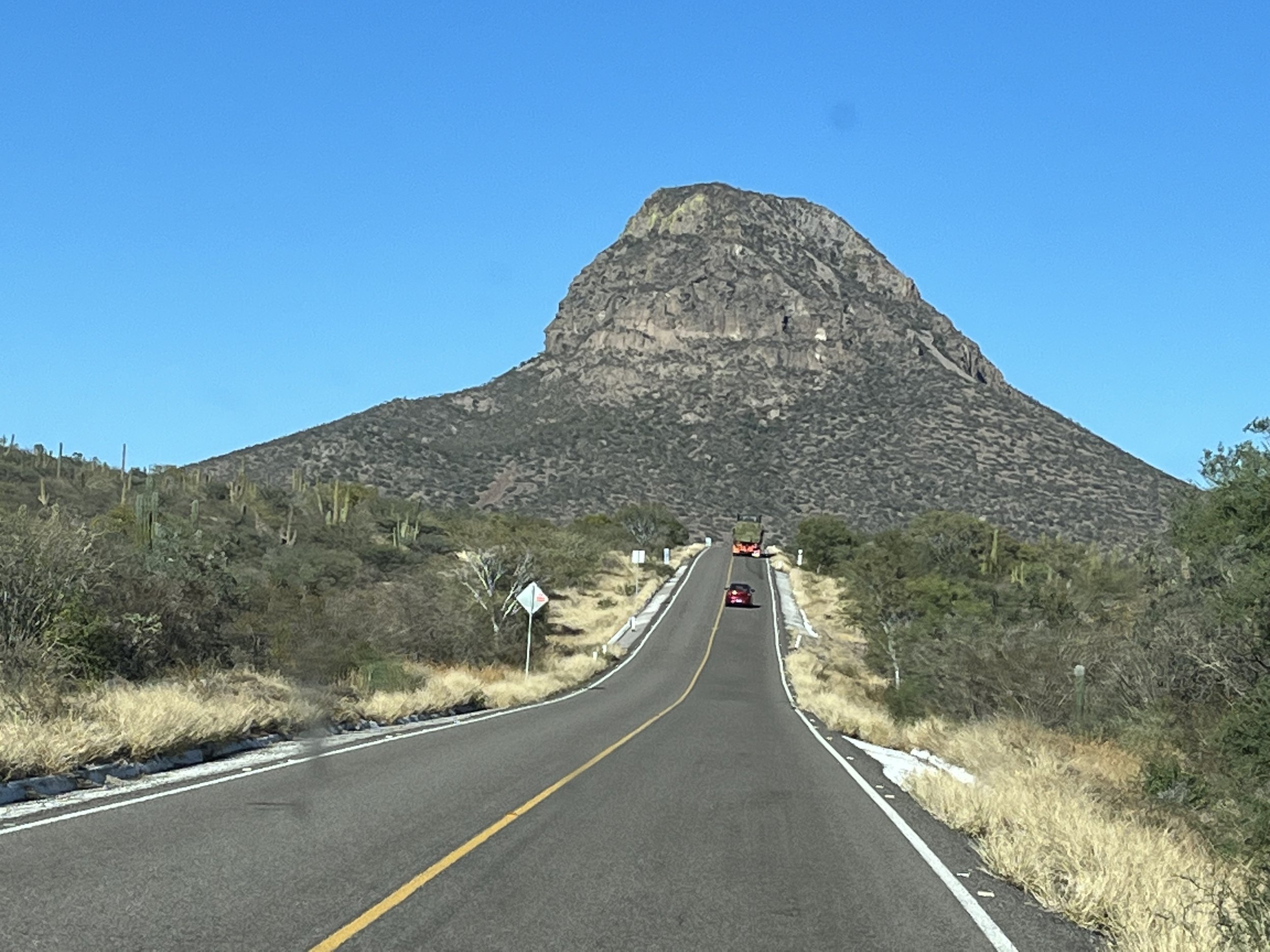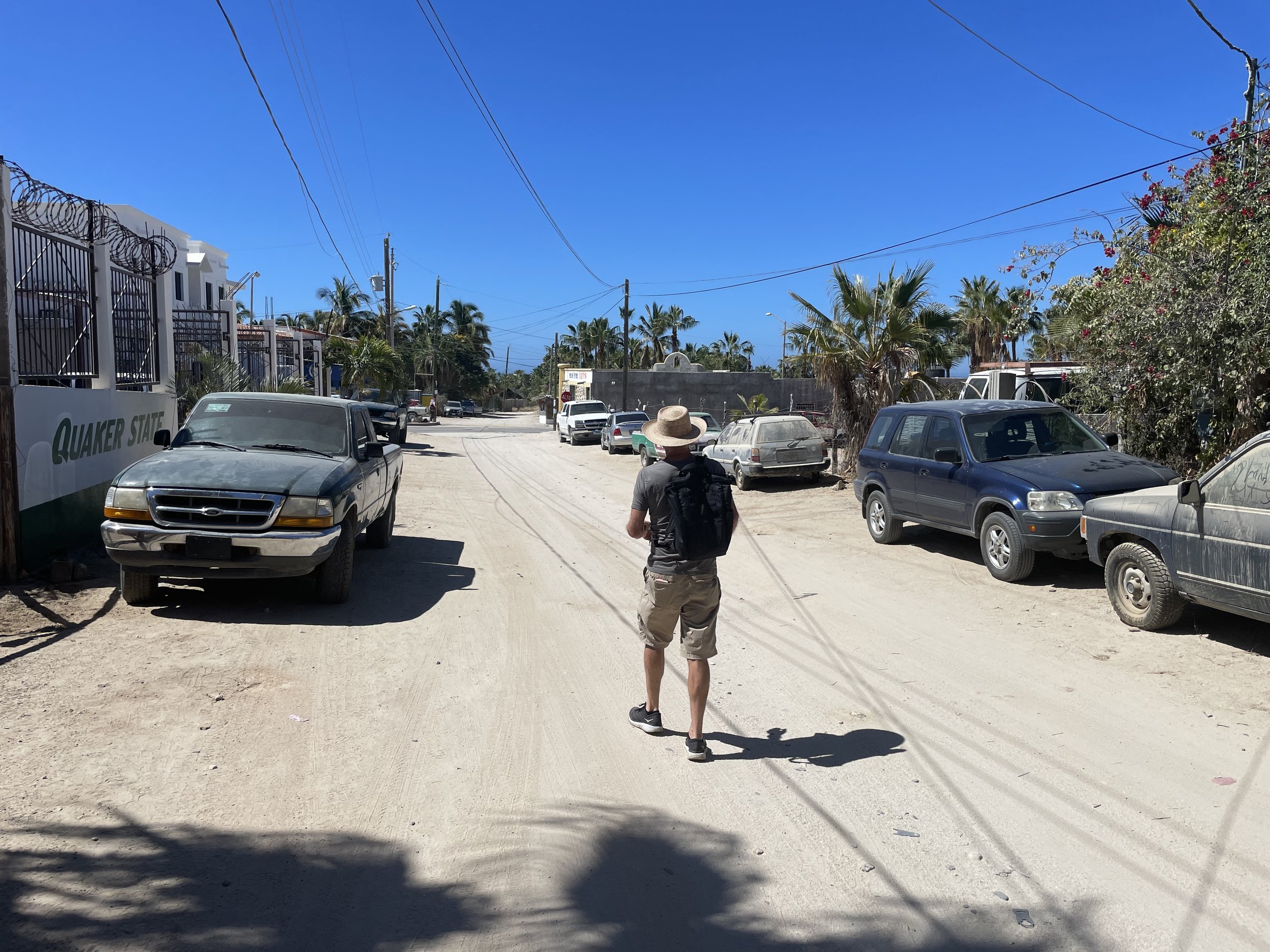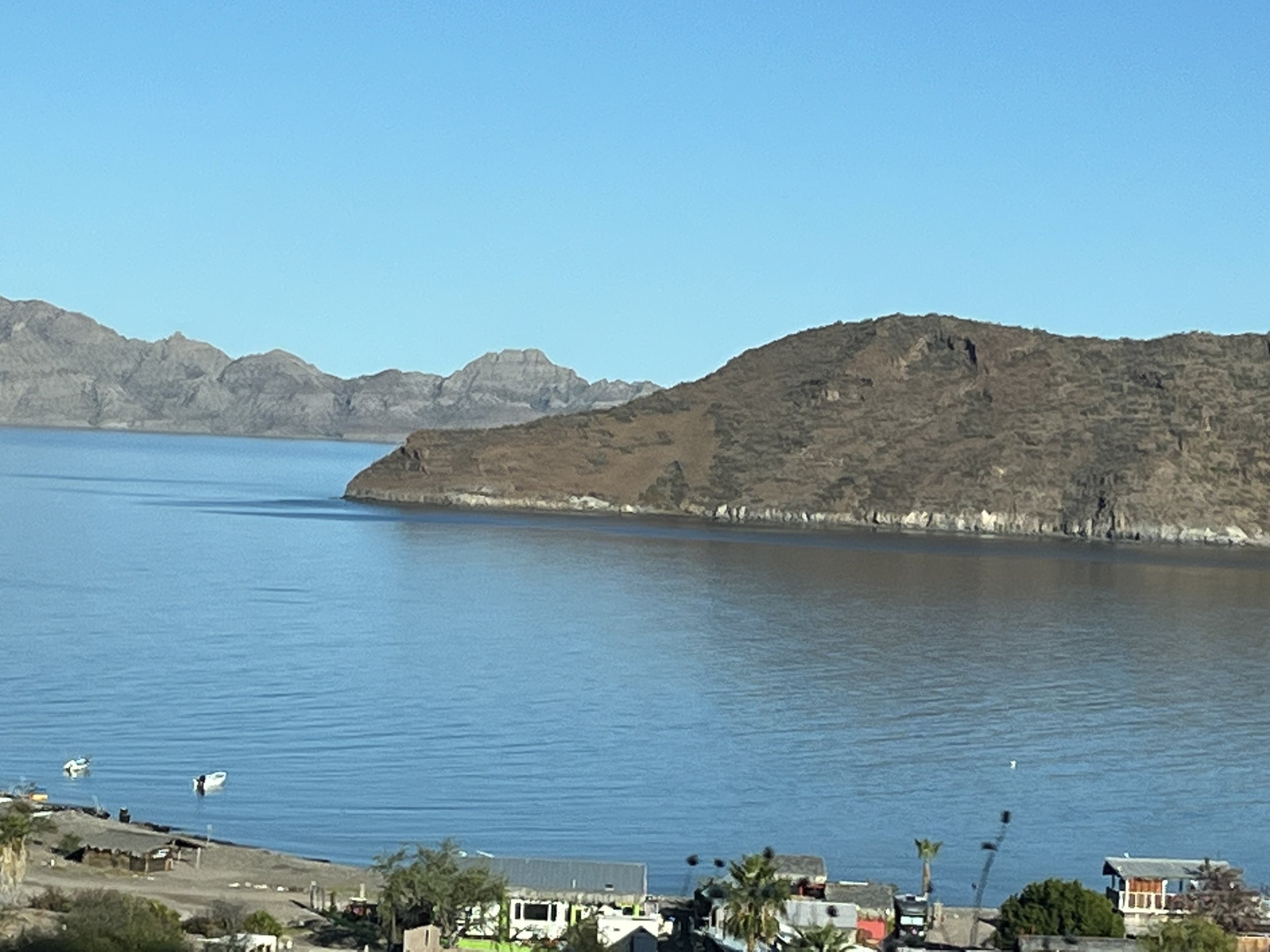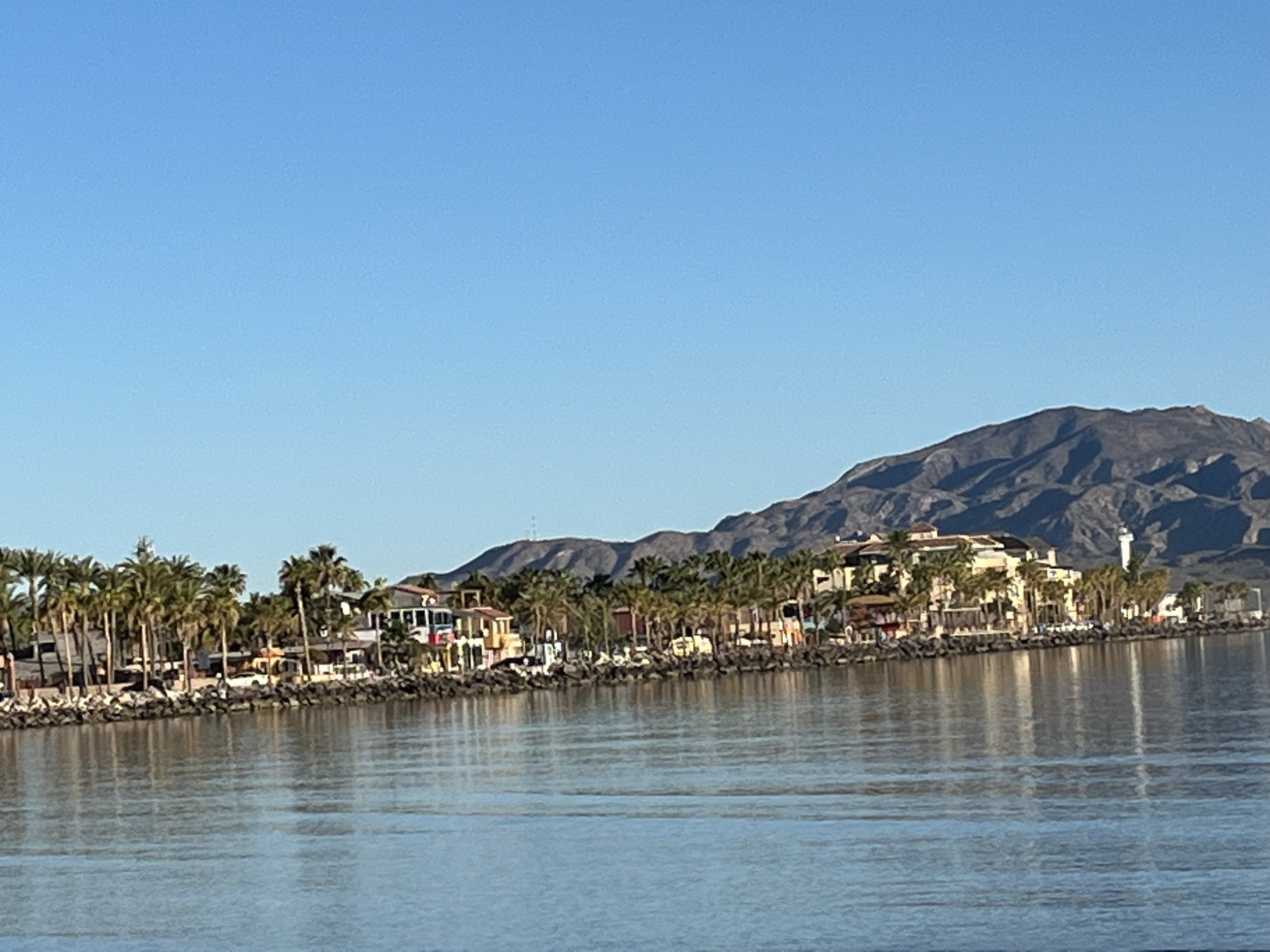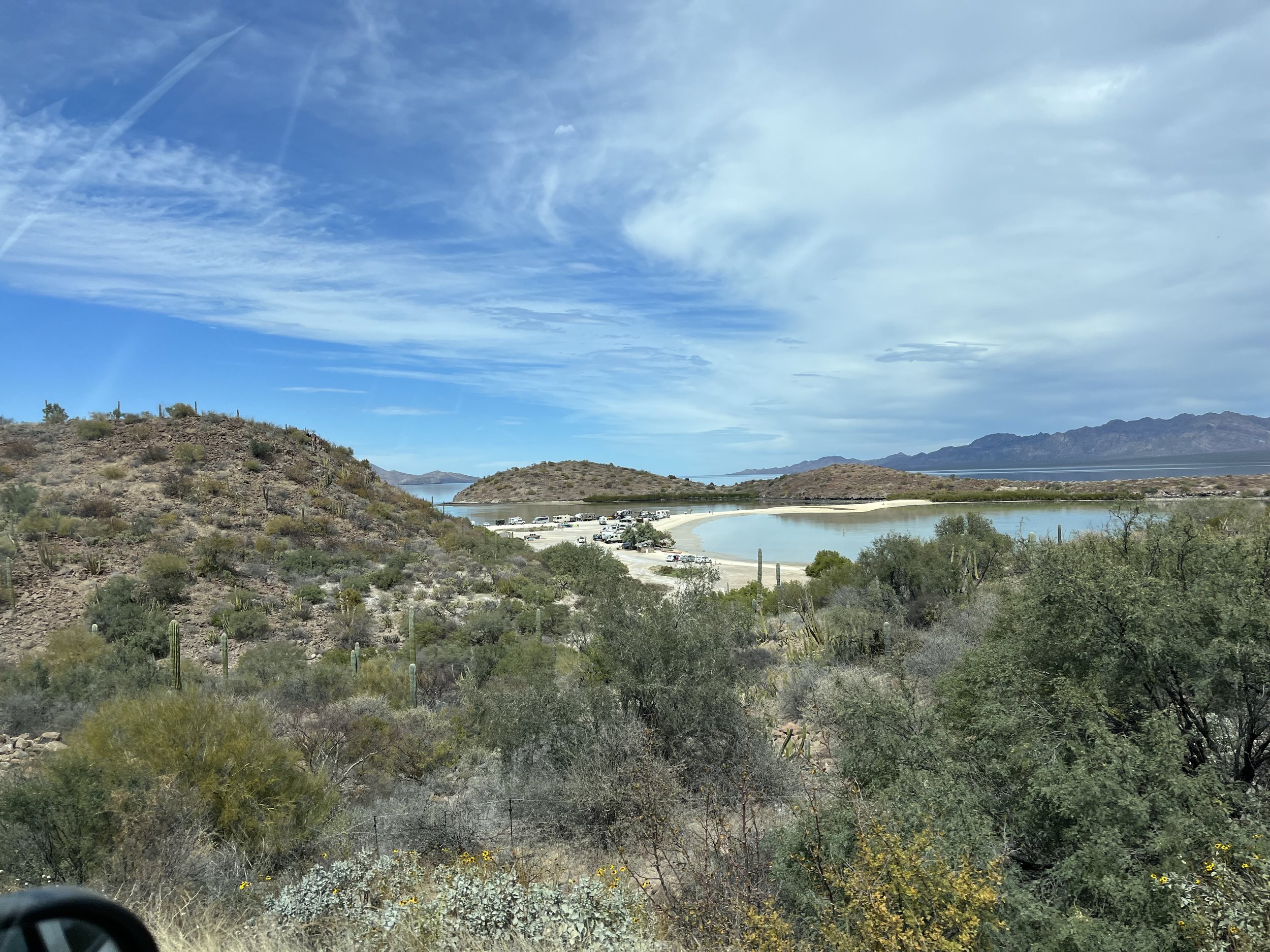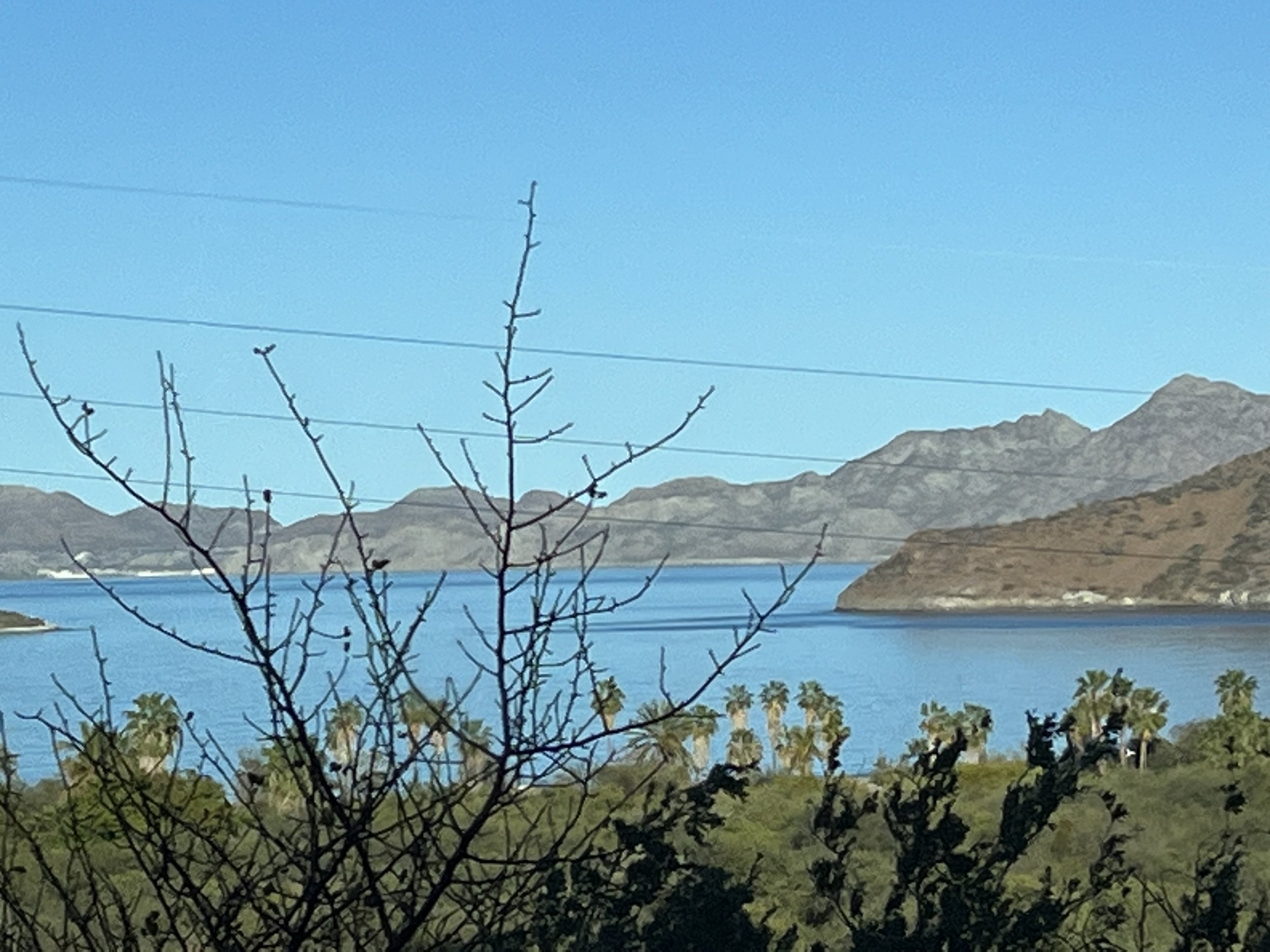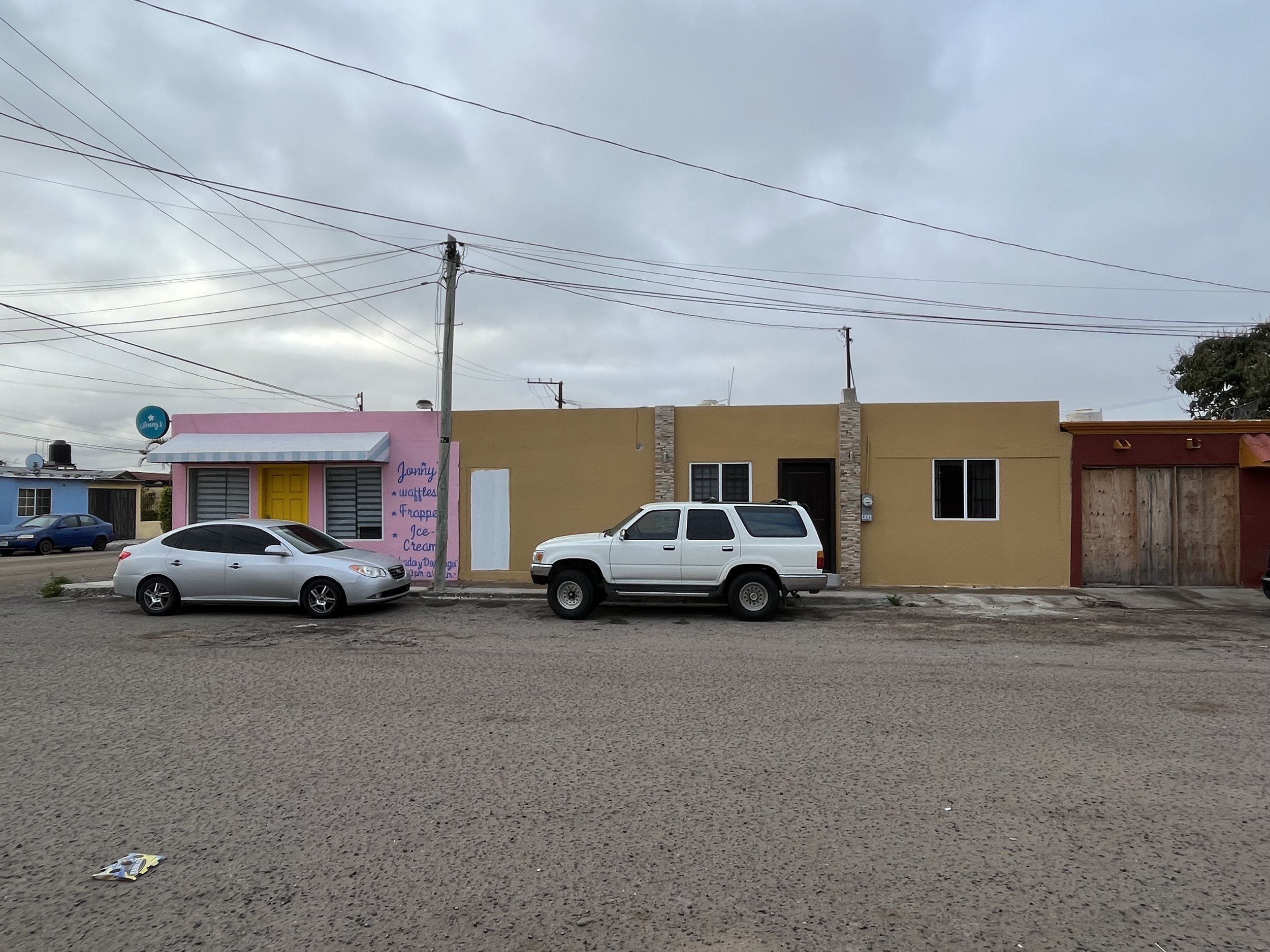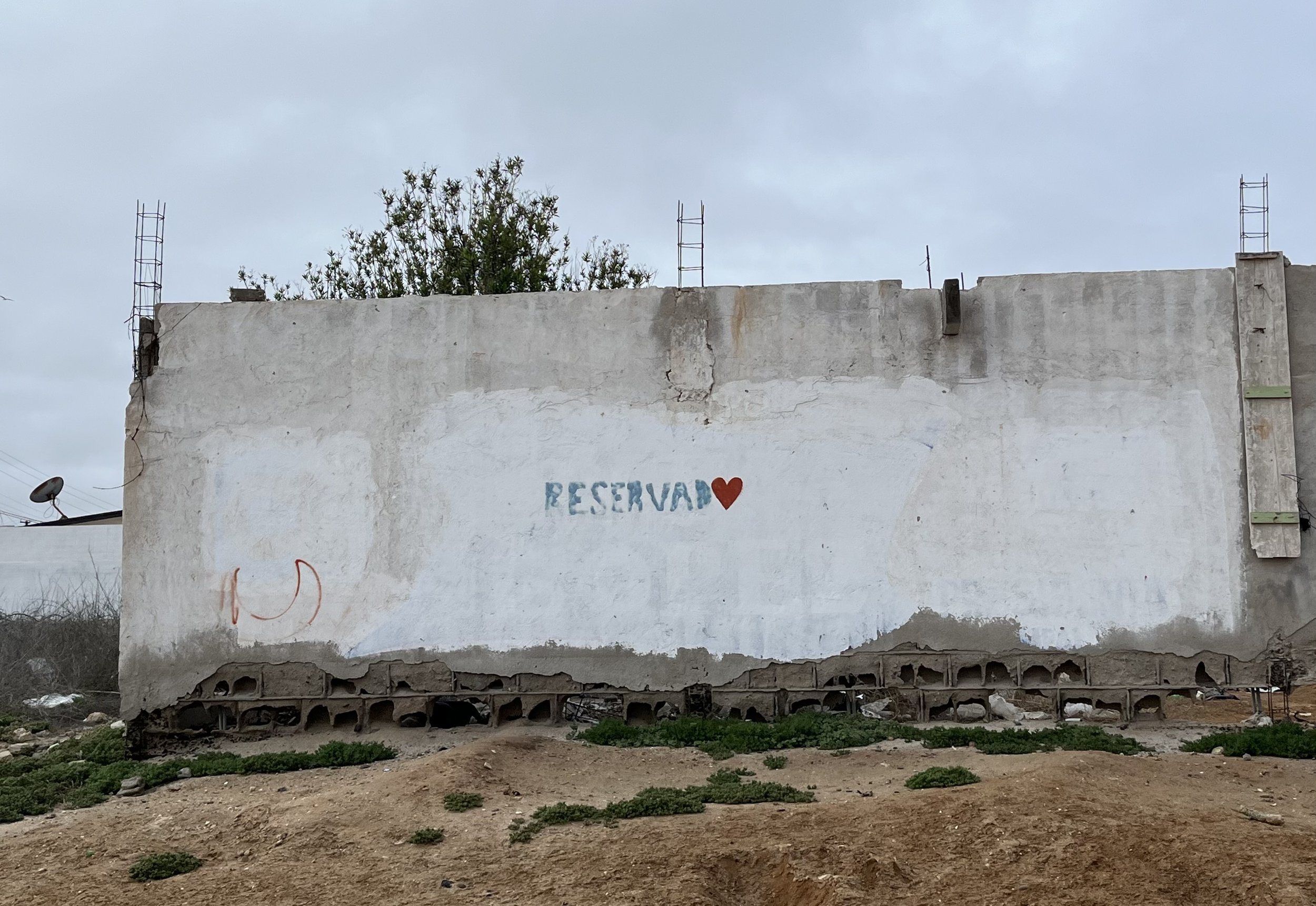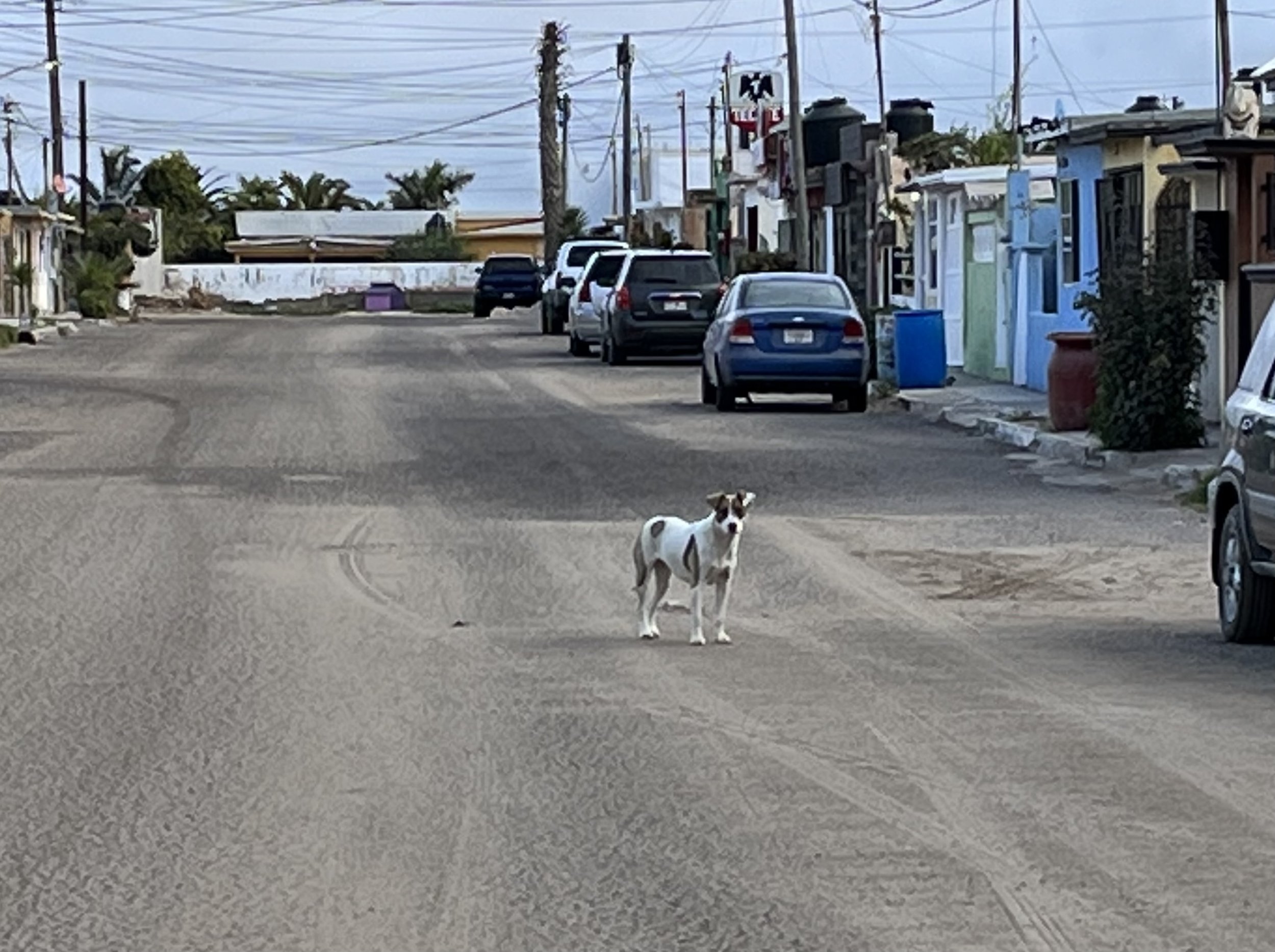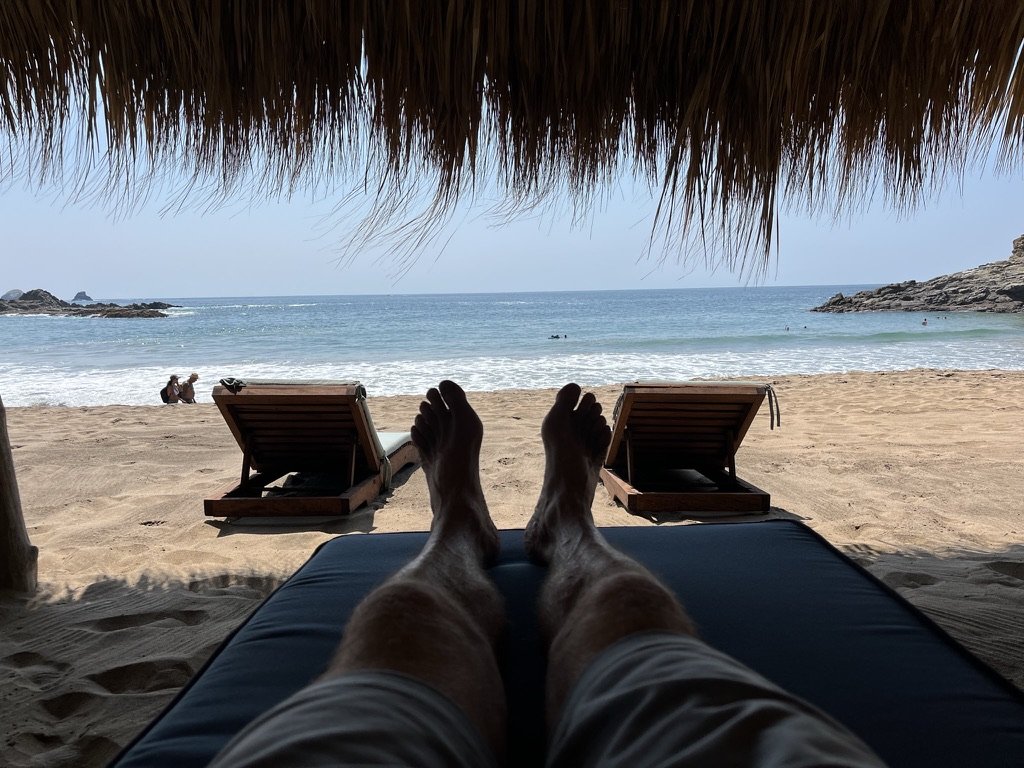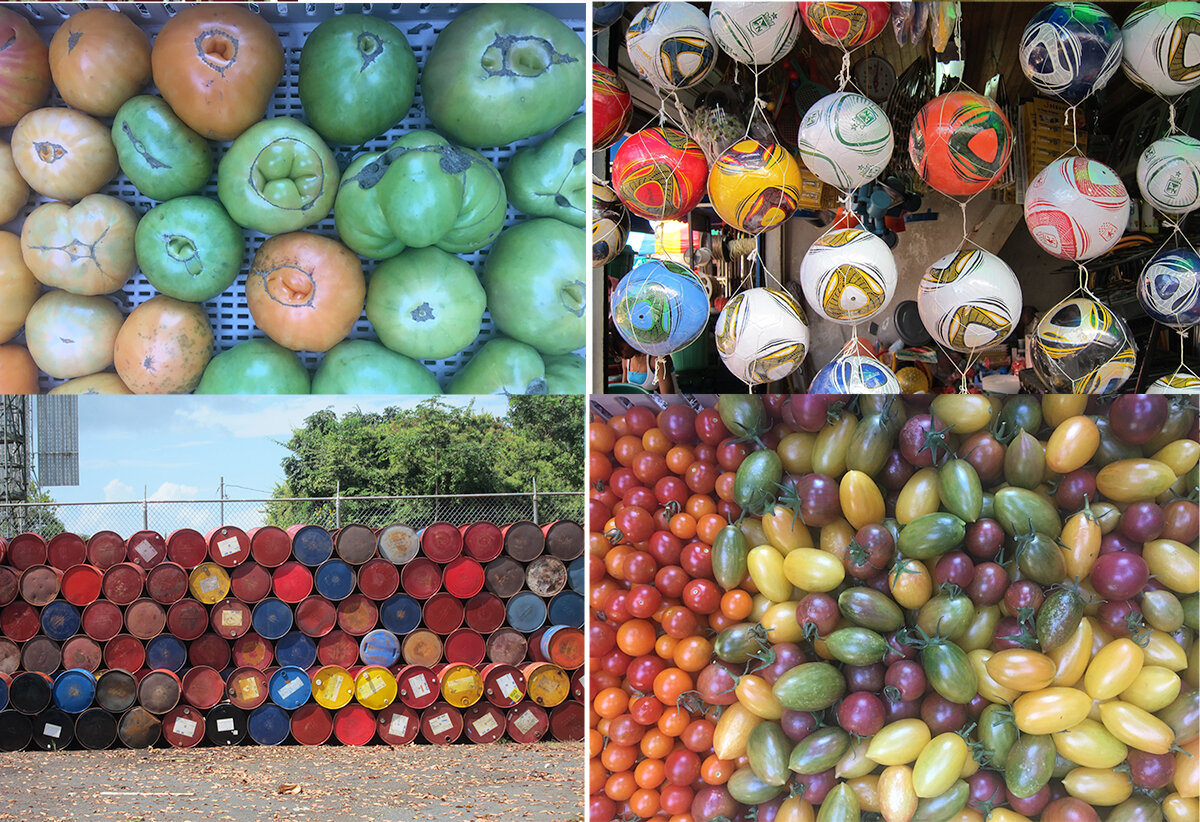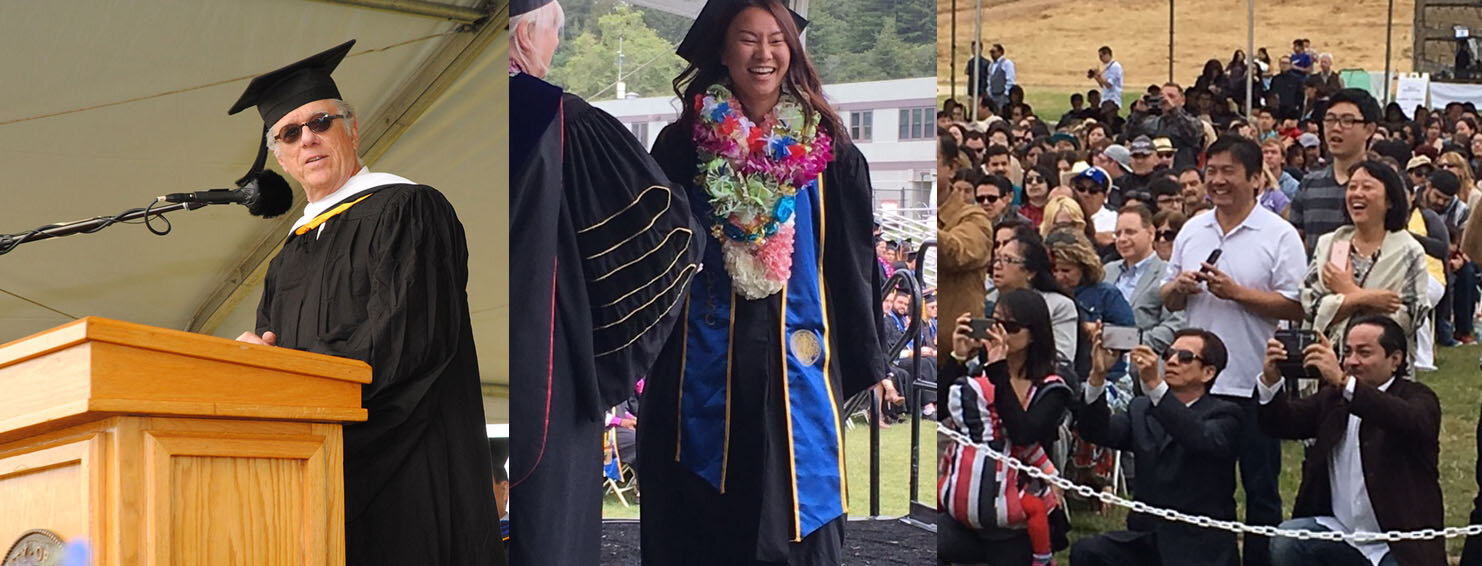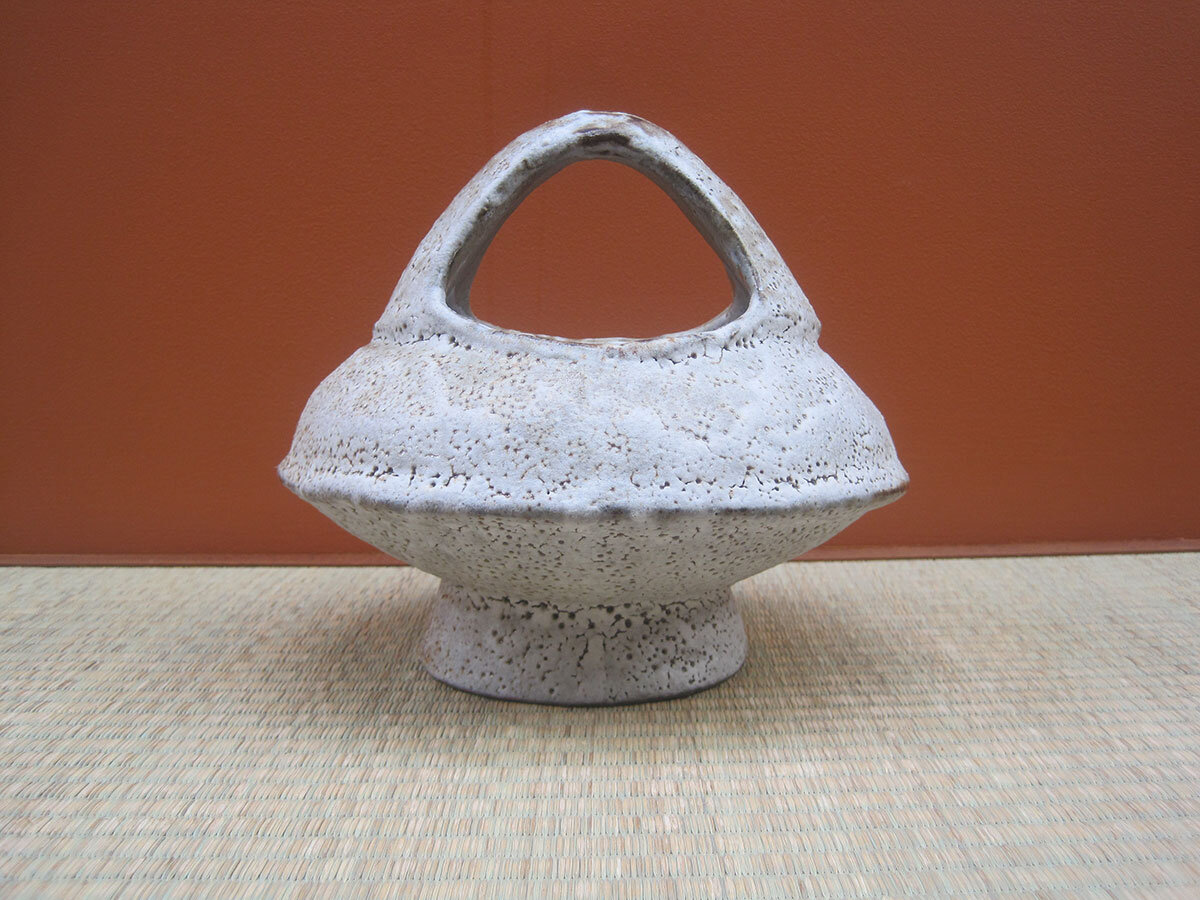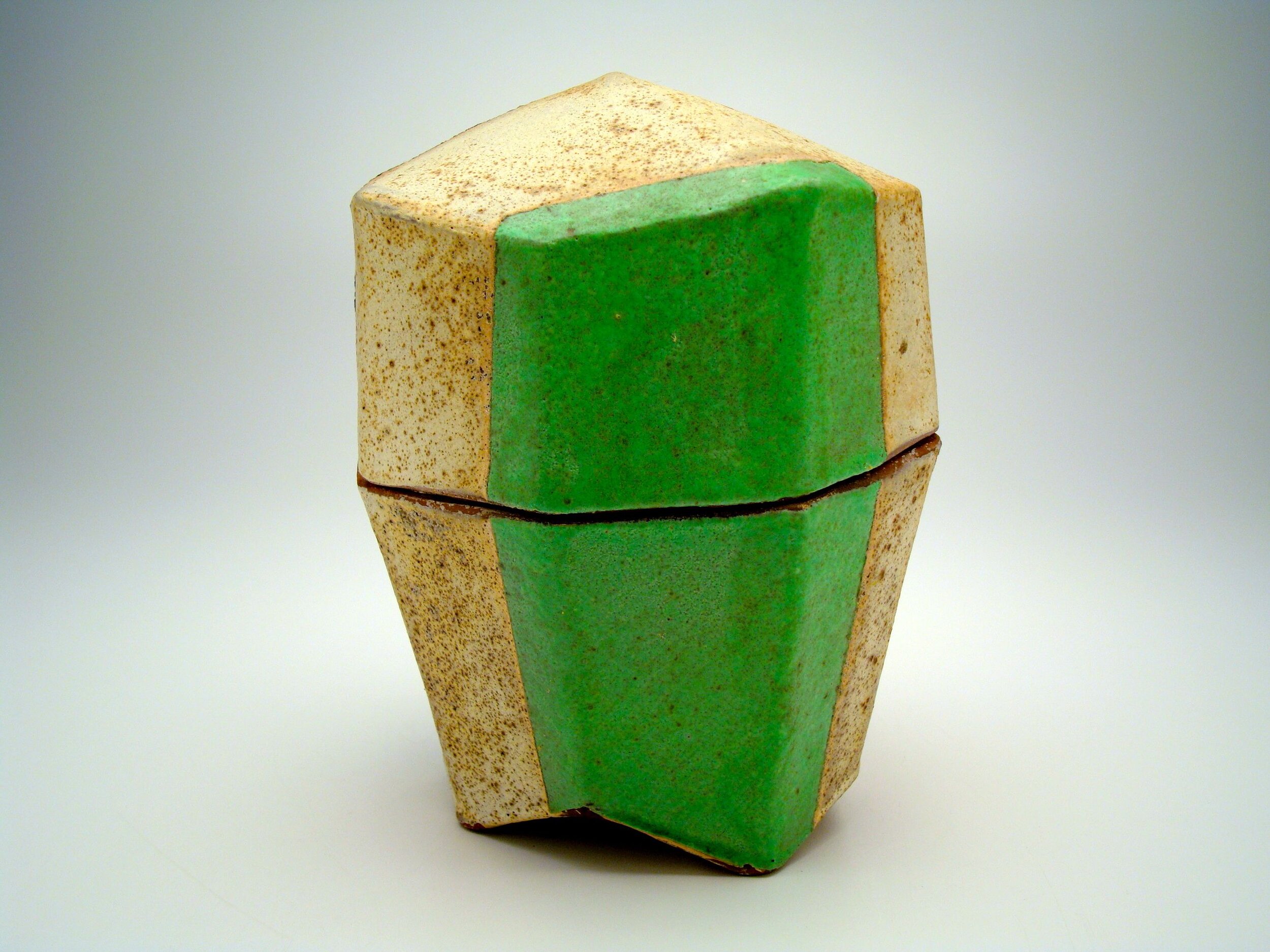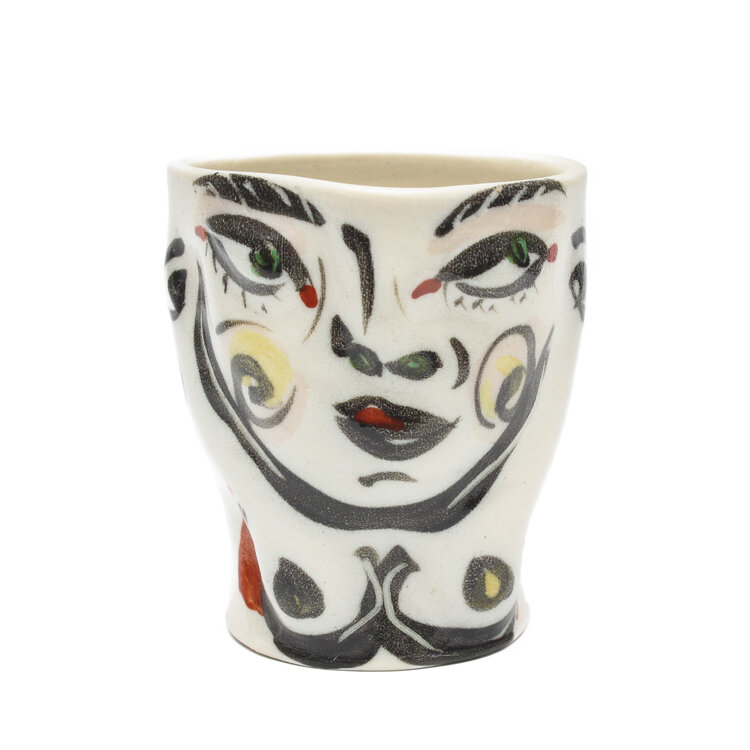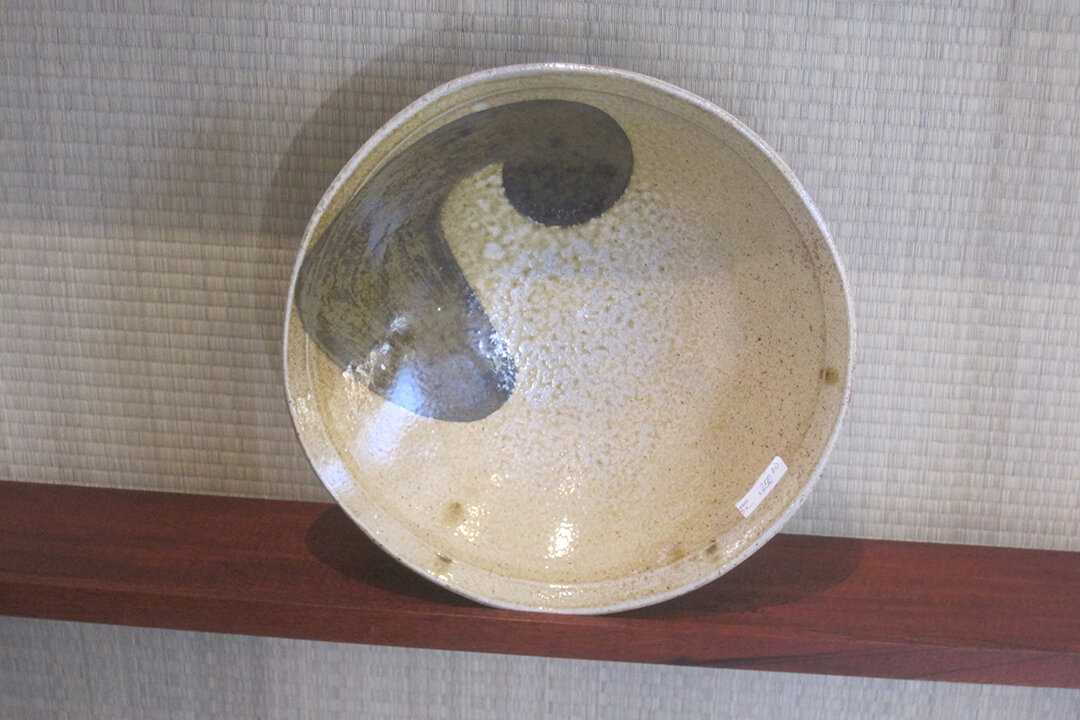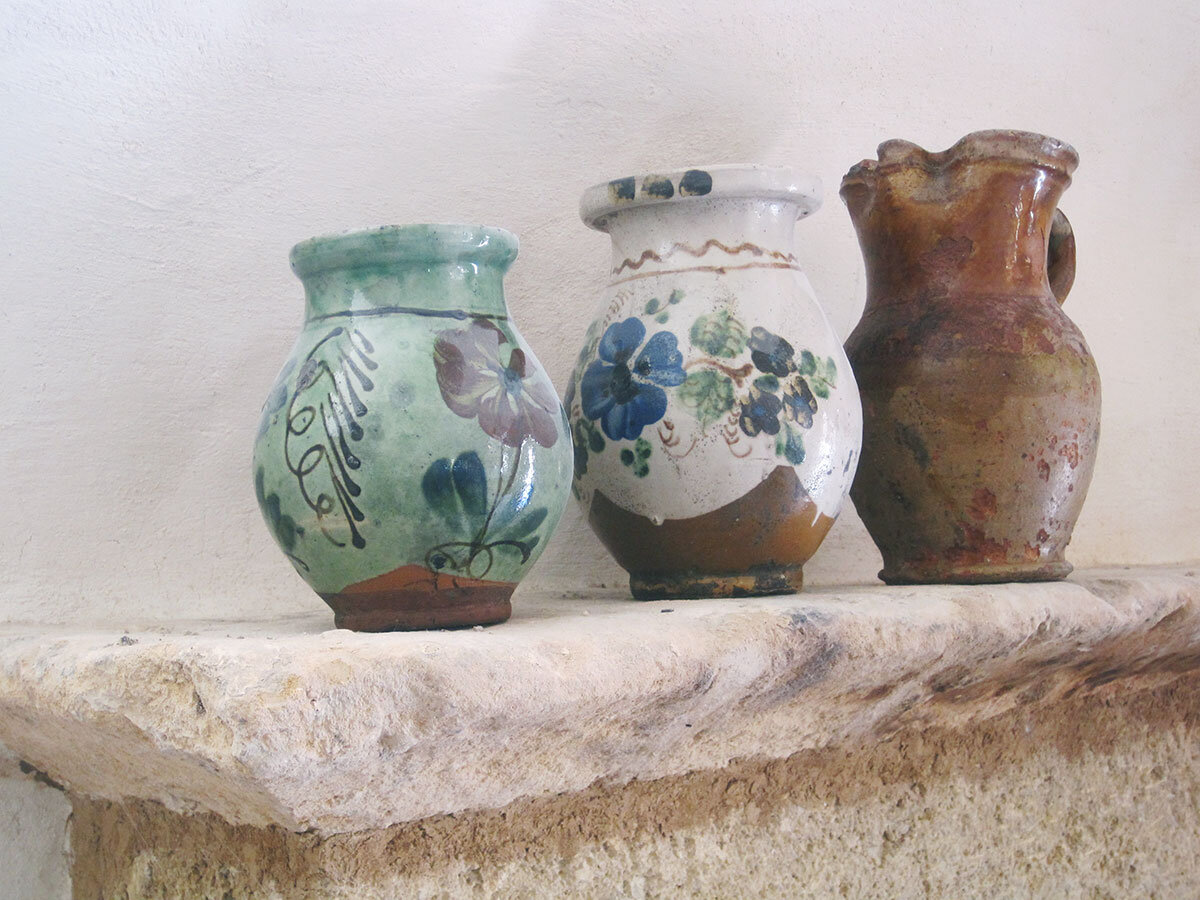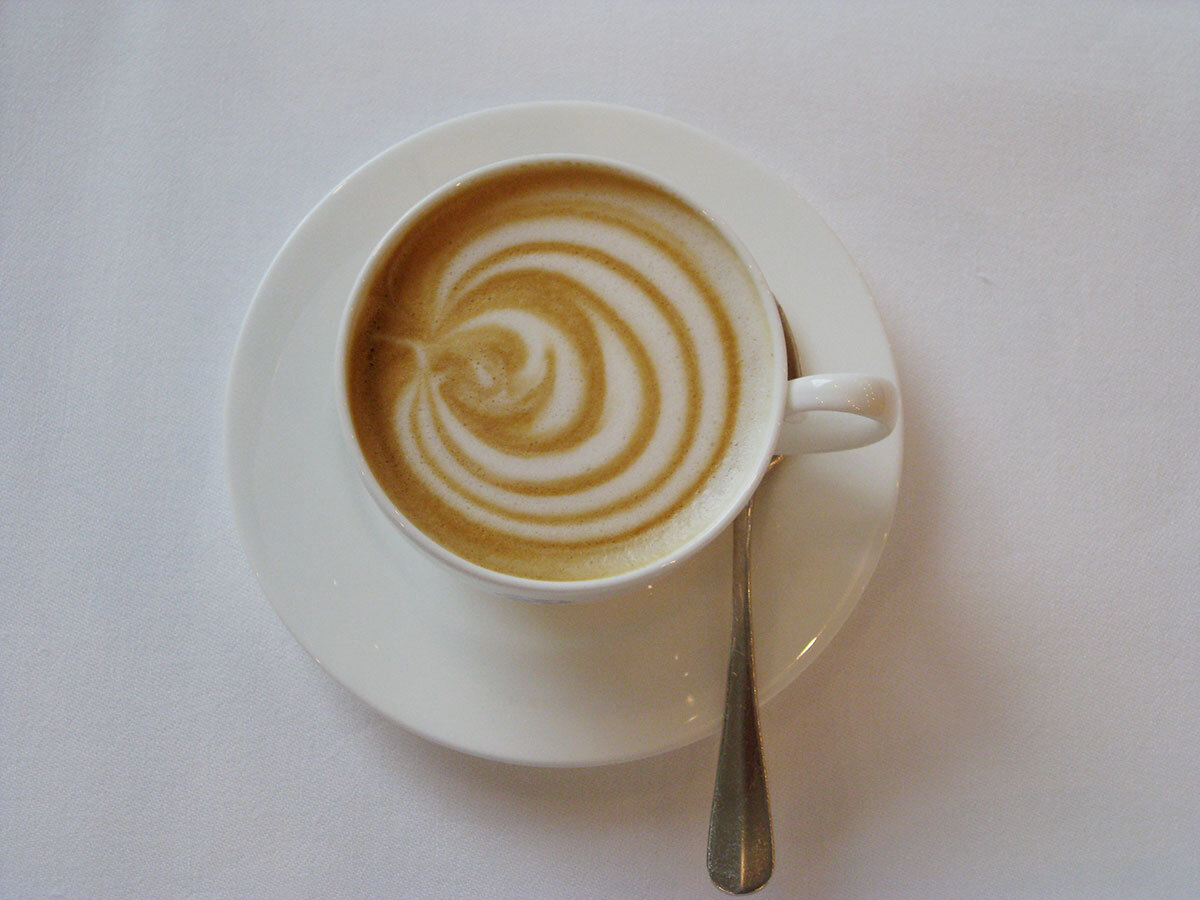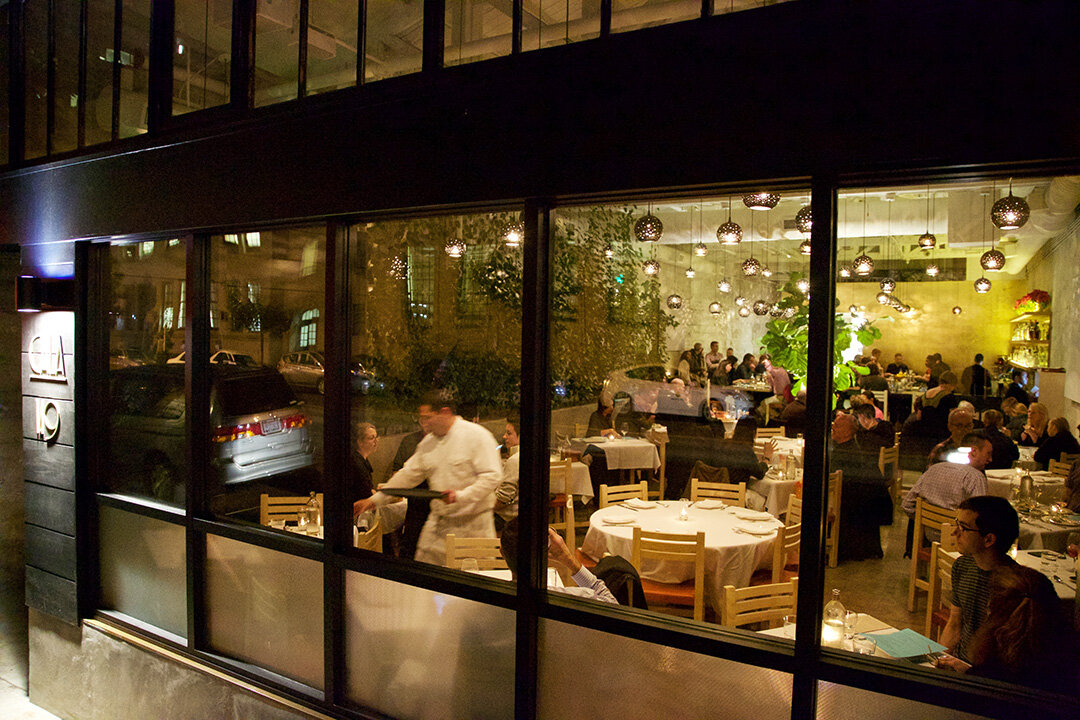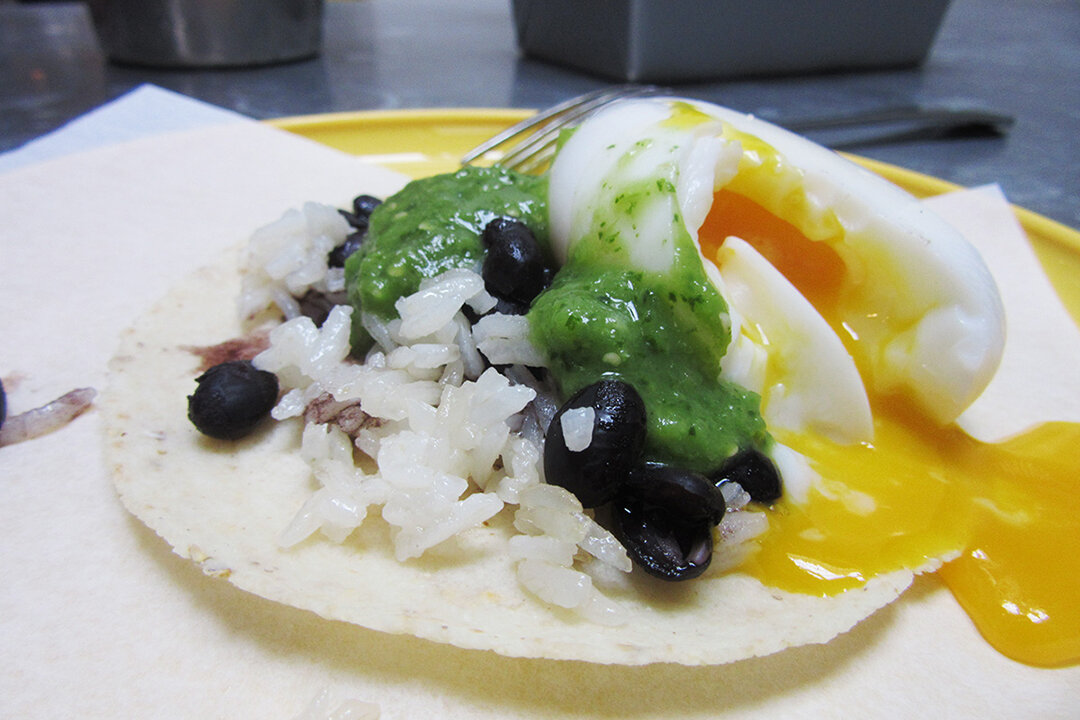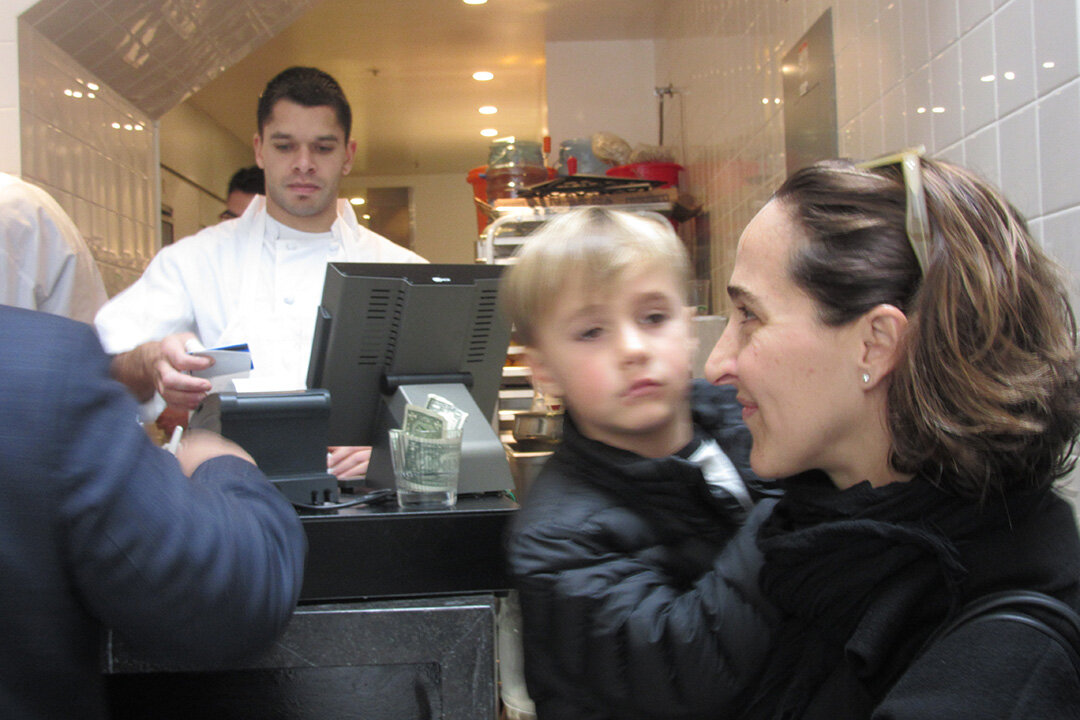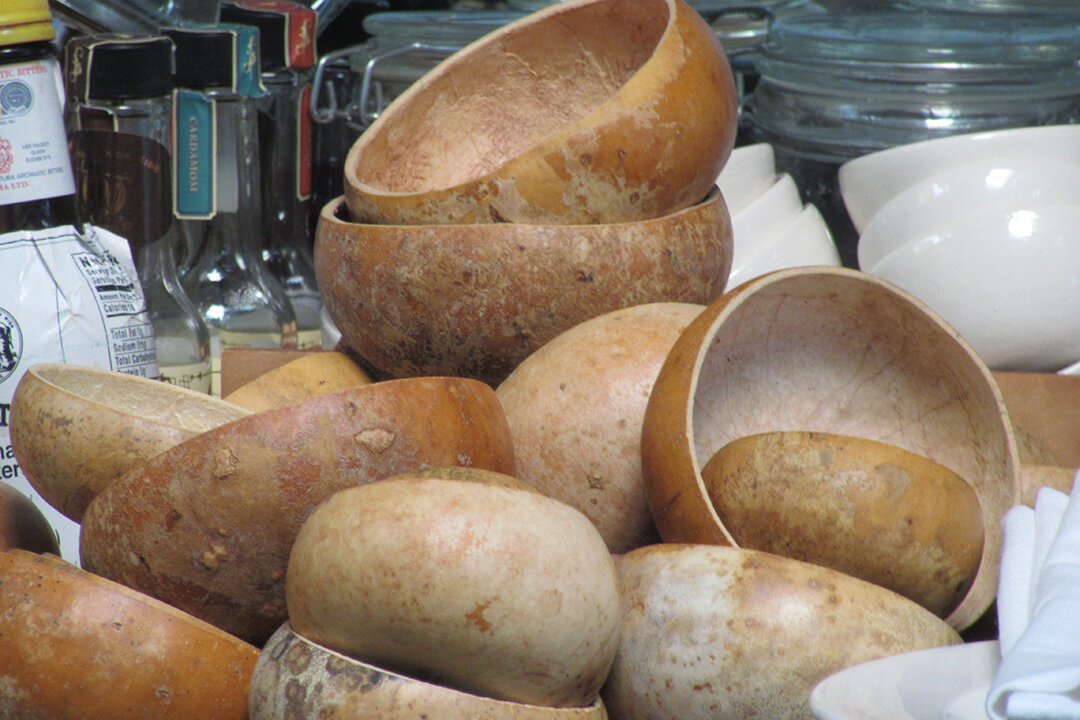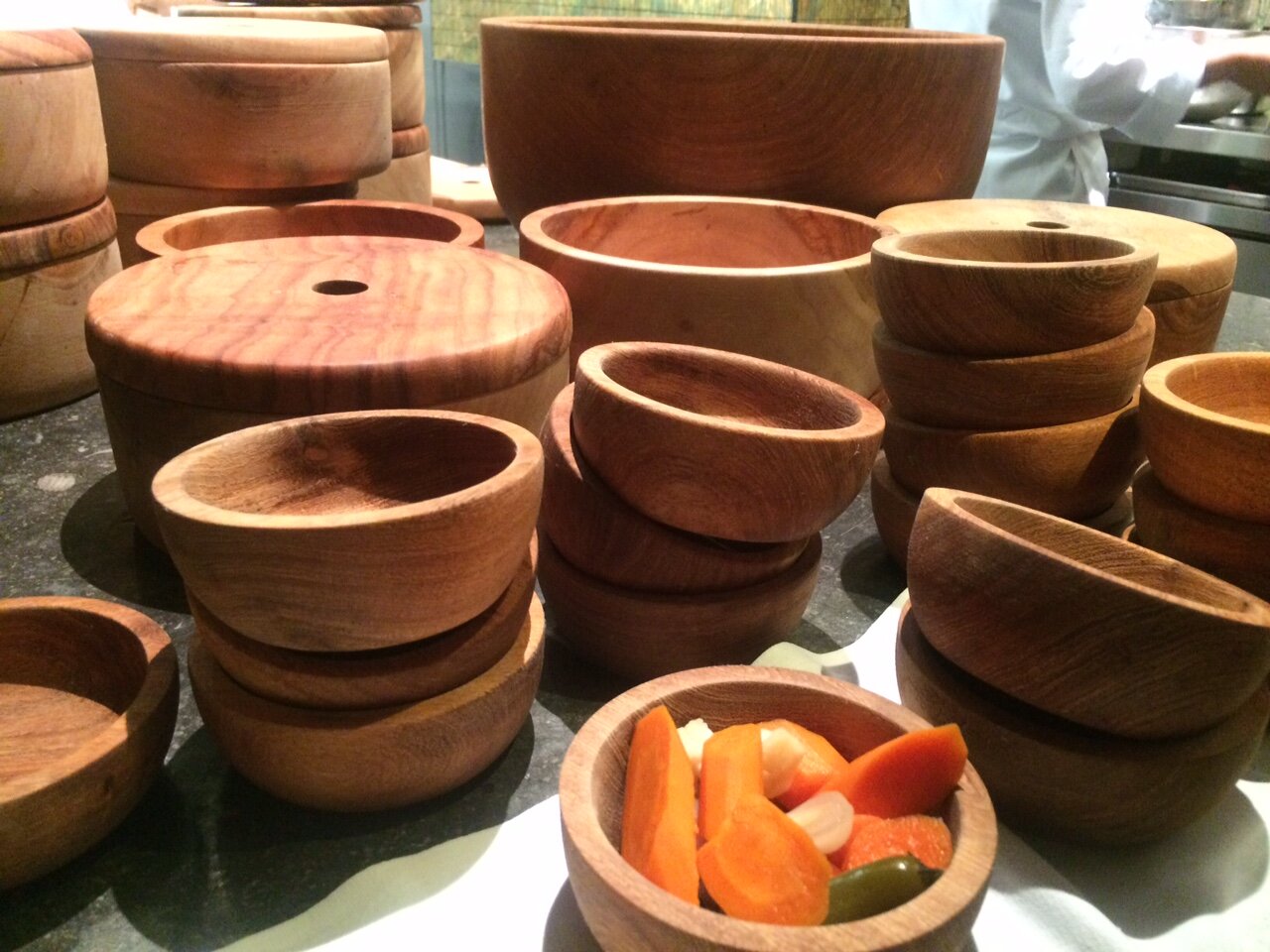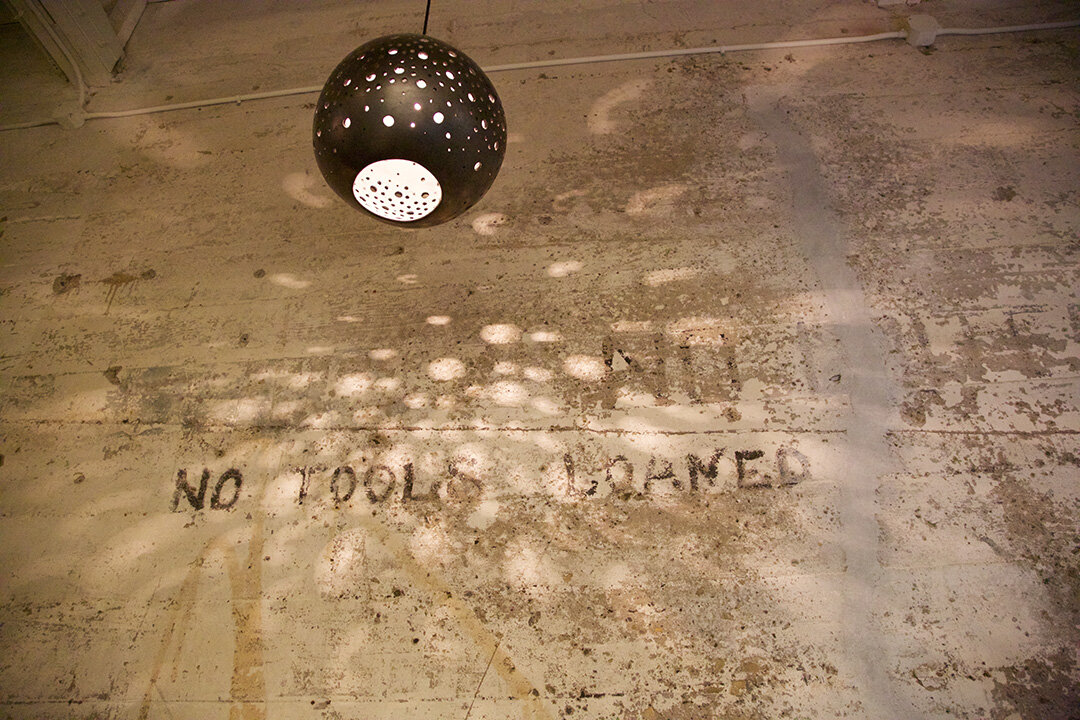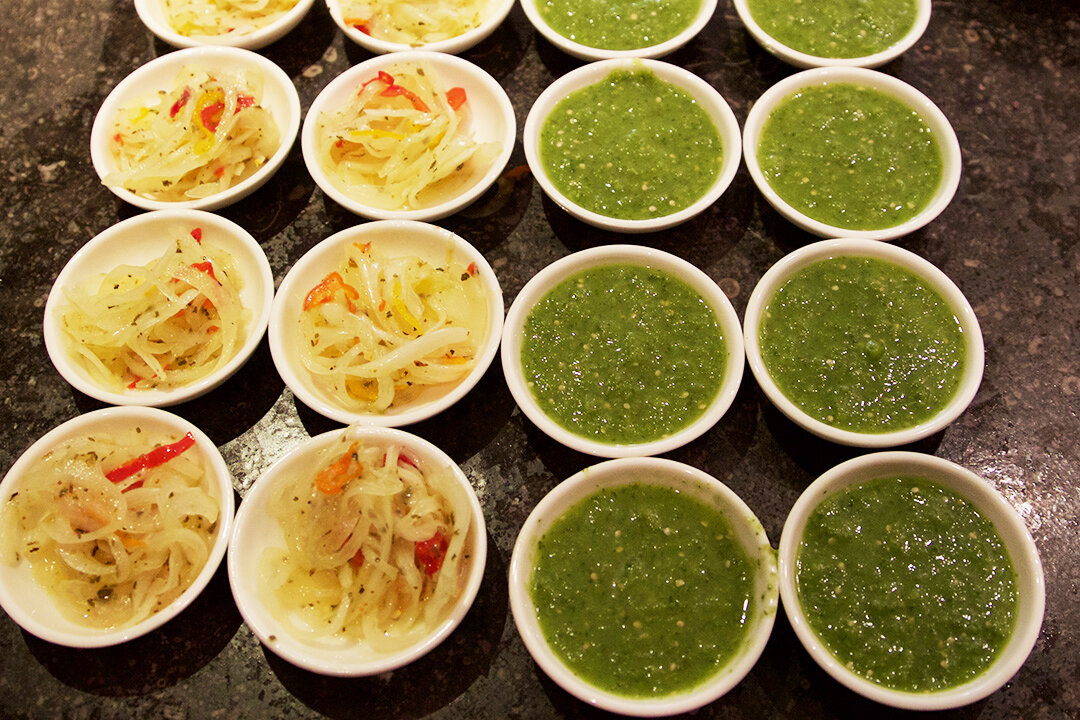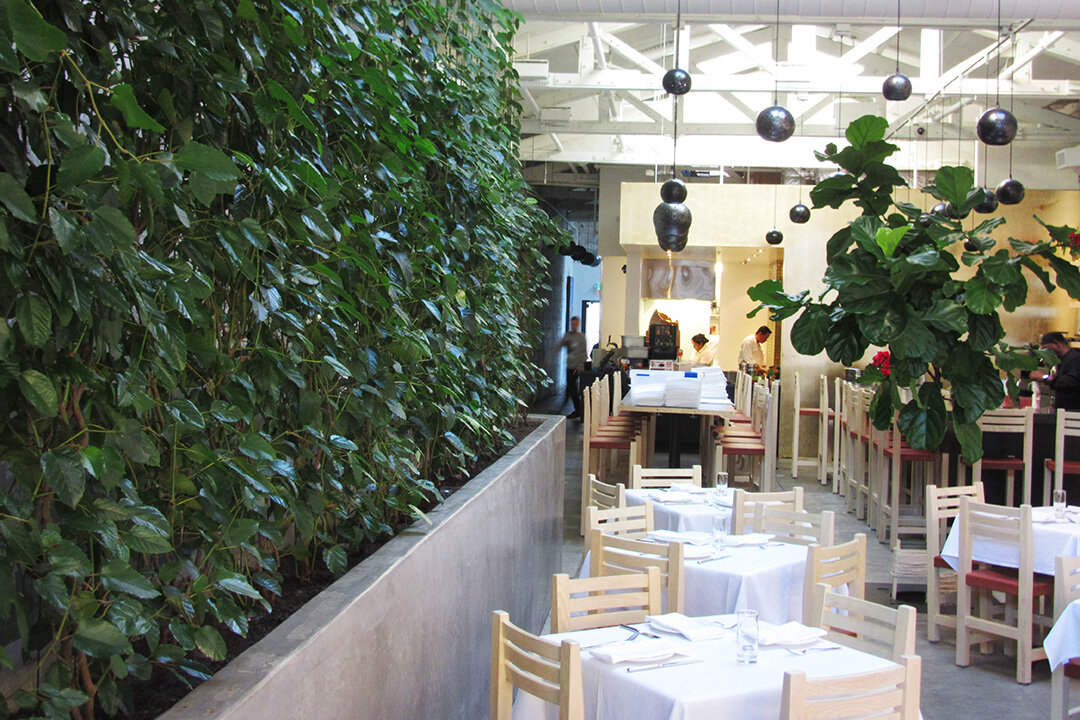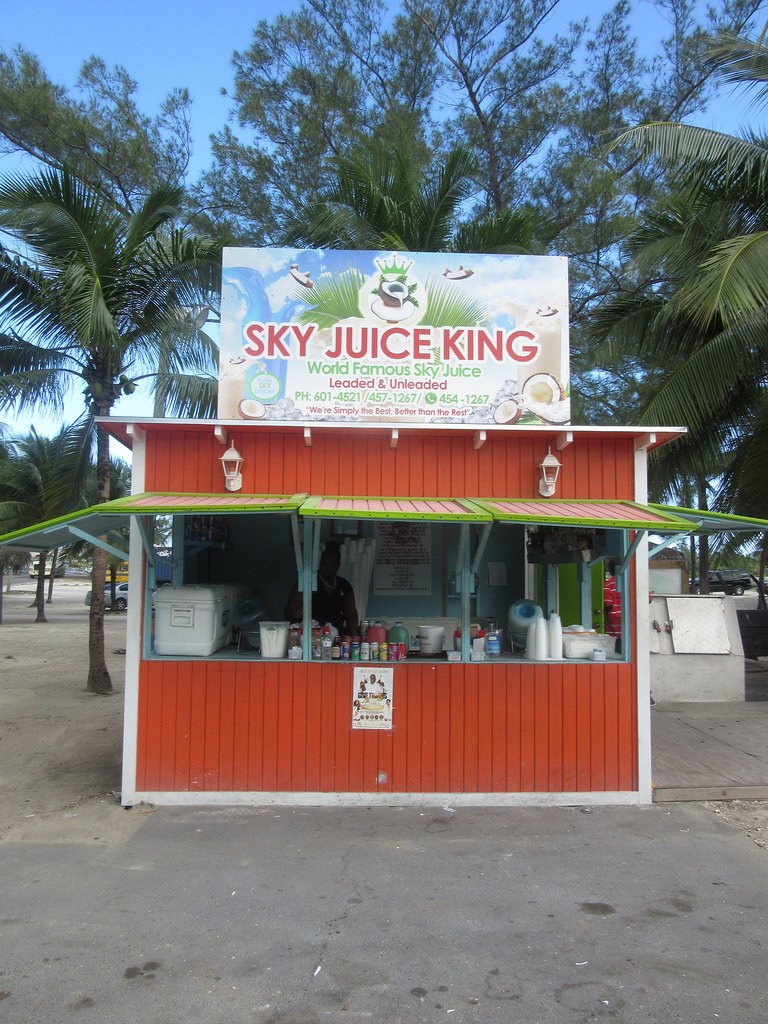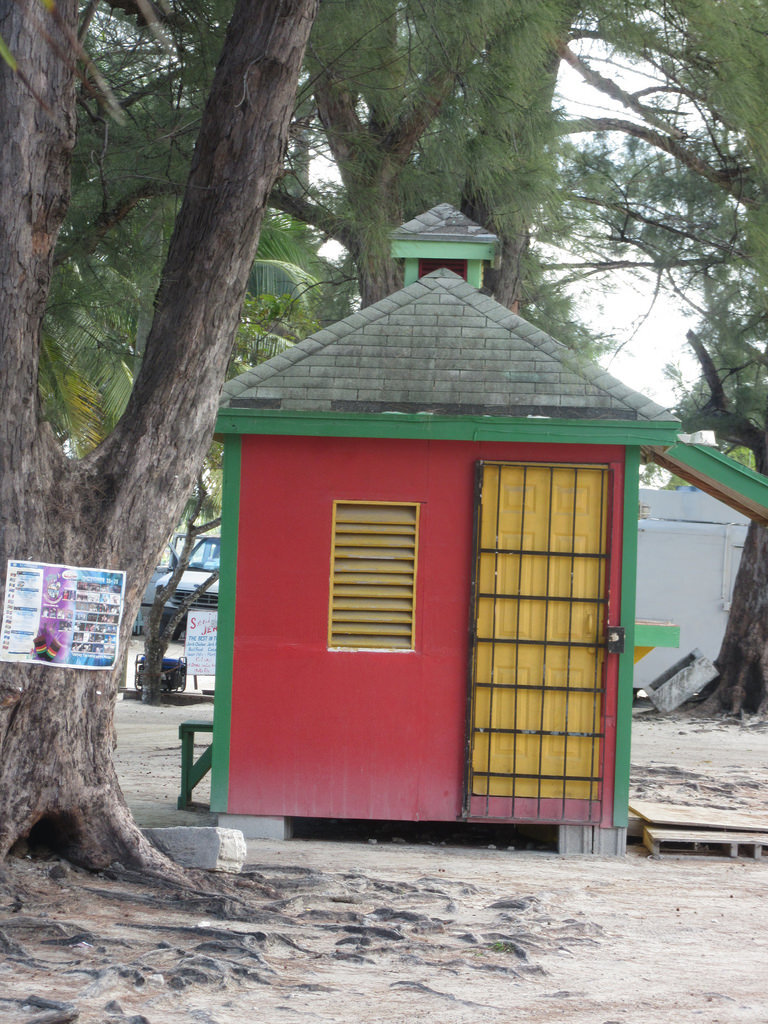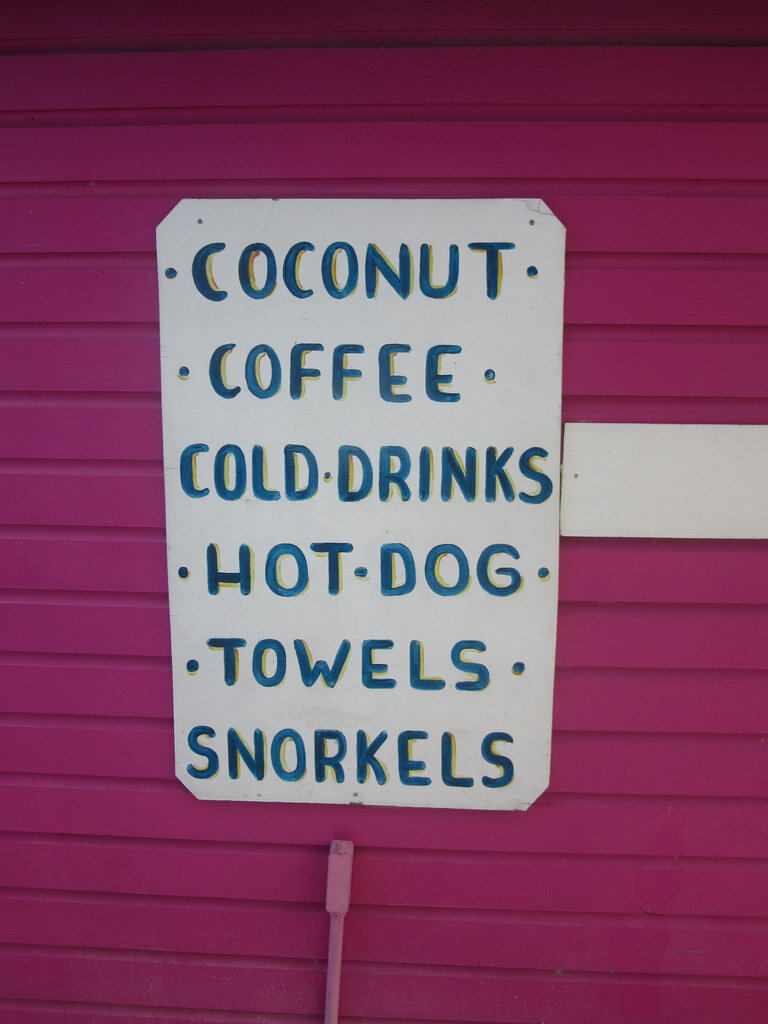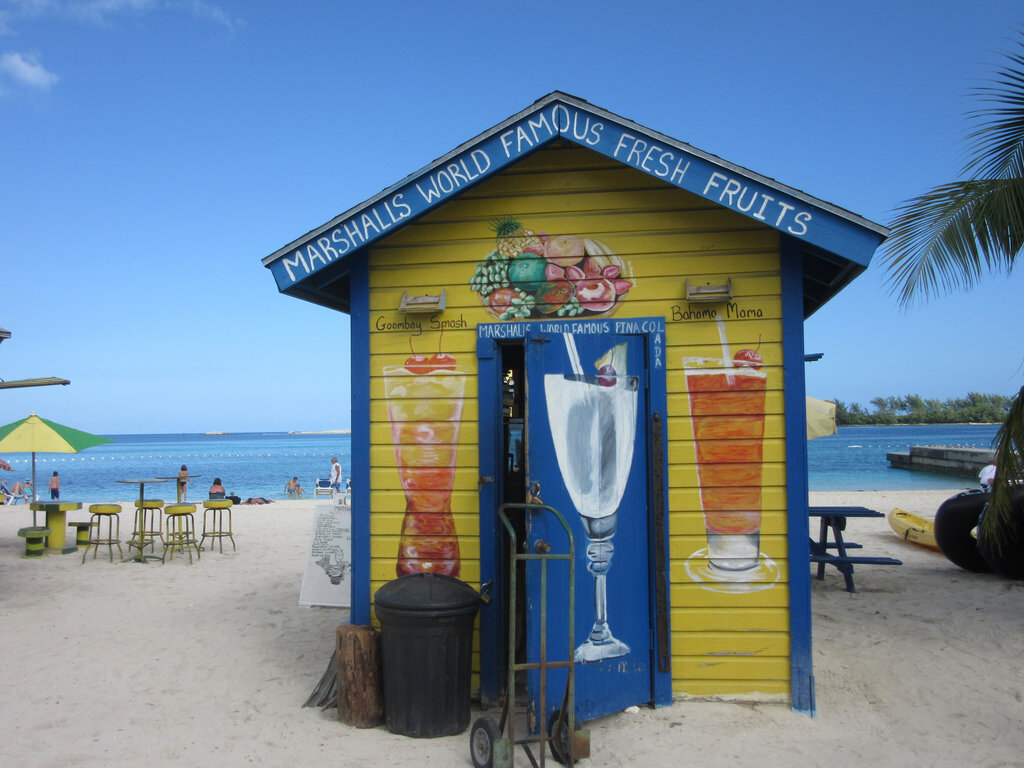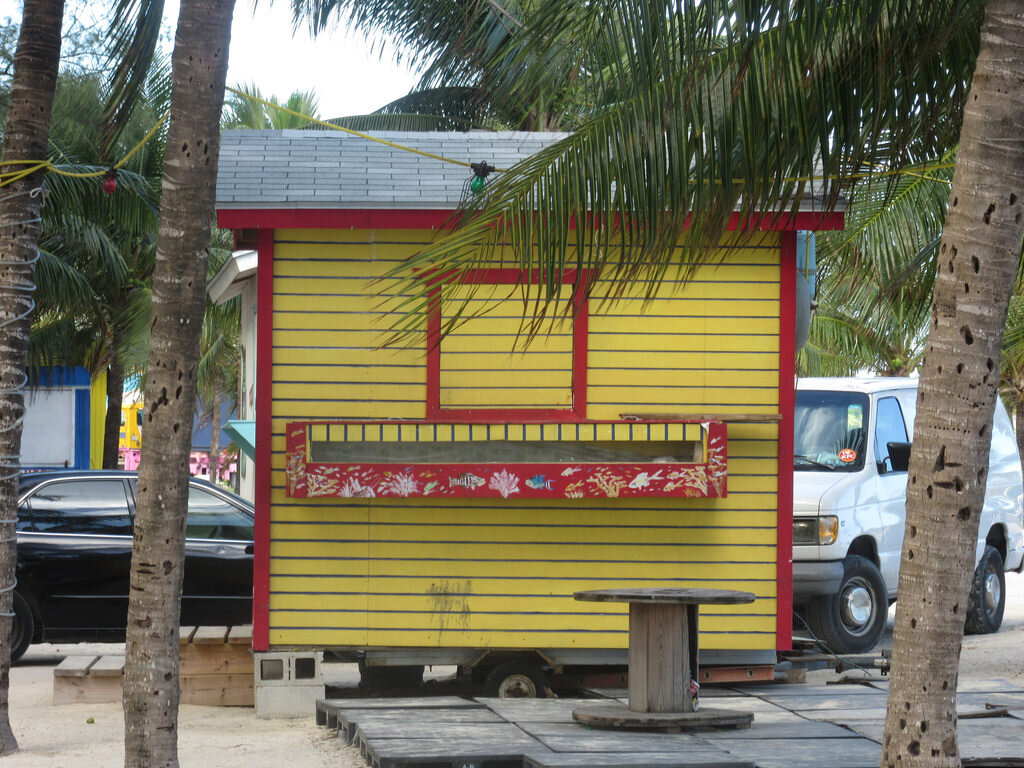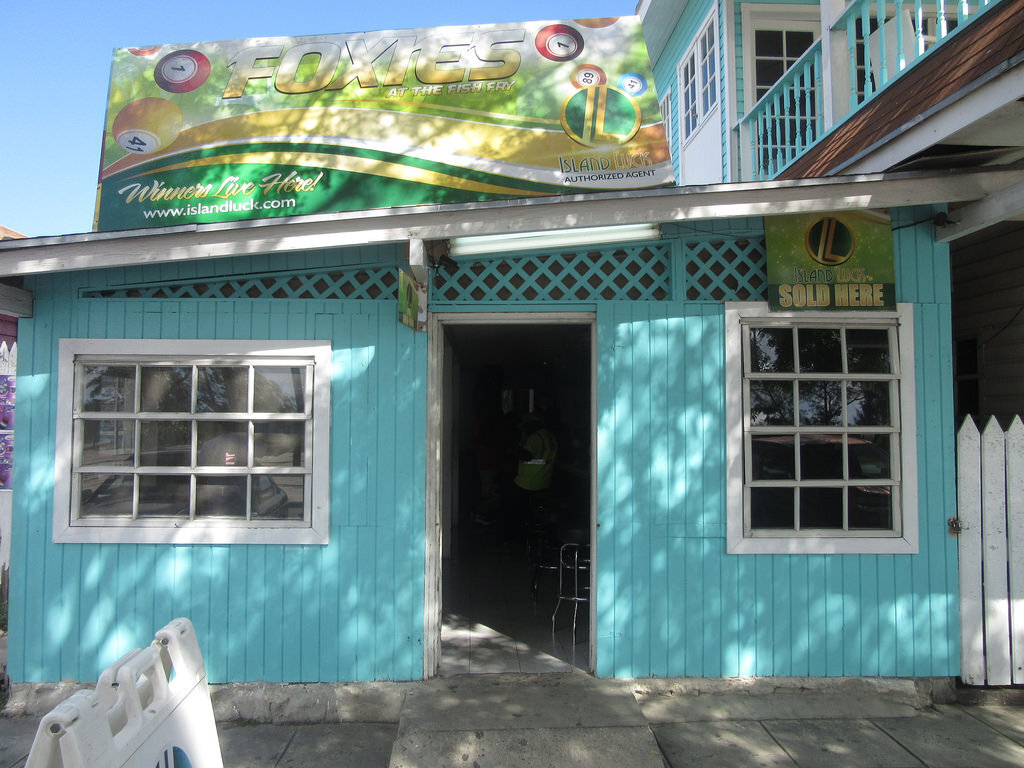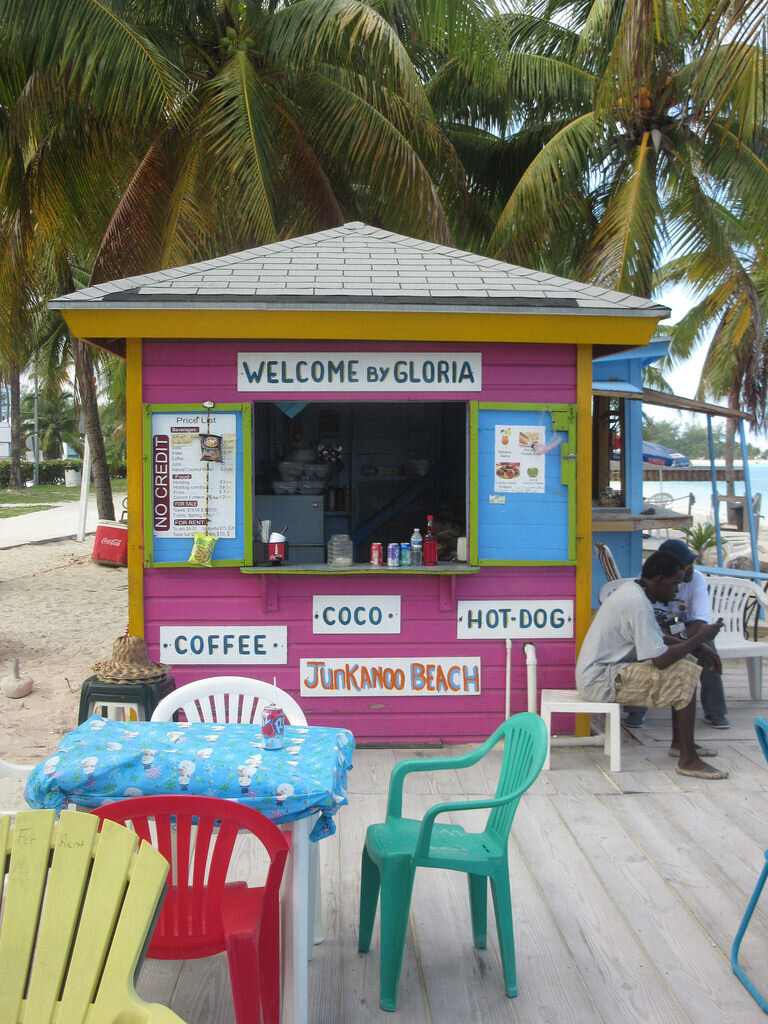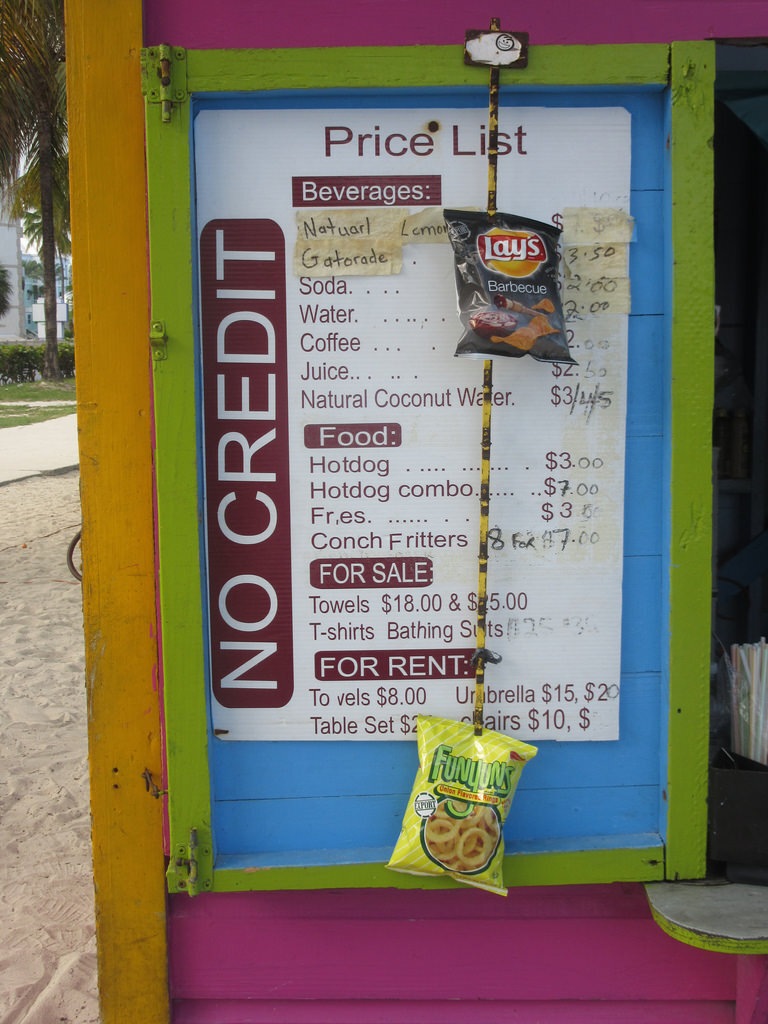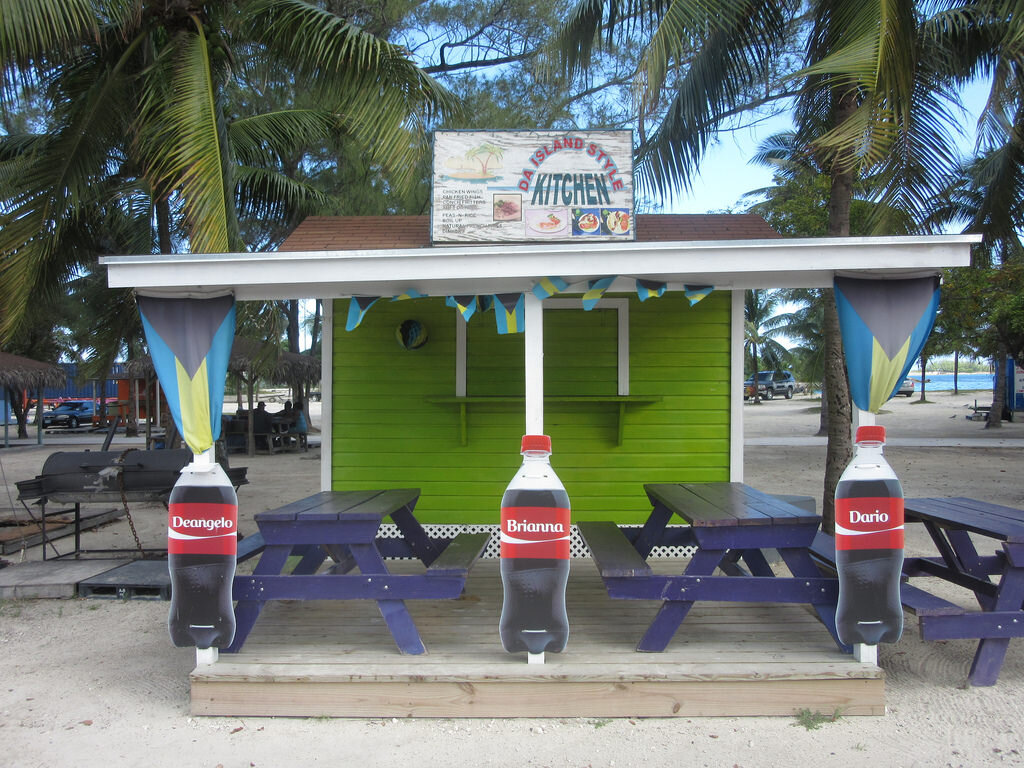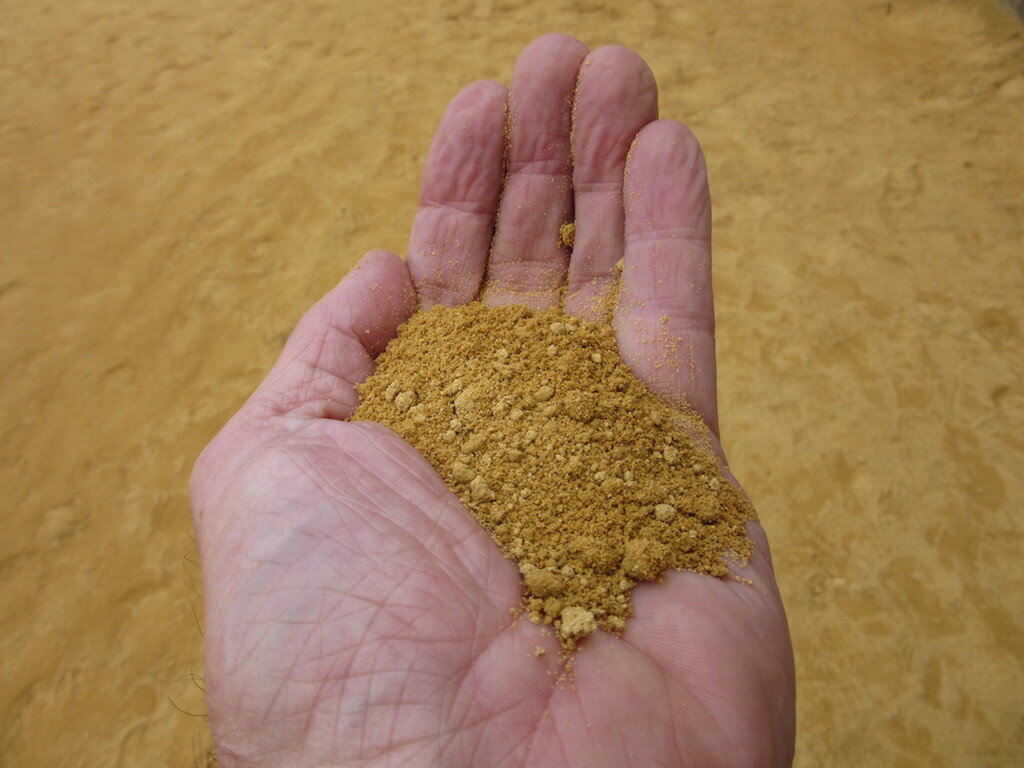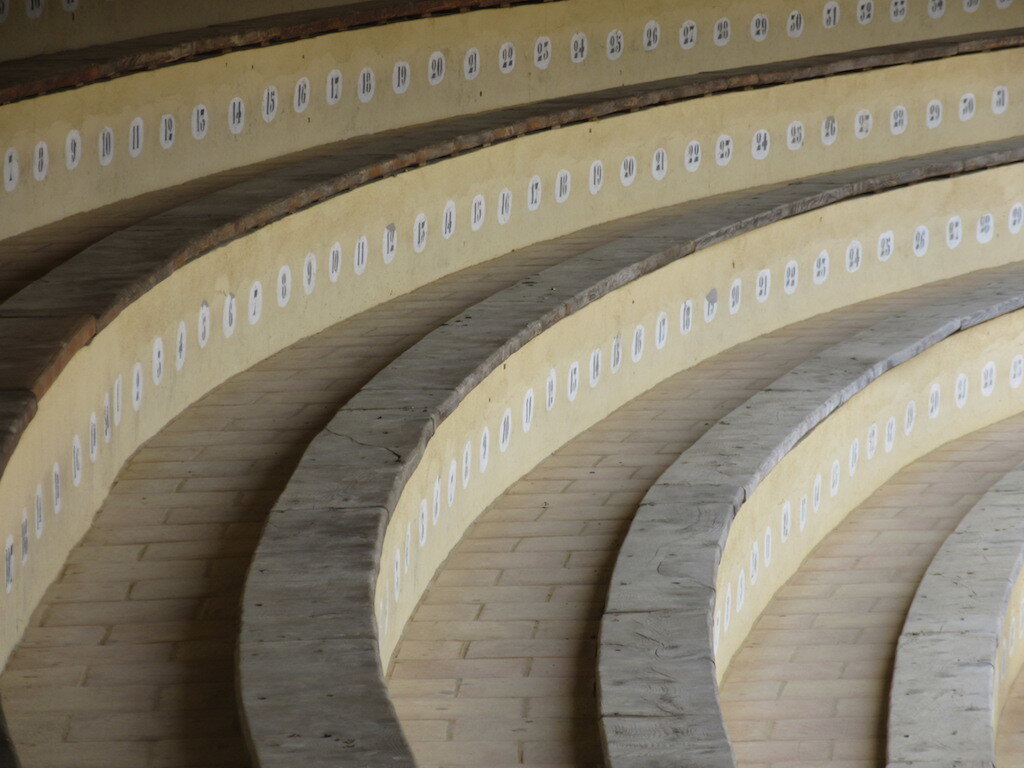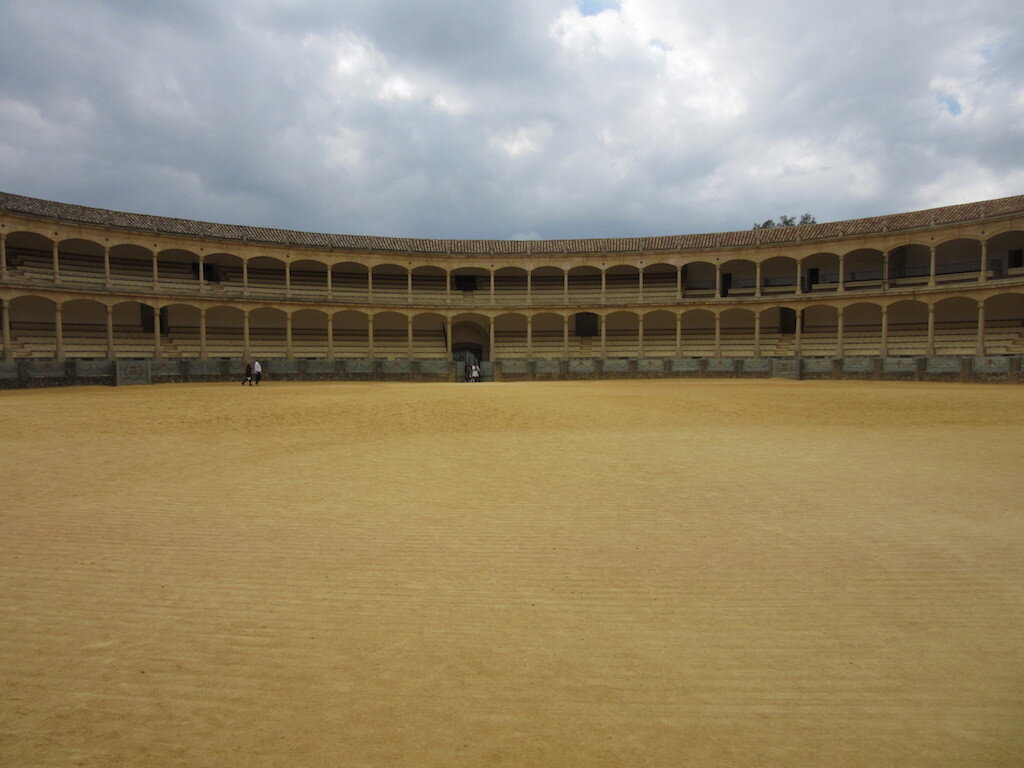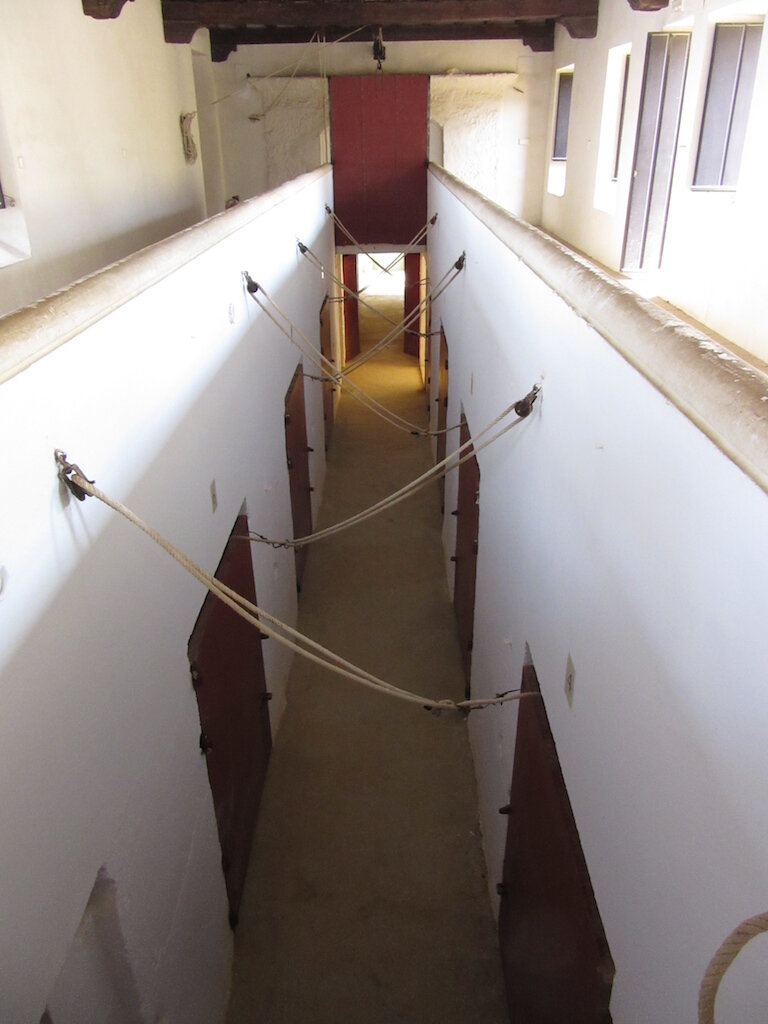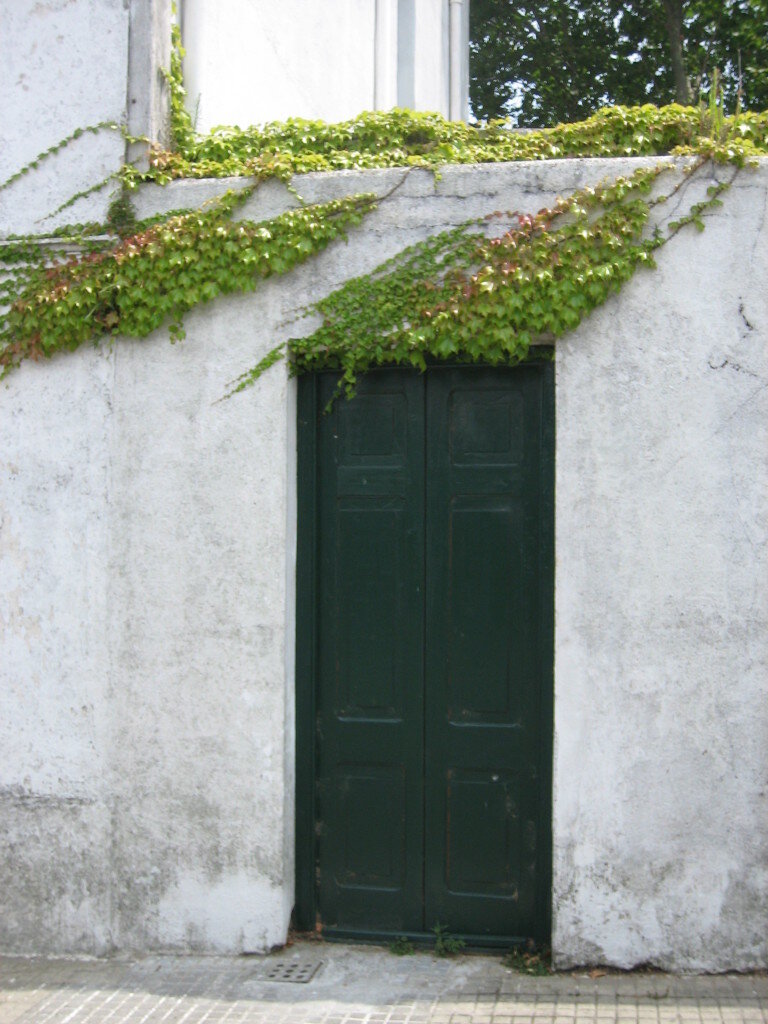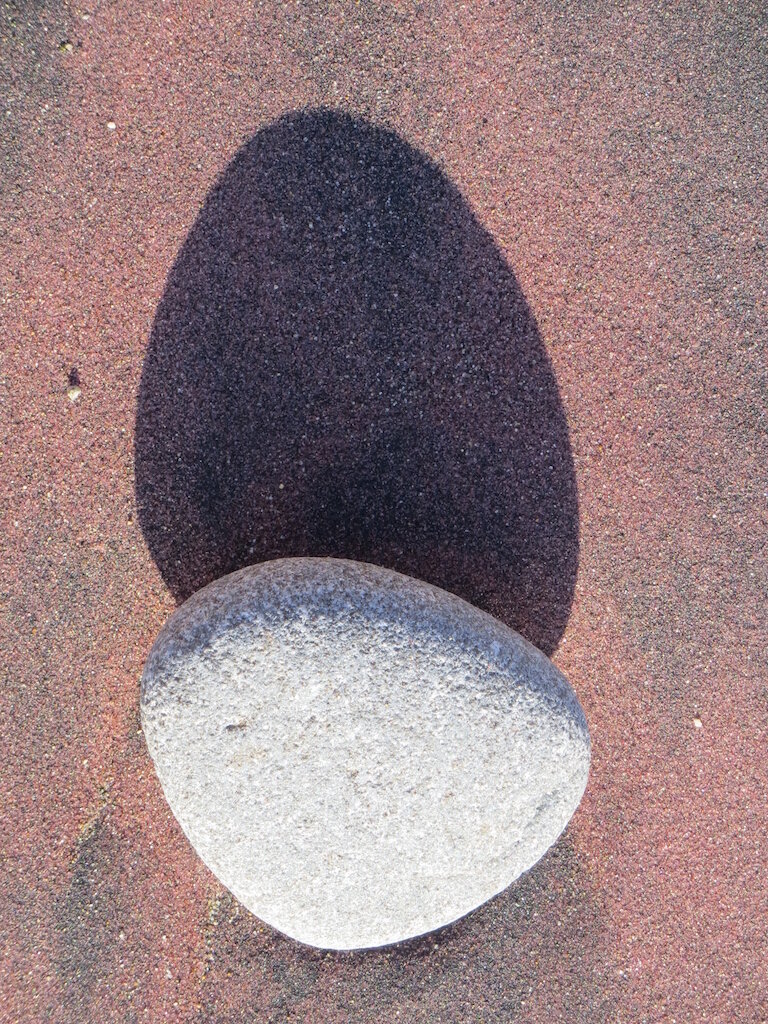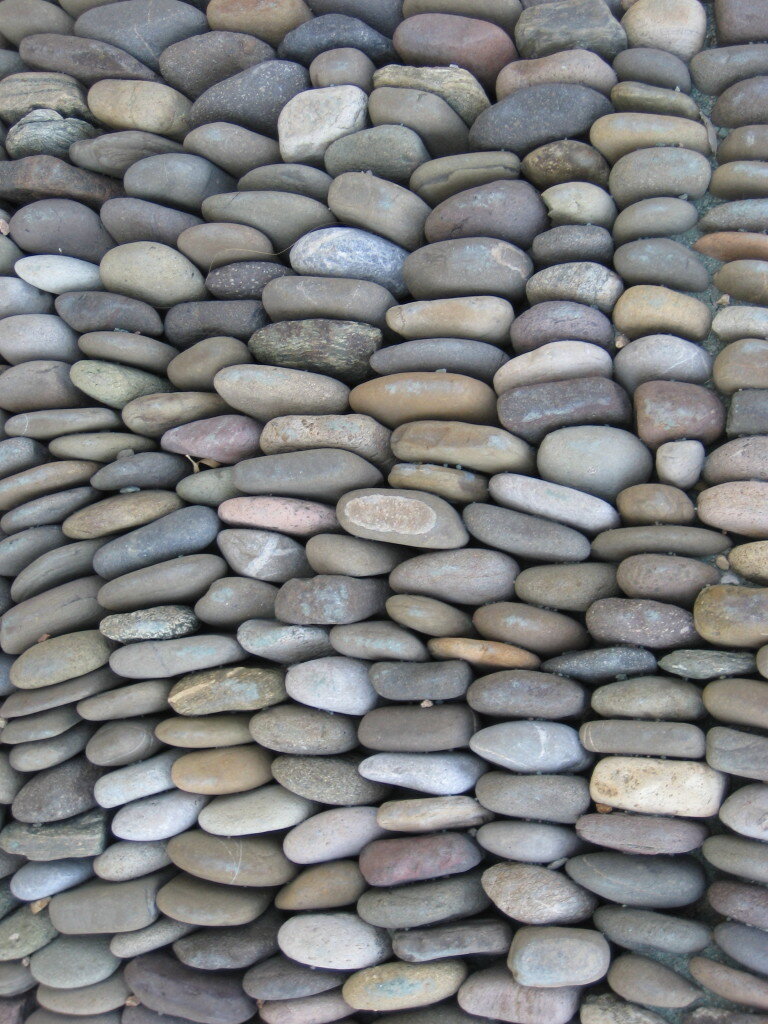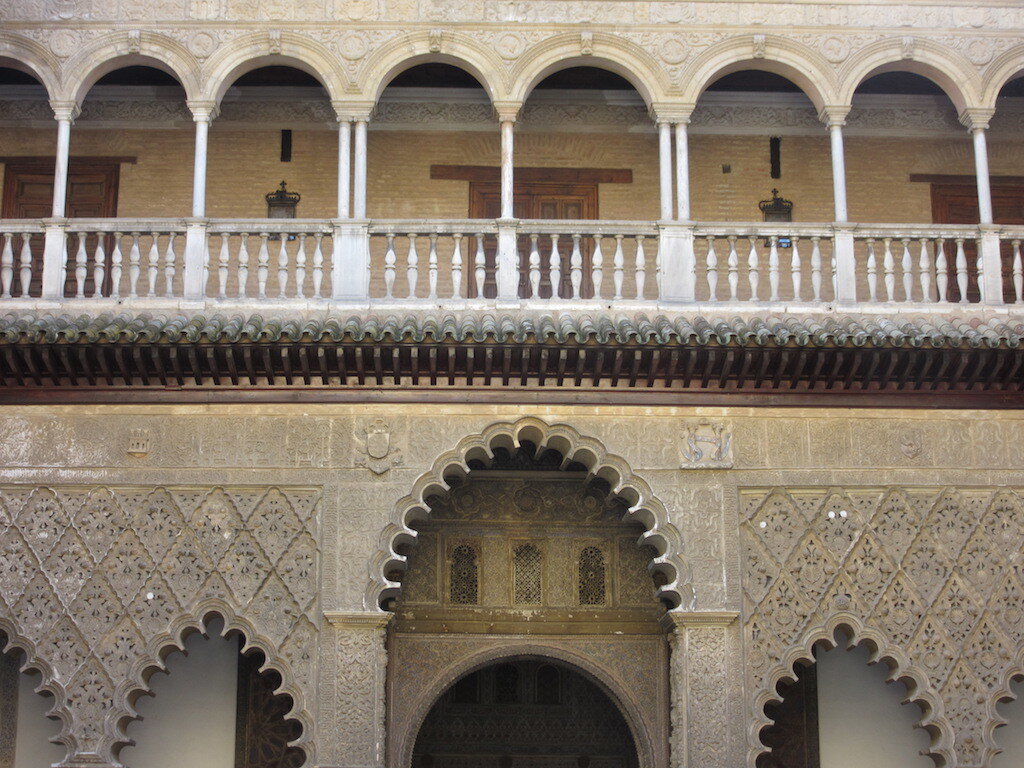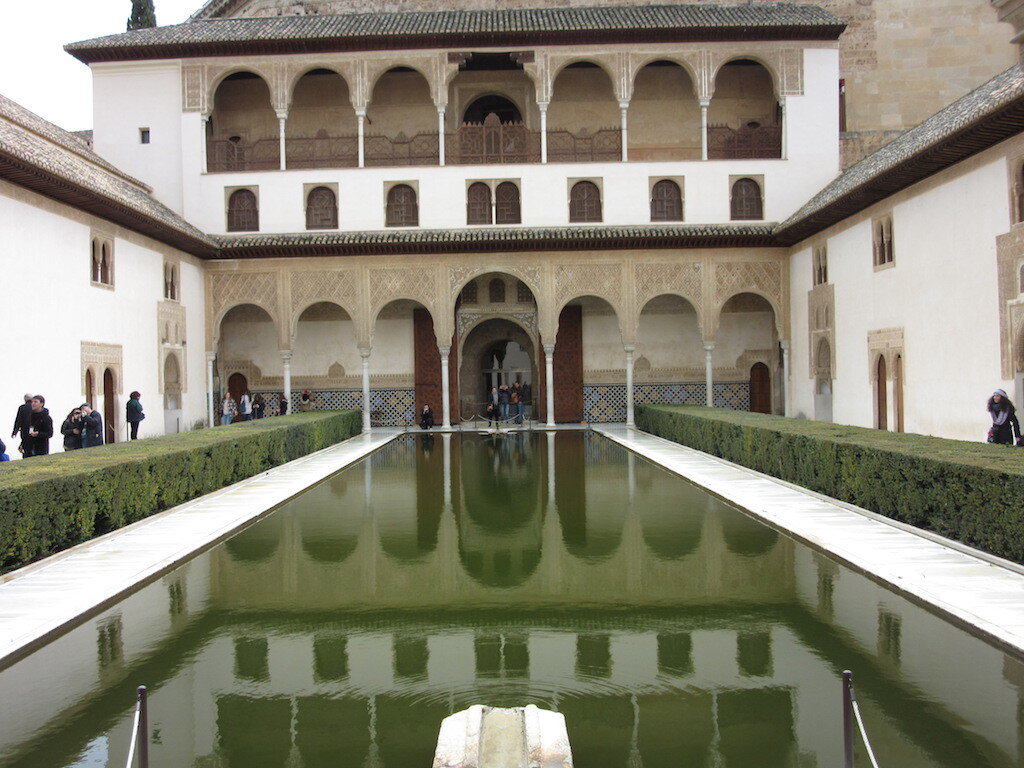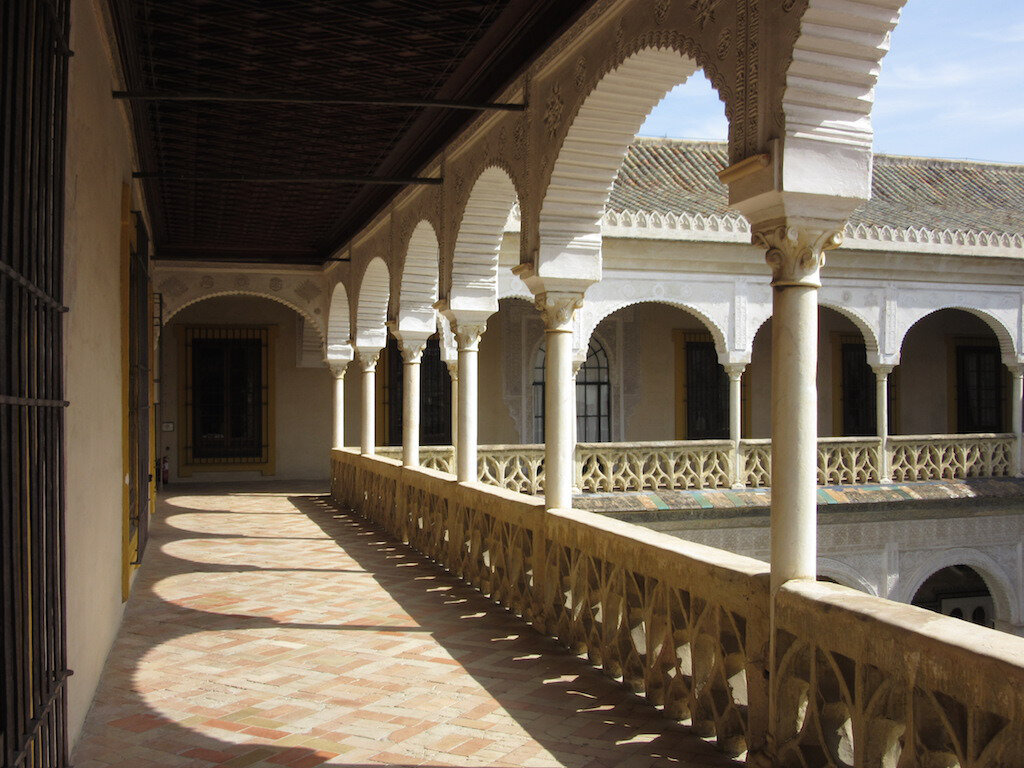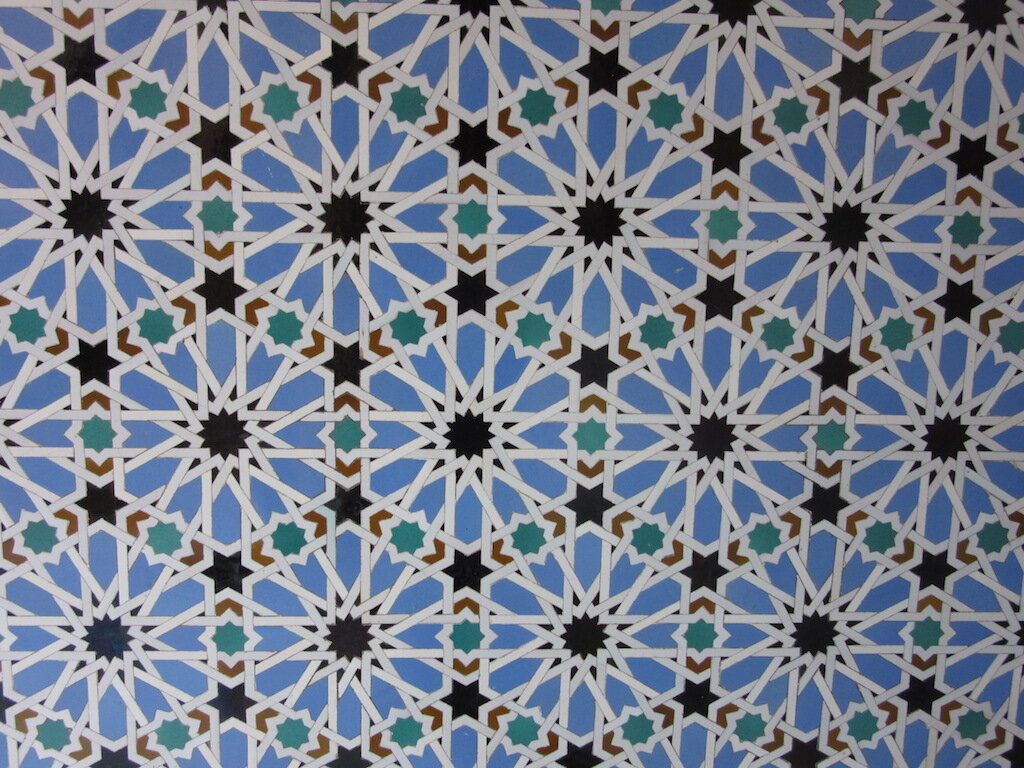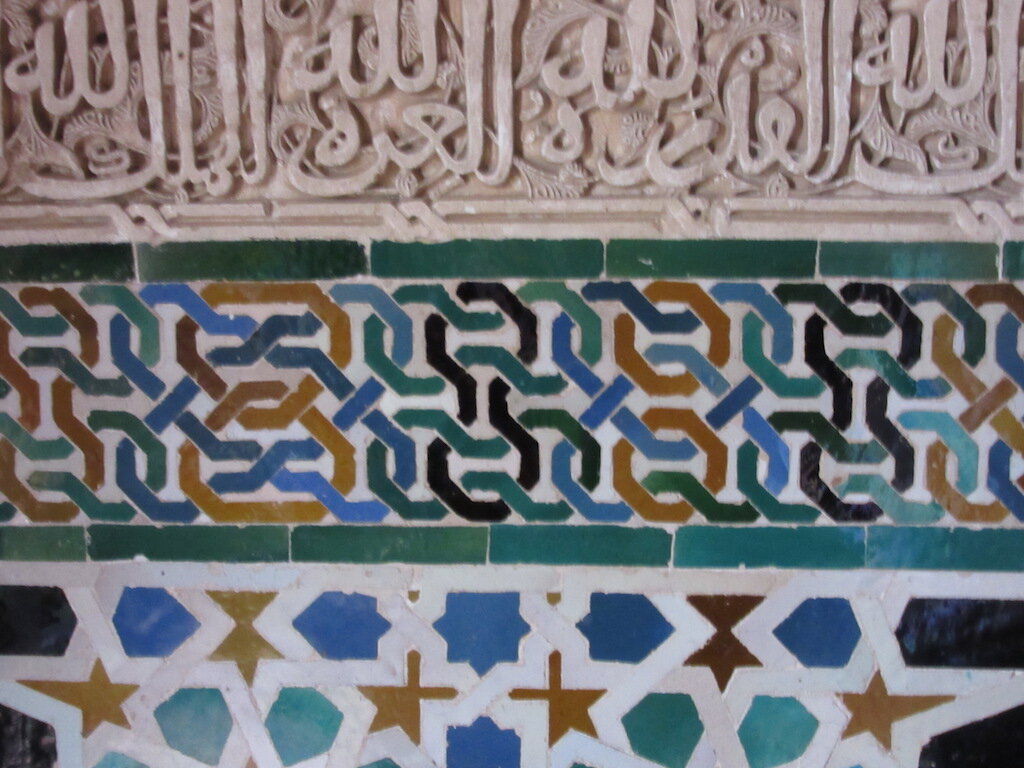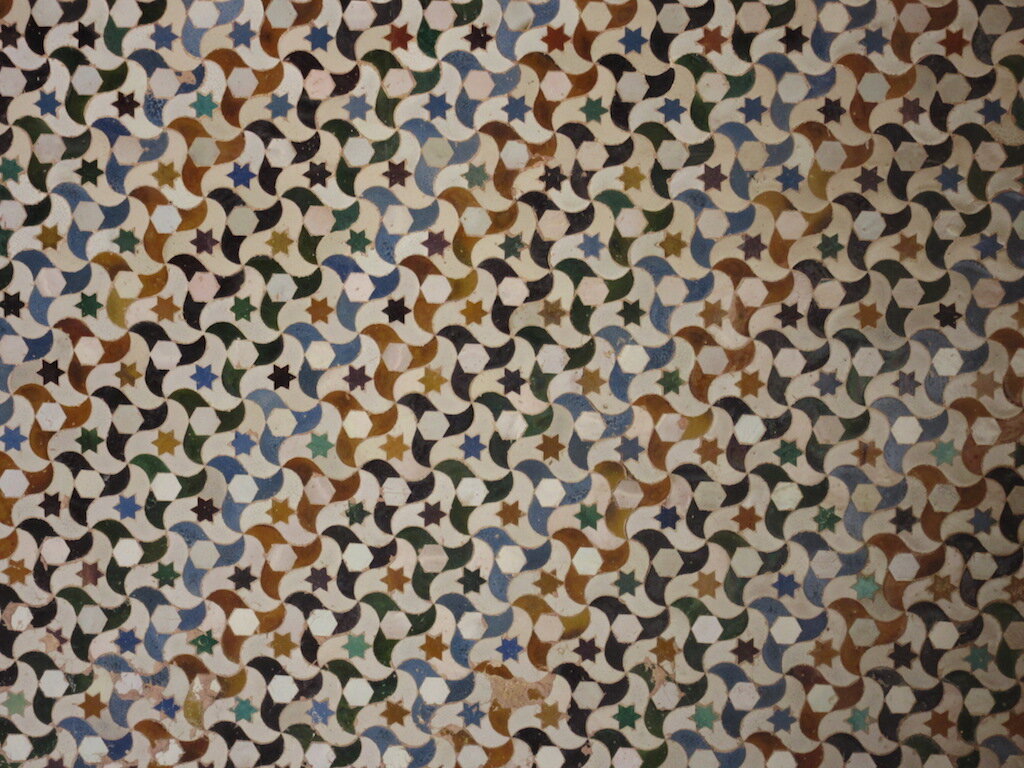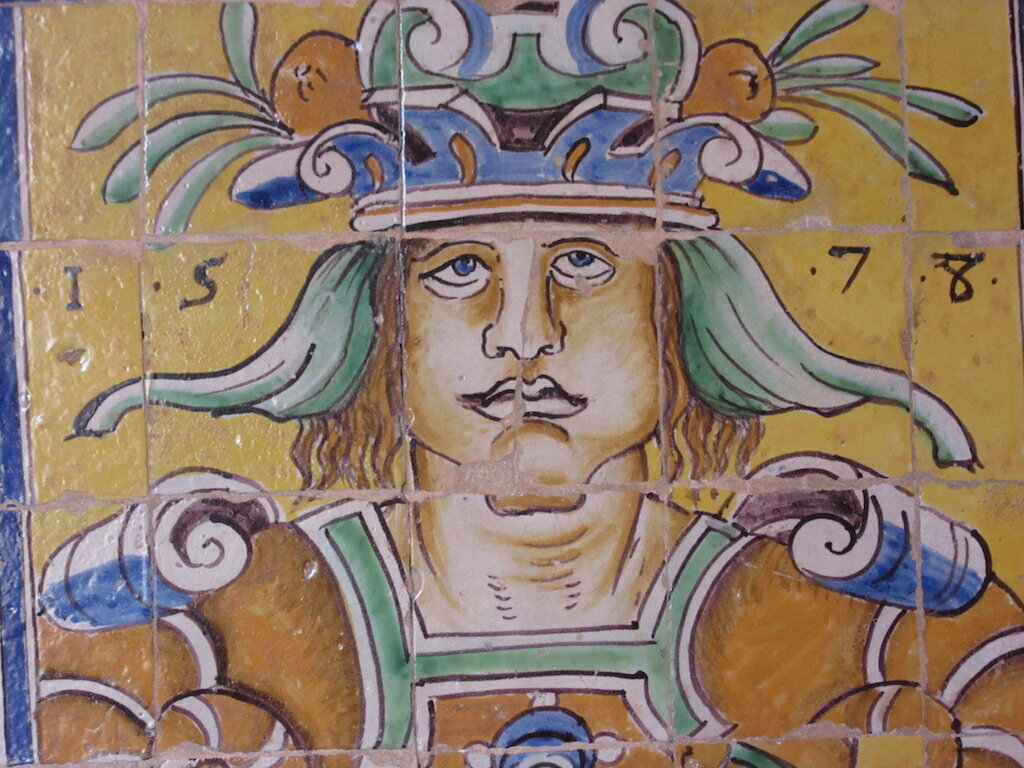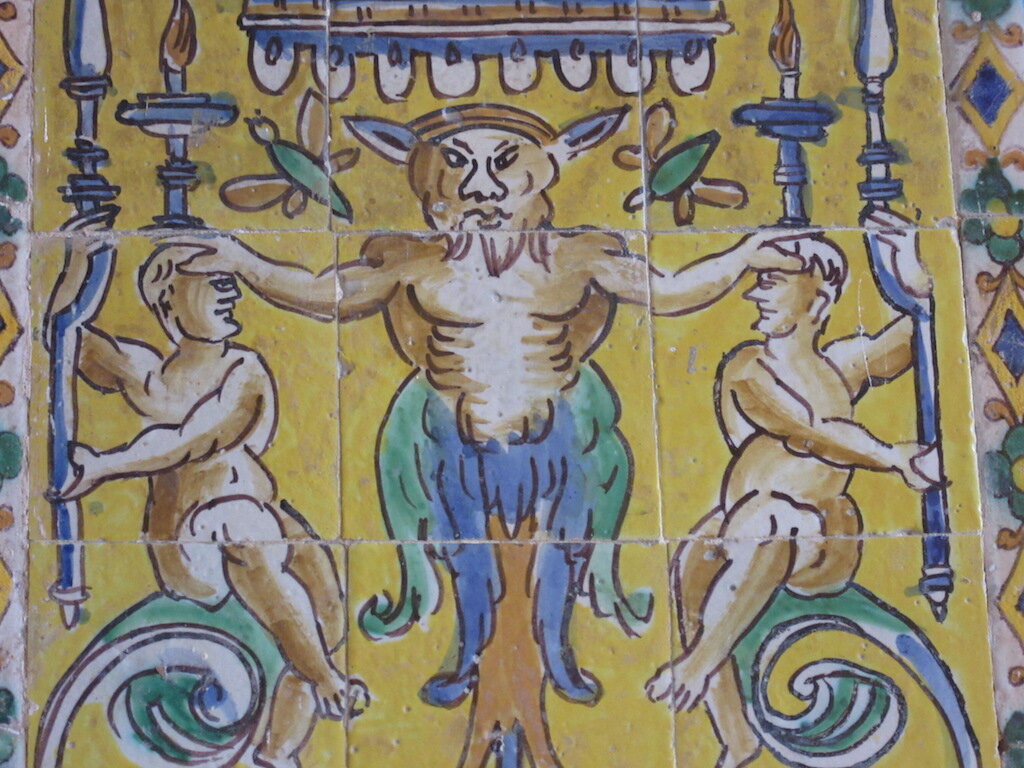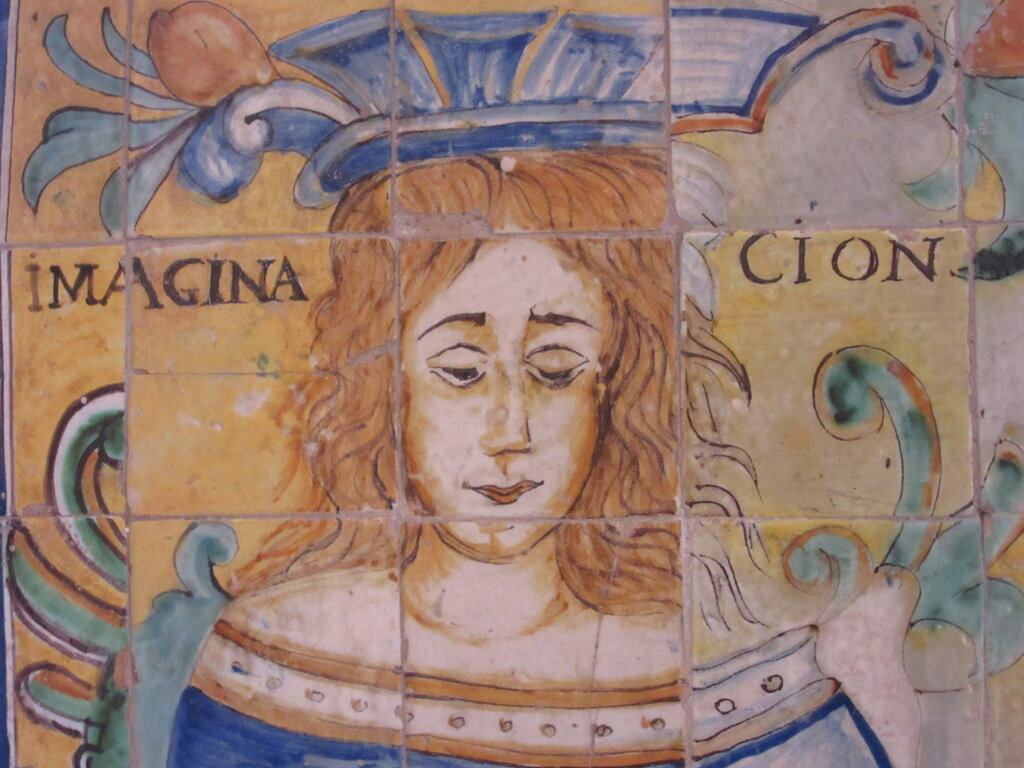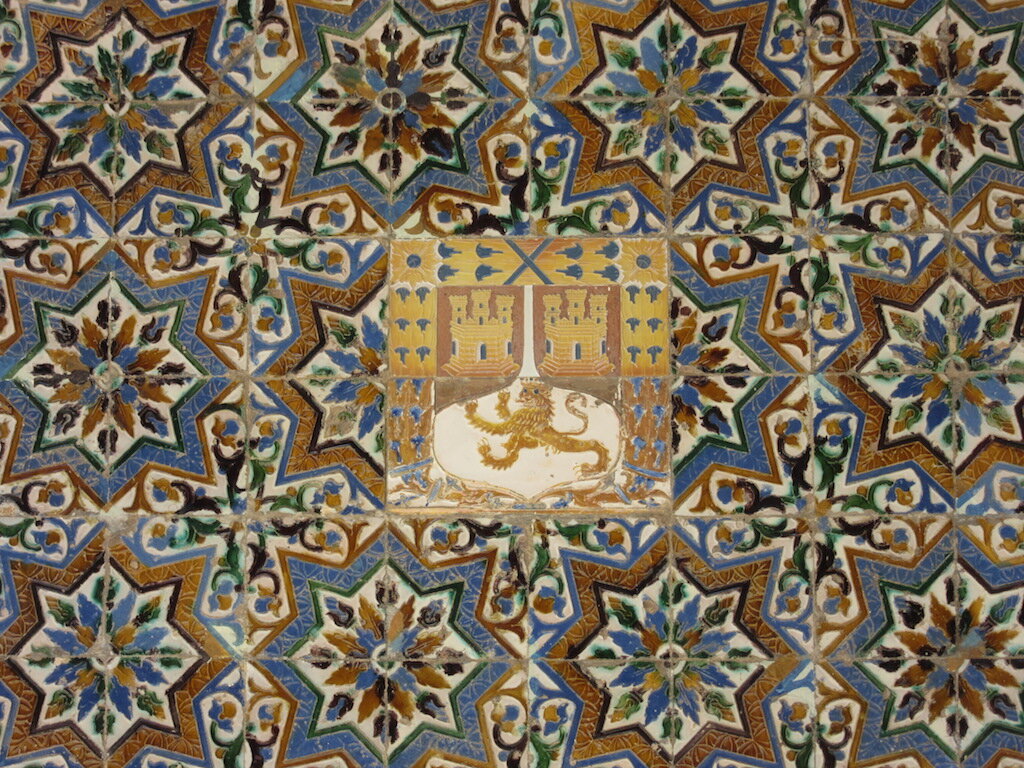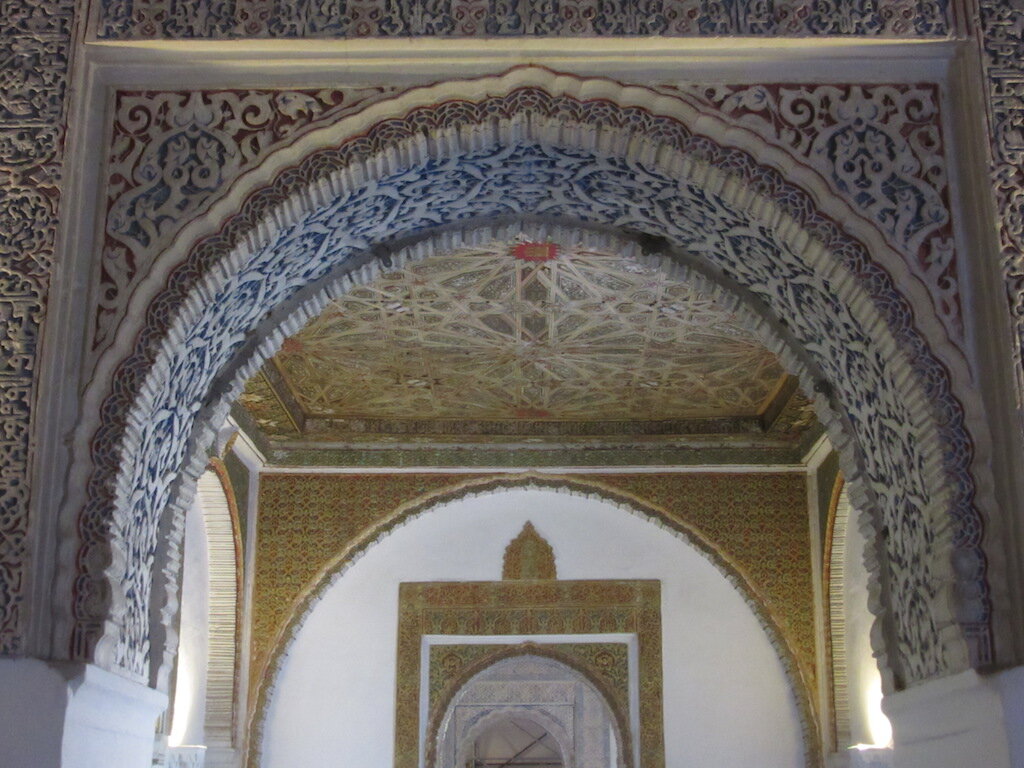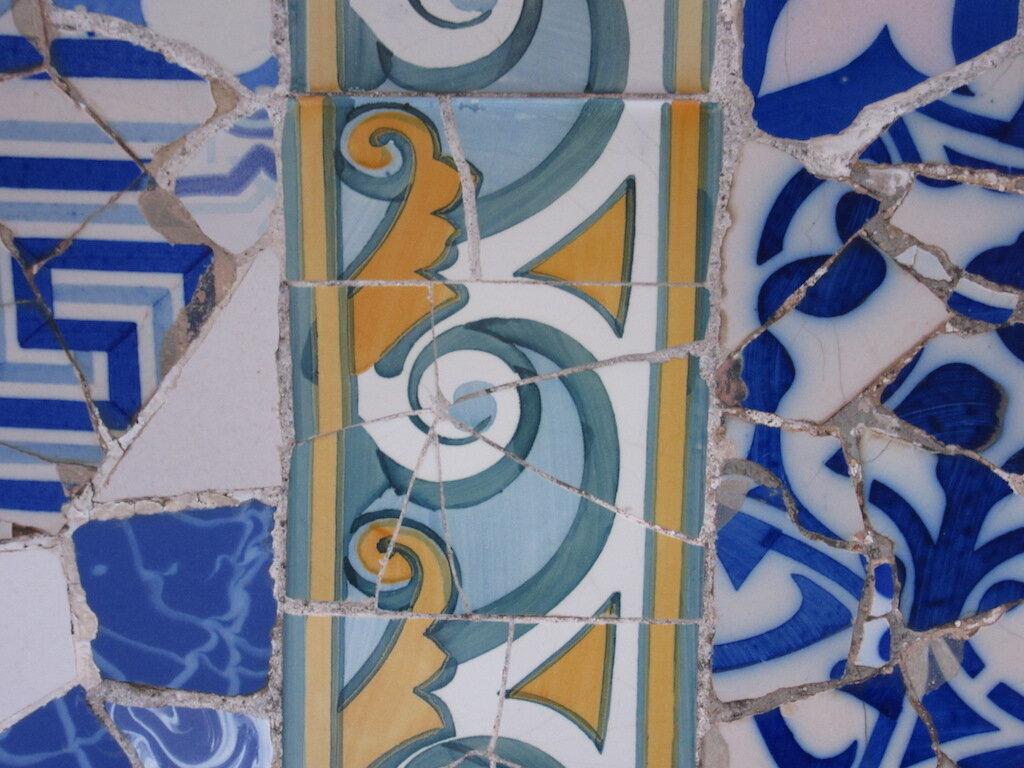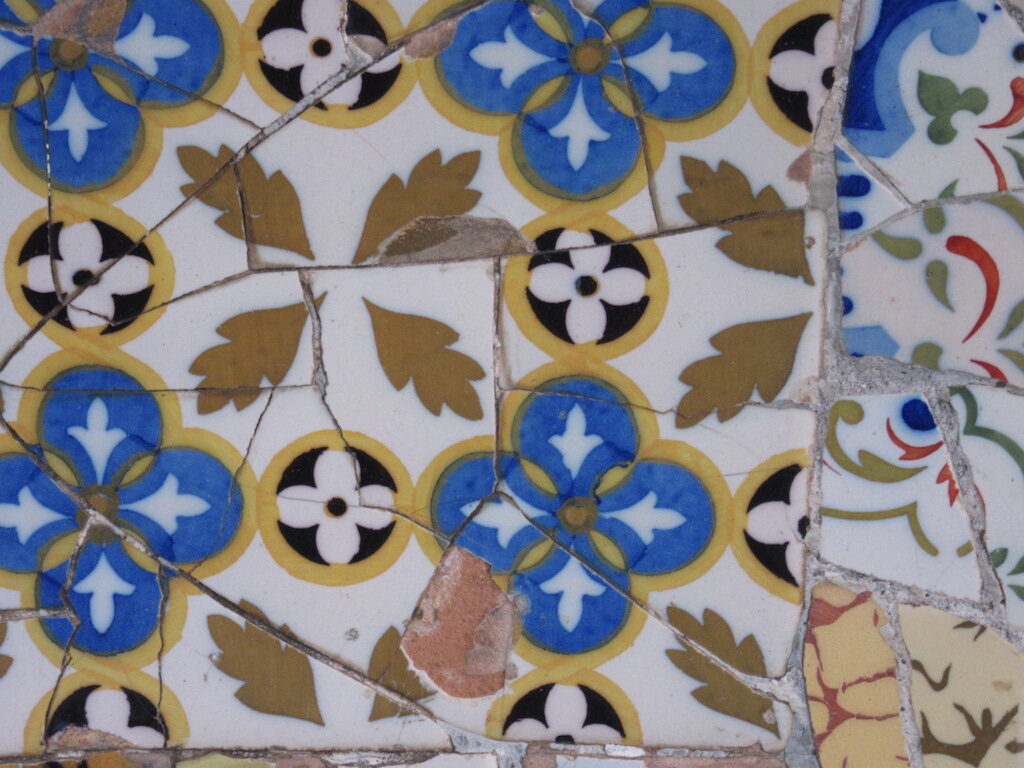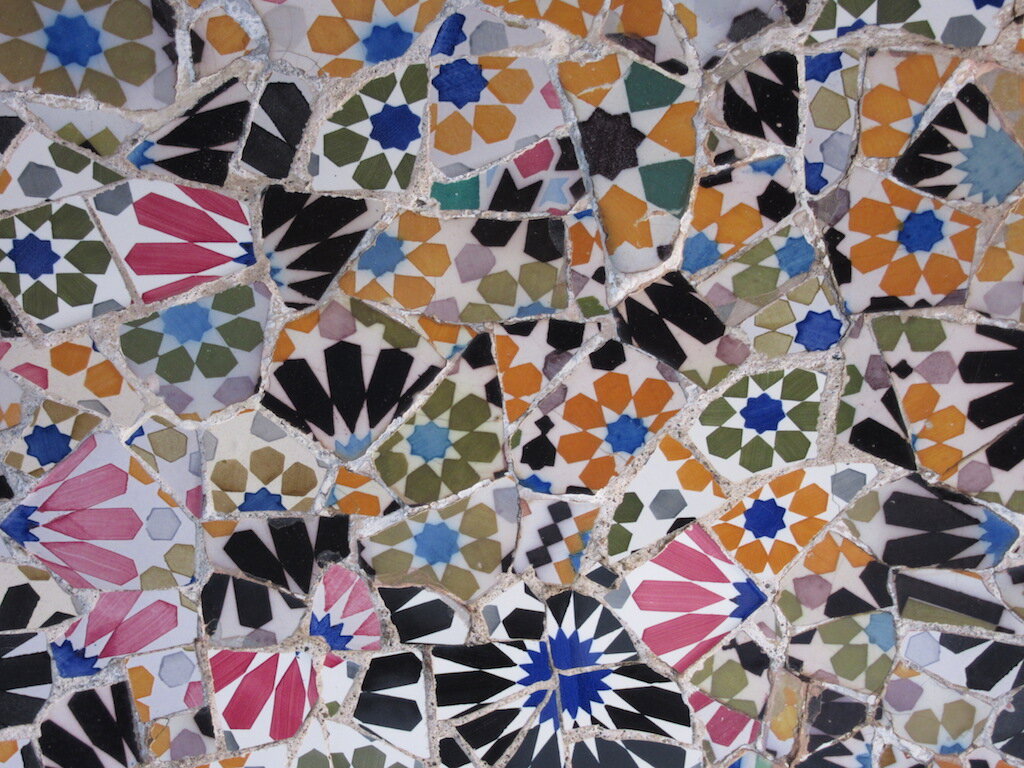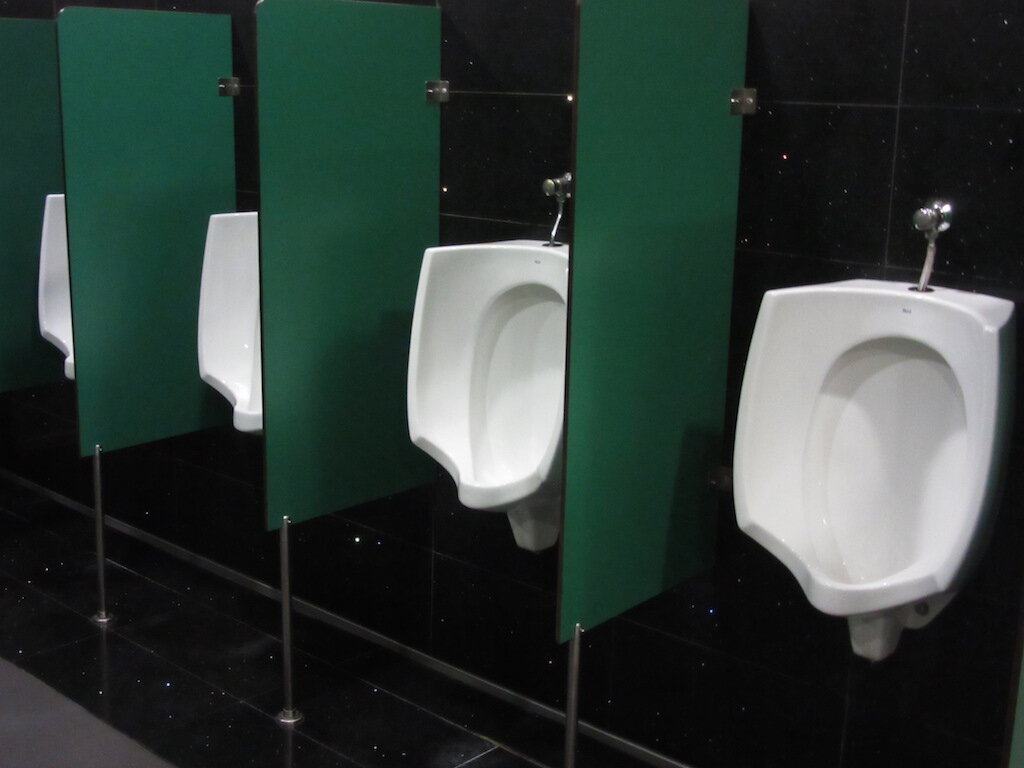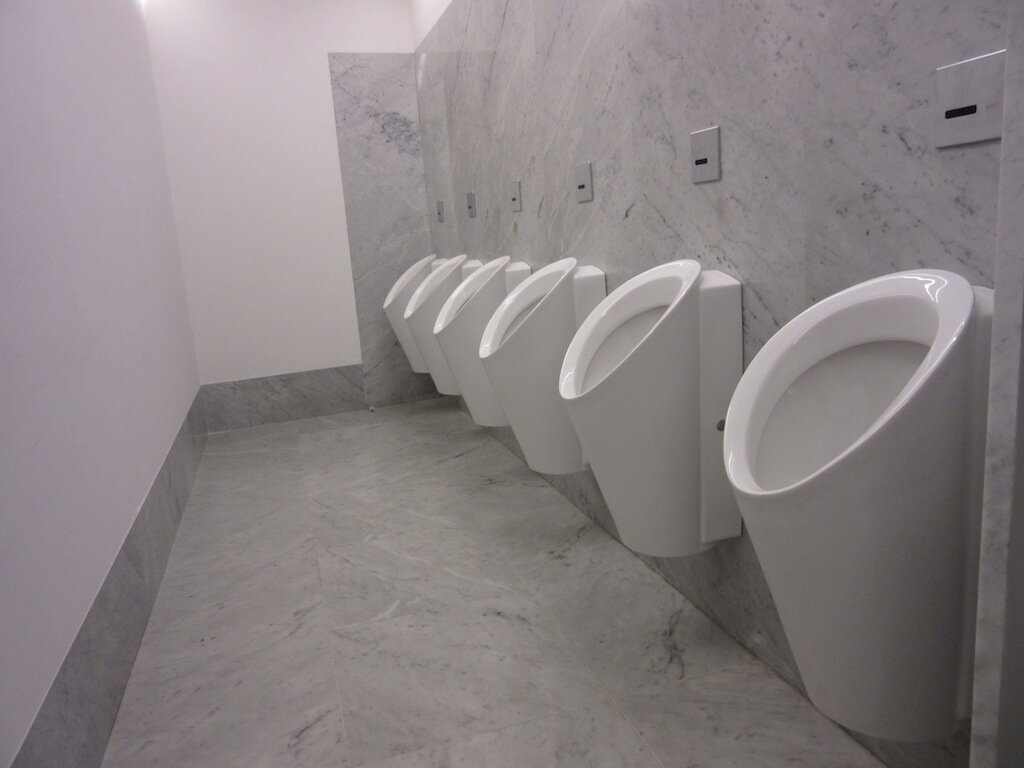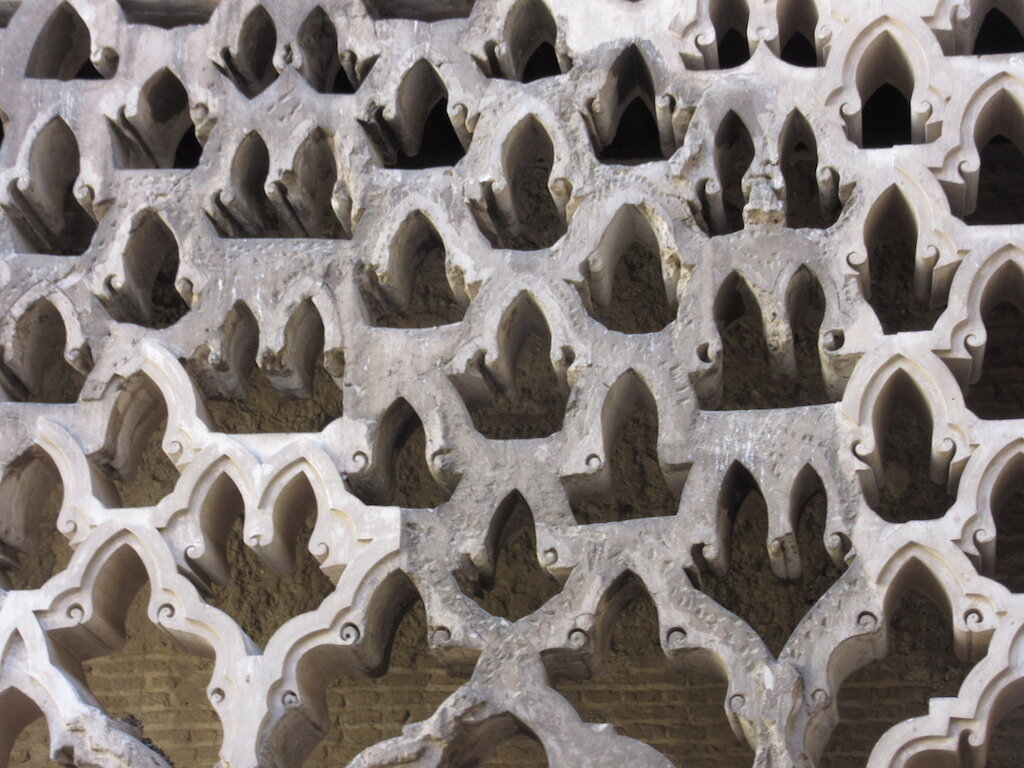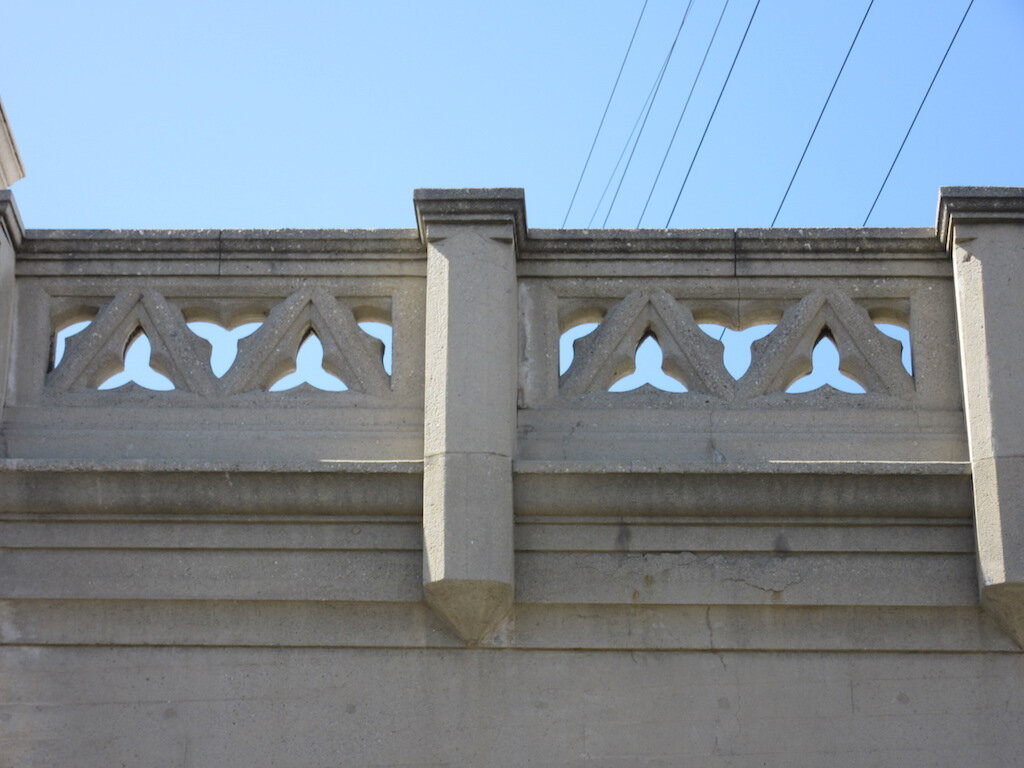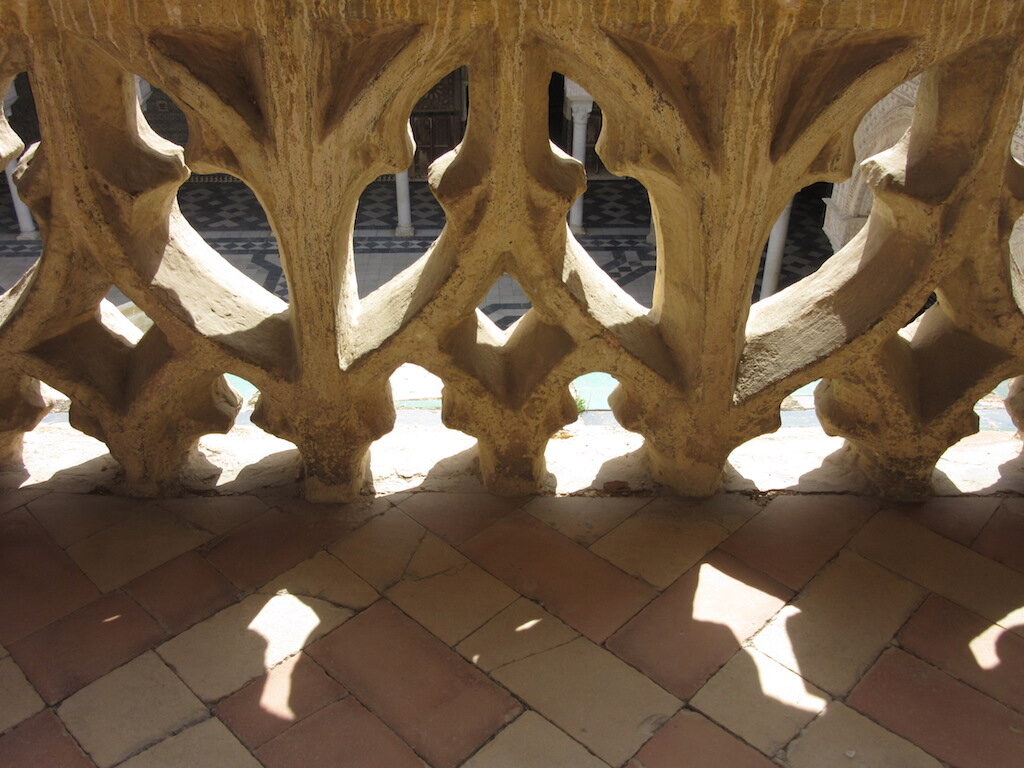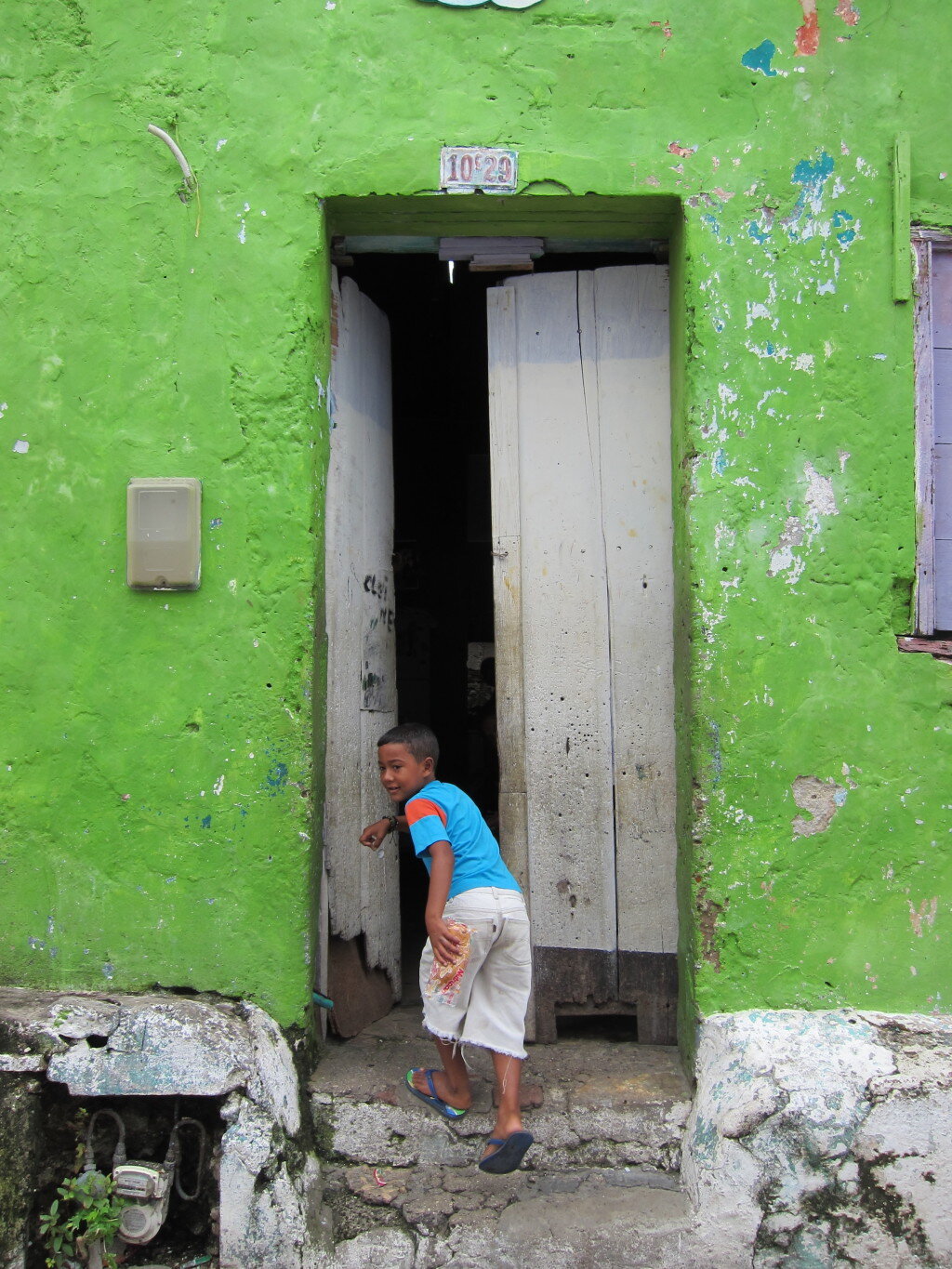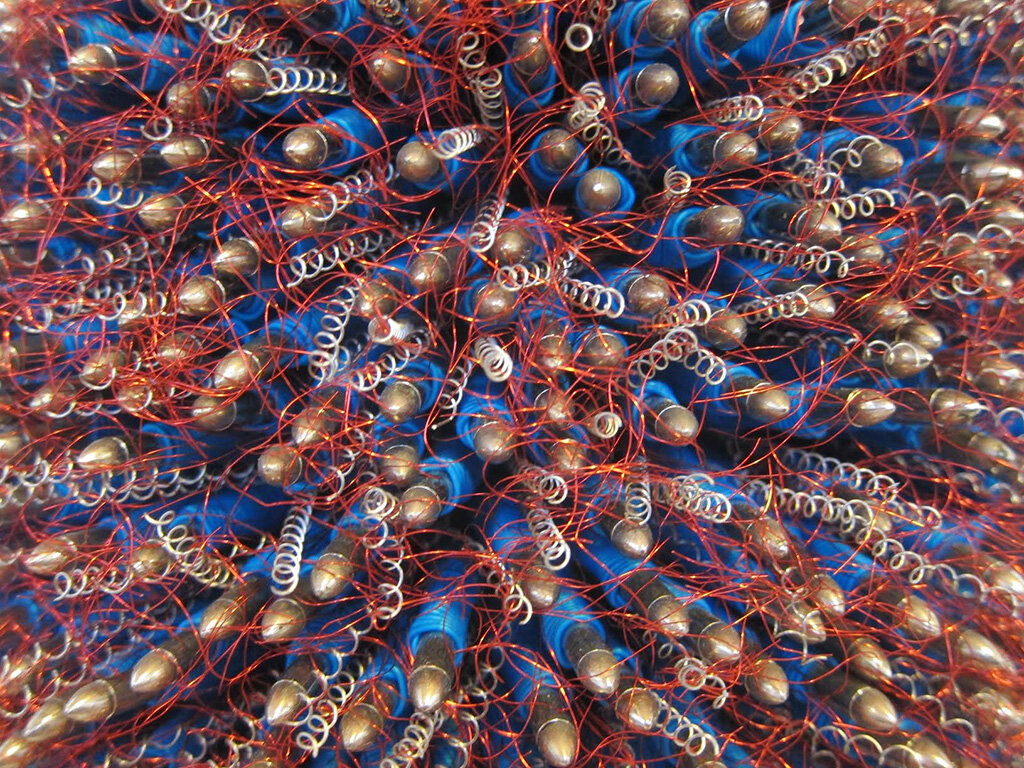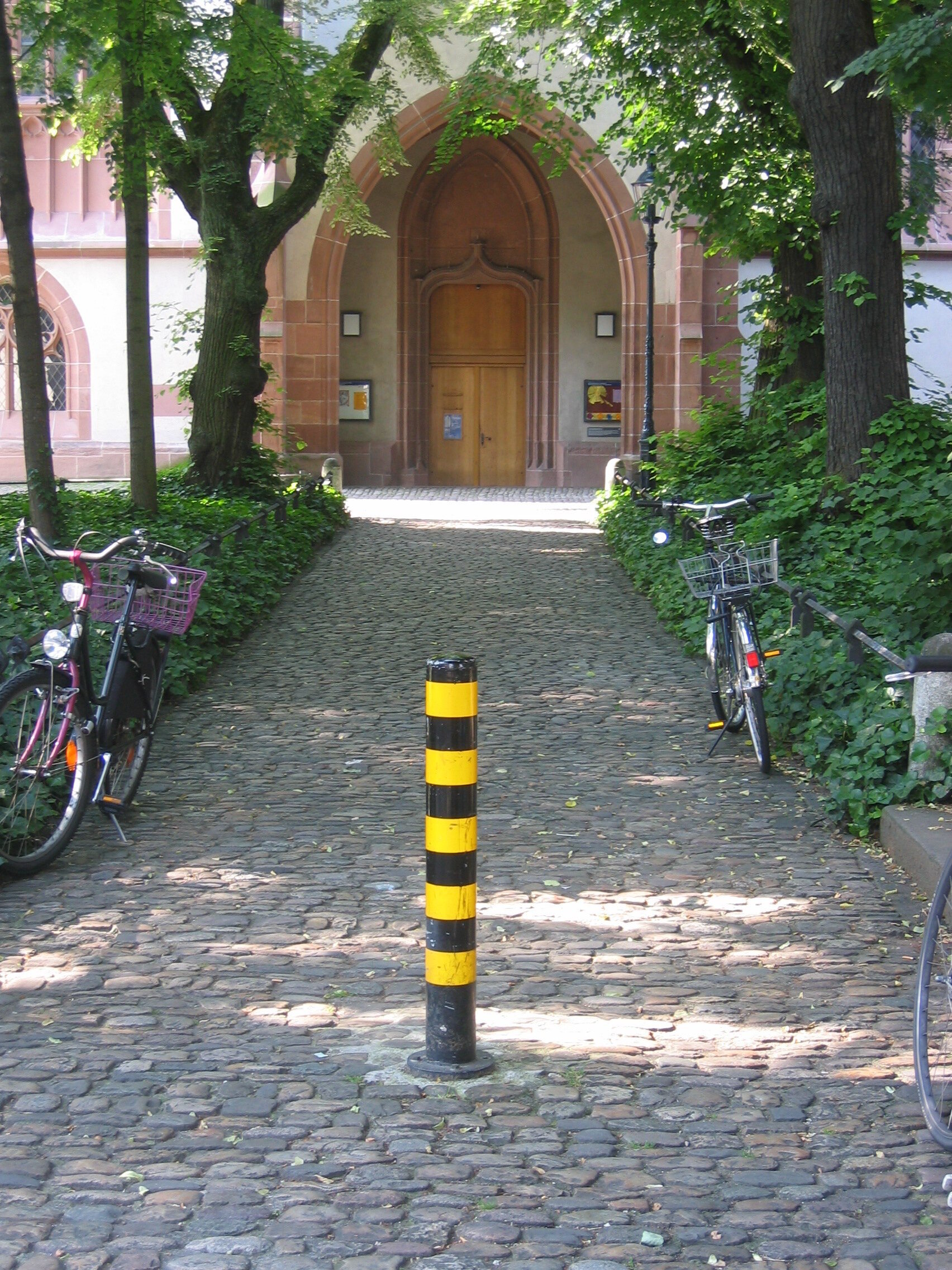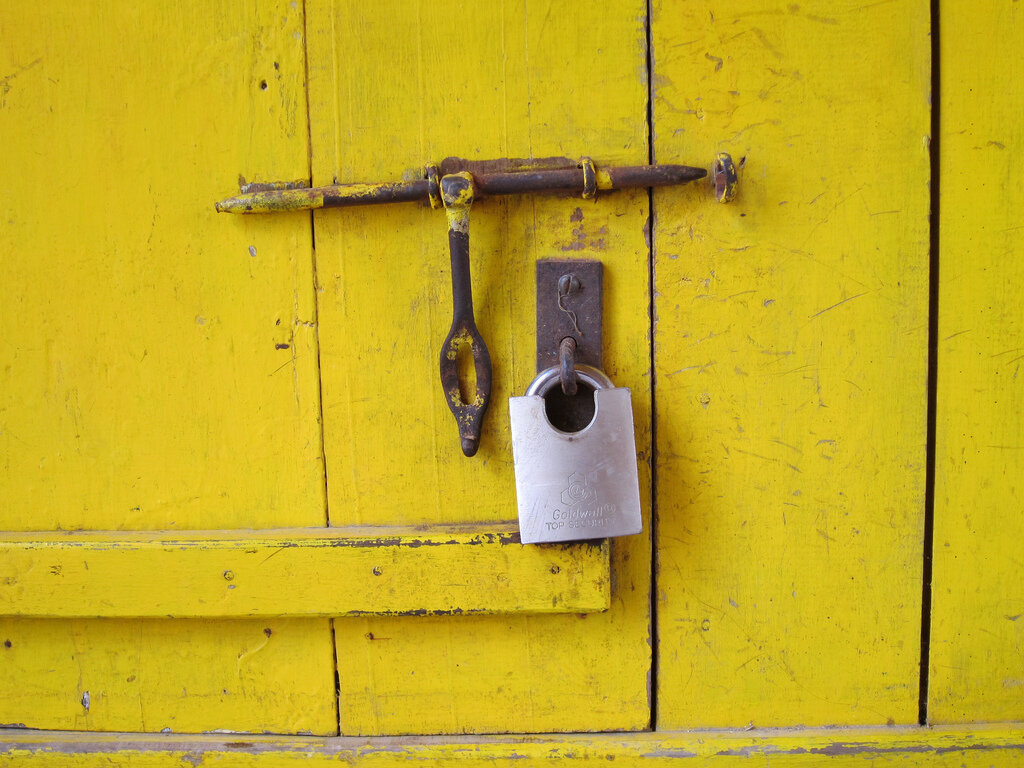Dario Calmese and the Institute of Black Imagination
It’s damned hard to be optimistic these days. Many of the progressive movements that shaped our values in the 20th century are being degraded and subordinated to a revengeful political agenda. Where do we go to find a new narrative—an inspiring form of protest? One action we will take is to spotlight and support designers who are asking us to look at the world through a new lens. Designer/artist Dario Calmese is one superb example. We’ve been working with Dario for a couple years through our Studio 50/50 project, and we recently visited his Studio 001 in Manhattan.
Rob Forbes
July 31st, 2025
It’s damned hard to be optimistic these days. Many of the progressive movements we grew up supporting —such as civil liberties, racial equality, public education, women’s rights and environmental stewardship—are being degraded and subordinated to a revengeful political agenda that a majority of Americans support. We see our democracy being transformed into an autocracy, and there is no compelling narrative or leadership from the left to confront this regressive backslide.
So where do we go for a dose of optimism? Where do we find a new narrative—an inspiring form of protest? One thing we will do is spotlight and support individuals who are role models for making a positive difference in our world today using their creative chops. Designer/artist Dario Calmese is a superb example.
Space 001
We’ve been working with Dario for a couple of years in our Studio 50/50 project. After visiting him in his Space 001 in Manhattan, we published a piece on him and his Institute for Black Imagination. The New York Times also recently did a feature on him.
Dario’s work is an example of how one individual can be effective in changing a narrative—in this case, how we view Black culture. His activism plays out on a uniquely creative high ground. For example, when Dario got the opportunity to do a cover photograph of Viola Davis in 2020 for Vanity Fair—being the first Black photographer to shoot a cover for the magazine—he described it like this: “For me, this cover is my protest. But not a protest in ‘Look at how bad you’ve been to me, and I’m angry and upset.’ Rather, it’s ‘I’m going to rewrite this narrative. I’m just going to take ownership of it.’”
You can support his Institute for Black Imagination in numerous ways—listen to Dario’s podcast, check out his website and consider purchasing some of his thoughtfully curated products. And if you find yourself in Manhattan, you would be silly not to visit his Space 001. Through any of these channels, you will be treated to his creative spirit and remarkable talent. It may help rekindle your belief in the human spirit and our better angels.
We need optimism—and probably imagination—in these challenging times. While our embedded politicians are either cowering in fear on the Right or frozen like deer in headlights on the Left, it is time to look elsewhere for inspiration and direction. Artists have historically been beacons of hope in difficult times like today, when sensibilities of intelligence, perception, curiosity, and compassion feel just out of reach.
Read our full article on Dario here, and please subscribe to the Studio 50/50 newsletter. We will continue to feature other inspirational individuals.
Krakow: Urban Design, Tyrannies and No Joke Elections
I ended up in Krakow, Poland quite by chance last October when my train trip to Warsaw from Vienna was aborted at the last minute due to a Covid situation. I had never visited Poland and knew little about Krakow really, nor did any of my friends. But I gleaned online that Krakow was a historic gem of a central European city, similar to Prague in that it had neither been bombed during WWII nor overrun by modern car infrastructure. My two-day blitz visit was particularly intense, provocative, and especially relevant on the eve of our election.
Rob Forbes
October 9th, 2024
I ended up in Krakow, Poland quite by chance last October when my train trip to Warsaw from Vienna was aborted at the last minute due to a Covid situation. I had never visited Poland and knew little about Krakow really, nor did any of my friends. But I gleaned online that Krakow was a historic gem of a central European city, similar to Prague in that it had neither been bombed during WWII nor overrun by modern car infrastructure. My two-day blitz visit was particularly intense, provocative, and especially relevant on the eve of our election.
Krakow would have been a more obvious place to visit in the 1500’s when it rivaled other great cities in Europe as a center for arts and science. It is fitting that Copernicus hails from this area. Now it is home to three major universities, including the Jagiellonian that dates back to 1364 and is one of the oldest universities in the world. Pride in education is cultural in Poland. It’s odd that all I recall hearing as a kid about Poles were jokes about them being slow-witted (the Polack locked his keys in the car – it took him three hours to get his family out). Where did that notion come from? And why did I know so little about Poland in general? I questioned my own education as I entered this city.
Walking from the train station, you enter Krakow’s walled perimeter and find yourself on elegant cobblestoned streets with stately neighborhoods, handsome medieval architecture, no exposed telephone or electrical lines, ubiquitous super-cute cafes and bookstores, a minimum of commercial branding and signage, no homeless people hanging out, many public artworks, the gorgeous Vistula river snaking through town, bike lanes, a modern affordable tram to get you anywhere cheaply, and an international youthful vibe. At the heart of the city is a magnificent plaza, the Glowny, among the great spaces of Europe. It defines and gives structure to the city’s urban character and personality with its historic buildings, open air cafes and around–the–clock activity. Krakow seems as idyllic an urban layout as I have ever experienced. It makes our modern car–centric cities devoid of humanistic public spaces seem like a serious cultural mistakes. We may be the slow-witted ones when it comes to city planning.
Tooling around town I came across a hip designer bookstore. I asked the two friendly staff about what must be seen in Krakow on a quick, two-day stay. “The Schindler Museum” they said in unison, so off I went. The public tram took me there for less than a dollar. The Oscar Schindler Enamel Factory museum documents the living situation of the largest Jewish community/ghetto in the world in its day, its beauty and intimacy, and its frightening destruction by the Third Reich in WWII. It was featured in Spielberg’s epic 1993 film Schindler’s List. Jewish history was forefront in my mind as I arrived in Krakow the week that the Hamas invasion of Israel on Oct 7th and the subsequent retaliation dominated the news.
This museum blew my mind as much as any museum I have ever visited – as much as Gehry’s Guggenheim Bilbao which I visited twenty years ago. Both museums connect us to their place powerfully, creatively, and both are stunning monuments of design with awesome visual displays. But this is where the similarities end. The Schindler Museum focuses on History and Terror not on Art. with sobering graphic details and exhibits.
More Jews (3 Million) lived in Poland than any other country in the world prior to the Holocaust. Krakow had been the cultural center with the largest urban population of Jews anywhere in its day (70,000). It may have been the greatest place to be Jewish in the world in the early 20th century, and the worst place for Jews later in 20th century when the Third Reich stormed into Poland in 1939. The speed and shock of the Nazi takeover of Krakow is hard to imagine. We learn that wicked change can occur overnight, not with a whimper but with a bang. The story is told in dramatic, disturbing visual details and words – this published letter being one example:
“Early morning on March 13 the ghetto was suddenly and unexpectedly surrounded by different formations of the SS and the Ukrainian policemen from the Ptaszów camp, known as 'the blacks'. At first none of us knew what was going to happen, it was only after 11 am that we were told that they would be gathering us within the next two hours and that we all had to take whatever we could with us, since the ghetto was to be liquidated and we were to be headed for the camp in Plaszów." — Abraham Mirowski, a doctor, aged 50
As Hitler took total autocratic control of Germany and started leaning East toward Poland, the Jews of Krakow had a choice: leave, or remain and see how bad it gets. The parallels to our situation in the US are blatant. With autocratic rumblings here at home, we can – with our action – avoid that stark choice and prevent the autocrat from seizing control. Or not, in which case we’ll be left with a similar (albeit less dire) dilemma. We do not have the specter of the concentration camps like Auschwitz (unless we count deportation camps for non–white immigrants). But where could we go if our country defaults to tyrranical rule supported by fifty million, mostly armed citizens? In that event, the US could go down as the best place to be an immigrant in the 20th century and the worst place to be an immigrant in the 21st century.
Hitler was intent on making Krakow the capital of the Nazi empire in eastern Europe and renaming the beautiful, historic Glowny “Adolf Hitler Plaza”. He wanted all its history and beauty to be identified with him and his people. The analogies to the right wing movement in the US are blatant here also. Only a failure of imagination could keep us from envisioning Times Square in New York getting a garish, golden rebranding. Is this any more far-fetched than the Insurrection, the repeal of women’s rights, the schemes to prevent legitimate voting?
One way to take action for our election: October 10th Event
I just received this link for an impressive October 10th event sent to me by Dan Nguyen-Tan whose work with the Asian American community is making a big difference in swing states for our election.
“I've been co-leading Asian Americans for Democracy. So far, we've distributed over $800,000 to Asian American-led grassroots groups in seven swing states to reach Asian American voters, especially in languages other than English.”
On October 10th, we're hosting our final online event, moderated by another AA4D co-leader Tamlyn Tomita, with other prominent Asian American creatives like David Henry Hwang, Freida Lee Mock, Jon Jon Briones, AJ Rafael, Amy HIll, Jeff Yang, and others. Please join us.
In our globalized world today mixing it up with Poland, Asia, and the US is fitting… we are all facing similar threats to democracy.
Seeking Kipp Stewart and the Good
I was recently asked to give a commemorative talk about a California designer, Kipp Stewart (1928–2022). I recalled him only vaguely from the ‘90s as a teak furniture designer whose work they carried at Summit. Googling Stewart revealed no Wiki page and very little written about him online, but there was a wide range of images of his work, mostly from the ‘50s and ‘60s. The breadth and understated elegance of his designs inspired me to do more digging.
Rob Forbes
May 30th, 2024
I was recently asked to give a commemorative talk about a California designer, Kipp Stewart (1928–2022). I recalled him only vaguely from the ‘90s as a teak furniture designer whose work they carried at Summit. Googling Stewart revealed no Wiki page and very little written about him online, but there was a wide range of images of his work, mostly from the ‘50s and ‘60s. The breadth and understated elegance of his designs inspired me to do more digging.
Stewart’s work spanned 60 years, beginning in the ‘50s in SoCal, where he was at the center of a vibrant mid-century movement. He collaborated with numerous manufacturers in the US and around the globe, started several design partnerships, and even worked in the Eames office for one year. He received numerous national and international awards and was selected for shows at major museums, including MOMA. Later, at Summit furniture in the ‘80s, he championed sustainability long before it became trendy. He was also a talented architect, known widely for the original iconic Ventana Inn in Big Sur. Here is an exceptionally talented and prolific designer who flourished in my hood in LA, at the height of American mid-century modernism. How could I not know about him?
I stumbled onto this photo of Kipp and his designer peers in SoCal in an LA Times magazine article from 1958.
My speculation is that the very concept of “design” was not yet defined for the public until decades after Stewart’s early career in SoCal in the 50’s and 60’s. There was neither a vocabulary nor a platform for design at this time—no design section in newspapers, no directory of practitioners, and certainly no Pinterest. Unless you were a design professional with access to private showrooms, or you were one of the few subscribers to the iconic Arts & Architecture magazine, modern furniture design, as such, was likely not on your radar.
Stewart stands out from most of his peers in that he was so prolific, a highly successful and productive designer for six decades. However, as my research revealed, he was known for being ludicrously reticent—he didn’t like to talk about his work. But this still doesn’t explain his anonymity. Why, for example, was he not even mentioned in LACMA’s comprehensive 2012 show, Living in a Modern Way: California Design 1930–1965?
One answer may be that Stewart didn’t fit easily into the modernist sensibility and vision. He wasn’t interested in abandoning tradition; in fact he started a company in the ‘60s called The Shaker Connection with this past-looking mission: “We want Americans to remember that they are only two generations removed from some of the finest designer craftsmen in recent history.”
Photos: Kip Stewart pieces from the 60’s in SoCal
But the real answer might be that he just didn’t particularly care about publicity and may have even disdained it. Let me back this up with a provocative quote by Stewart that has stuck with me as much as his work has:
“I have no interest in style or being unique or clever or new.
To me, all that counts is what is good.”
Who determines what is good? It’s a tricky thing to define or measure. To be sure, it’s more difficult to achieve Good than it is New or Unique. But it seems most designers conflate newness and quality—if it’s not new, it can’t be good. For a super-talented designer like Stewart to have good as his end goal, to not be concerned whether a work will be considered new, is in itself unique. It’s much easier for modern journalists and critics to write about a work that’s new; it’s far more challenging to explain why something is “good.” Maybe that’s why Stewart’s legacy is peculiarly difficult to unearth.
Photos: Kip Stewart pieces from the 70’s at Summit
The Eames had a clever and modern definition of good design: they characterized it as “the best for the most for the least” and executed this strategy with, for example, their iconic plywood chairs. While Kipp Stewart worked in the Eames office for a year in the ‘60s, his sense of “good” had no such social mission, but perhaps their modesty rubbed off on him. It’s certainly refreshing to consider—in our modern world where newness is king and where influencers grab the spotlight—that perhaps good is good enough?
Baja Road Trip
The Maine winter had convinced a couple of friends to join me on my quest to find my ‘95 Toyota 4 Runner which was residing somewhere in Todos Santos, a small coastal town way down the Baja Peninsula. The car had been sheltering in place with Santiago, a Mexican architect pal, since the pandemic curtain had come down on all things travel. He loved the car and wanted to buy it, so he was understandably a bit disappointed when I told him I had promised the car to my goddaughter as a college graduation present (if she could make it through Princeton, she could learn to drive a stick shift, I hoped). Santiago had agreed to get the car tuned and prepped at my expense before we arrived.
Rob Forbes | 6-5-2023
The Maine winter had convinced a couple of friends to join me on my quest to find my ‘95 Toyota 4 Runner which was residing somewhere in Todos Santos, a small coastal town way down the Baja Peninsula. The car had been sheltering in place with Santiago, a Mexican architect pal, since the pandemic curtain had come down on all things travel. He loved the car and wanted to buy it, so he was understandably a bit disappointed when I told him I had promised the car to my goddaughter as a college graduation present (if she could make it through Princeton, she could learn to drive a stick shift, I hoped). Santiago had agreed to get the car tuned and prepped at my expense before we arrived.
His sparse text advised us to pick the car up from a mechanic named Victor whose garage was across the street from the “Mercado del Sol”. An address would have been nice, but there are no street addresses in Todos Santos. We found the Mercado, but there was no garage across the street, so we were reduced to driving around and attempting to find it visually. A few bumpy dirt roads later, there she was in an alley across from a sort of open-air garage.
We got the key from a friendly guy after ponying up $1000 (which is a lot for a tune-up anywhere). I was in no position to negotiate, however – Santiago had arranged the tune-up with Victor, who had left for the day, and my Spanish was/is pathetic. I was just happy that they took my VISA card as we were out of cash.
The car had not been cleaned (no big deal), but the engine fired up immediately. Yay. The sound of that venerable engine and the fact that all my maps were still in the side pockets, untouched, gave me a fleeting feeling of confidence. But the gas gauge was below empty, and the dodgy clutch would not allow me to get it into first gear. So we lugged through the bumpy town roads in second, rolling through stop signs, headed (I hoped) toward the one Pemex gas station I thought I remembered.
It dawned on me (perhaps a bit tardily) how profoundly unprepared I was for the impending 1000 mile road trip back up to San Francisco through an uninhabited landscape where you cannot drive at night for fear of drug gangs, in a 30 year-old vehicle that I had not driven in three years.
After filling up, I asked John to see he could get it to shift. He’s a bike and motorcycle dude, clever with mechanics. He got it into first, and we drove the ten miles back to our hotel without incident. The ‘plan’ was to leave the next morning and drive 300 miles north to Loreto, a charming, historic port town on the Sea of Cortez where I had stayed five years before when I originally drove the car down from San Francisco.
The car handled like a champ on the first day, though the AC was shot and Beth (who was in the fetal position in the rear seat, suffering from food poisoning) didn’t altogether appreciate the bouncy suspension and full-throated engine. But we got to Loreto in one piece and now had only 700 miles left to the border! I felt like we had a fighting chance to make it home, and – to commemorate that feeling – I got my first decent night’s sleep after three previous nights of insomnia.
Baja has extraordinary beauty, full of dramatic contrasts: deserts, oases, endless fields of cacti, rocky moonscapes, the glassy Sea of Cortes. You feel like you are passing through an older permanent geology, a landscape content to be neglected by human beings.
A driver can be seduced into a light trance by the dreamy landscape and hum of the engine – until a semi, growing larger and larger, finally roars by on the shoulderless two-lane highway. Gas stations are spaced erratically, sometimes 100 plus miles apart, and there is no signage advising you about the next one. There is no signage at all really, and we forget what a luxury a little graphic encouragement can be.
Besides watching the landscape unfurl, we saw a few fellow travelers: mostly older Canadians in vans, younger people on motorcycles, and locals in beaters. It was Road Warrior pleasant solitude. Unable to book hotels in advance, we had to arrive at our destination before nightfall and get lucky. Accommodations were sparse and sketchy, and I was happy to have my own pillow.
On day three, halfway to the border, we spent our sketchiest night in the other worldly Mexican salt capital Guerrero Negro. Happy to flee the next morning, we hit an unmarked pothole doing 70. It was a collision-like impact, and we felt lucky to have a solid truck with oversized tires.
The jolt must have affected the vintage Alpine CD Player nestled in the dashboard that we had written off as dead, and Bob Dylan’s Blowing in the Wind came on. Unsolicited, but welcome. I must have left the CD in there three years ago.
Our last night was in San Felipe, a curious fishing village on the Sea of Cortez with a preppy rowing club and a beach sprinkled with used nets, plastic bottles, and unidentifiable dried sea creatures. San Felipe is only a day‘s drive from the border and is accessible to Americans – notably college students looking to drink and party. It was a little sad to be back in ‘civilization’ with its shops selling NFL caps, menus in English, goofy Yoga signage.
We used our last pesos for our final and best meal at a tiny truckers’ café just south of Mexicali. The menu had no prices. The place was run by four women whose ages spanned about 80 years. Their spirit and laughter were reminders of the general rule of thumb with Mexicans that we had been noticing for the entire trip – they are about 65% more content than most Americans.
This Baja road trip has had an enduring effect on my mental well-being. A month later I still feel lighter, more optimistic about life in general. Why? Maybe four days away from news media, immersed in a beautiful, surreal environment. Maybe quality time with good friends. Maybe the relaxed, friendly, hospitable Mexicans.
But I think, maybe, it was that this spontaneous, out-of-control trip sent me back to my youth – hitchhiking around the US and Europe not knowing where (and with whom) I’d sleep the next night. Now (either because we’re older or because it’s not the late ‘60s) we typically set up our travel to avoid uncertainty, spending hours researching the perfect hotel, airplane seat, lunch spot. But giving up control brings a kind of freedom and peace all its own. The vulnerability and the lack of specific expectations seems to have released me from my habitual circular patterns. Here’s to more road trips.
Topes and Travel
Oaxaca Reset
Mexico was calling. I needed a reset from my daily life and routines at home. A favorite younger friend had died recently out of the blue and a peer had been diagnosed with early onset Alzheimers. I had just ripped a rotator cuff and been whacked with some painful knee issues – all doses of reality/mortality that, I can’t help but notice, are becoming increasingly common. Beth and John, two close pals, needed a break from the Maine winter. A week of culinary and beach indulgence with friends on the Oaxacan coast followed by a thousand mile drive back to California from the southern tip of Baja seemed like a good idea.
Oaxaca Reset
Rob Forbes | 4-28-2023
Mexico was calling. I needed a reset from my daily life and routines at home. A favorite younger friend had died recently out of the blue and a peer had been diagnosed with early onset Alzheimers. I had just ripped a rotator cuff and been whacked with some painful knee issues – all doses of reality/mortality that, I can’t help but notice, are becoming increasingly common. Beth and John, two close pals, needed a break from the Maine winter. A week of culinary and beach indulgence with friends on the Oaxacan coast followed by a thousand mile drive back to California from the southern tip of Baja seemed like a good idea.
Our assignment was to retrieve my ‘95 Toyota 4Runner that I had left there four years ago when the pandemic hit. Should we choose to accept this mission in light of weekly headlines about cartel killings down there? I’d been to Mexico maybe fifty times since childhood and never had any scary encounters – it was go time.
We exit the Hualtaco airport in our rental car (a stranded Canadian musical director in need of a lift scrunched with the luggage in the back seat). We check for directions on phone GPS and road signs simultaneously, and, bammo, hit an unmarked speed bump which thunks the chassis, splashes assorted dashboard drinks onto assorted laps, and says ‘Welcome to Mexico. Slow down’.
In Mexico speed bumps are called topes (toe pays). They remind us to be present, to consider our surroundings and to be considerate of others. They can be seen as yoga–like mantras for mindfulness. Or they could just be speed bumps.
No two topes were identical in the small coastal towns in Oaxaca we visited. They varied in size, shape and signage (if any) depending on the town – as if designed and installed by some artisanal local shop. They call attention to the specificity of place and help us appreciate local culture and communities. The way they pop up randomly makes them useful symbols of the unpredictability of our lives. Or they could be just speed bumps.
Topes are economic alternatives to our complex and costly systems of speed control, replacing Highway Patrol officers, radar, flashing digital signage. As such they are excellent examples of modern design. Are they effective deterrents to reckless driving? Hard to say. Annual car deaths per capita in Mexico are about the same as in the US (13 deaths per 100,00). They are not a total solution by any means. But they remind us that simplicity can best technology in many cases. Or they could be just speed bumps.
I knew Oaxaca from previous visits to its capital city – a magical place, but the small coastal towns on the Pacific – Zipolite, Mazunte, San Agustinillo – were all new to me. Unlike Cancun, they are happily not yet developed for, and overrun by, tourists. The curvy, bumpy roads and stealthy topes don’t make for easy, mindless travel. The communities are eclectic, mostly Mexicans, Canadians, and Europeans, fewer Americans. It’s a welcoming place for hippies, gays, nudists, surfers, beach bums, vegans, yogis, and man buns. The vibe, like the palapa architecture, is relaxed and casual and many homes and cafes are open to the elements year round. The locals are super friendly even though they are still reeling (and many are still homeless) from the devastating hurricane Agatha in 2022, They were delighted to have tourists around dropping some cash.
Balmy breezes, warm water, mangoes, coconuts, fresh ceviche from dorados (Mahi-Mahi) caught right offshore, the sound of pounding ocean waves all night made it an easy place to reset your mind and body. What made this place especially peaceful was the fact the locals and the tourists genuinely seemed to enjoy and respect each other, anxieties softened by the natural beauty and warmth.
Mexicans were taking selfies on the beach as often as foreign tourists. The usual symbols of wealth – fancy cars, fashion, designer handbags – were nowhere to be seen. I cannot remember any discussion about politics. There was this optimistic sense that diverse groups can exist together compatibly without an overarching set of hierarchies, rules or social mores.
Boys, girls, mothers with kids, guys in pairs, are all riding mopeds without helmets in shorts and sarongs, often in flip flops, all year round. Many people were going barefoot everywhere, and this might be the defining cultural detail to this place. Topes made all this barefootin’ possible, keeping cars moving at a snail’s pace – the streets and sidewalks were chill and safe.
For highbrow art and culture, Puerto Escondido is just down the road, with the amazing Tadao Ando inspired Foundation Casa Wabi, astounding designer hotels on a deserted stretch of beach. Spas, steam rooms, omakase, parking valets, chic guests. But barefooting, topes, cheap eats, and societal permissiveness are absent. You know you are back in the modern world. These high-tech sporty designer booties seen in the hotel café seemed symbolic of the cultural shift. Footwear, or its lack, may be as good a guide to cultural priorities as anything. Or they might just be footwear.
The Oaxacan week kicked off my reset, but the Baja road trip took it to another level. Coming soon.
Máximo Bistrot
Eating Alone
In early December, after a week of fast-paced travel with four friends, I found myself alone on a Friday night in Mexico City. It’s exhilarating to travel with close friends, friends with shared interests and humor, and we had had a grand time. But when traveling in a group, one has to abide by group decisions, follow a plan, show up on time, etc. So it was a bit of a relief to have an unstructured day and night to myself just to horse around my La Condessa ‘hood with no group agenda.
Eating Alone
Rob Forbes | 1-17-2022
In early December, after a week of fast-paced travel with four friends, I found myself alone on a Friday night in Mexico City. It’s exhilarating to travel with close friends, friends with shared interests and humor, and we had had a grand time. But when traveling in a group, one has to abide by group decisions, follow a plan, show up on time, etc. So it was a bit of a relief to have an unstructured day and night to myself just to horse around my La Condessa ‘hood with no group agenda.
Chef pals had told me about a special local restaurant there, Máximo Bistrot. I had visited one of the farmers who supplied Maximo, Lucio Usobiaga, in nearby Xochimilco, the day before. I was curious about the menu, and to see how farm-to-table experience in Mexico compared with my SF Bay Area food scene. Maximo is a popular place and typically booked weeks in advance, but I figured that if I arrived early, solo, I might snag a bar seat.
So I got there at 6:00 PM (way early for Mexico) only to find that there was no bar and no tables available, save for a late cancel. It didn’t look good, but I was encouraged to take a seat on a sofa in the waiting area. My perch looked out onto the entire interior but had only a narrow coffee table bench as a table. And on this bench was a huge flower arrangement, leaving me about six inches of table space, enough for a drink, but not for a meal. So I ordered a margherita.
Before I had finished it, a staff member had removed the flower arrangement, made up a place setting for me, and delivered a menu. Thoughtful. The menu (attached) was creative and exotic, with dishes like "Sweet onion cooked in whey, Comté Cheese, cruffin". Cruffin? Or “Beer-braised Wagyu beef tongue", “mole de olla”, “Jerusalem artichoke puree”. I ordered my go-to test of a restaurant – a Caesar salad followed by a red snapper with yellow curry entre.
The Caesar came with a Puerco Queso (head cheese) blanketing the lengthy chunks of romaine, a topping that would likely horrify Caesar purists, but was as tasty as it was original. The creative presentation woke me up to the confident and innovative nature of the chef, and it encouraged me to look around and see what else in Maximo reflected the same vibe. I took advantage of the expansive view from my couch.
The space itself included many eclectic elements and textures. The vaulted ceiling was a complex metal structure which seemingly allowed natural light and air to pour in though the far end during daytime. Across from me were two wooden side chairs of a rustic modern character, a tricky aesthetic to pull off and something of an oxymoron, like “sophisticated clunky." They were perfect, really.
I then checked out the range of lighting details: elevated candles, table candles, floor lamps – all seemingly custom designs. Nearby was a grey-blue embossed counter structure where my bar might have been. This added a quirky decorative detail that would easily be missed by most guests as it was below eye level. There were two stately tapestries, a tree, various textured walls, some hanging herbs… Shit, the interior had been designed from head to toe, with custom details, and nothing looked branded. It was way complex yet felt relaxed, natural, simple and genuine.
I’m familiar with the highly visual and artistic Mexican sensibility, and food and dining is a huge part off their culture. But I didn’t know that modern “designer” restaurants were part of their vocabulary. This place stood out, just as Luis Barragan’s architecture stands out against the classic Mexican colonial aesthetic tradition.
Many table structures were made with barn-like cross braces, unacceptably inelegant elements for many modernists. My sparkling water was delivered in its commercial Penafiel bottle, a nod to honesty. (Commercial sparkling water is usually disguised in glass carafes in upscale restaurant in the US). Many aesthetic norms were transcended. The eclectic contemporary aesthetic was “Zuni meets Sea Ranch” in CA. OK. It’s my taste; I am admittedly biased.
The numerous design details might easily have gone under my radar if I had been dining with friends, deep in conversation, or fixated on the food. They were more subtle than what you often see in fancier dining interiors where shiny copper pans, dramatic lighting, and chefs on display are highlighted, and where luxury and sophistication are used to impress. At Maximo, there was so much good design and so little pretense. Being alone allowed me to indulge in these details without being anti-social.
Halfway through my red snapper entre another waitress came by and asked me if I wanted to order dessert. I said “No thanks, but I’d love to know who designed those chairs”. She studied me with direct eye contact for a moment and then said, “A designer from California, Charles de Lisle”. That cracked me up for two reasons. First, I had met Charles a year before in his Sausalito office, and, second – the waitress knew the chair designer? This “waitress” turned out to be the co-owner of Maximo, Gabriela López, married to the chef and close friends with Charles, the designer. “He designed the whole place” she explained. She sat down and we had a nice chat about Maximo’s.
Gaby: “You have the best seat in the house, you know.”
Rob: “Yes, I do know. I’ve taken a ton of photos. Thanks.”
Gaby: “OK, now, can I bring you a dessert?“
Rob: “No thanks. I’m full. But I’d like to check out your Men’s Room.”
Gaby laughed: “It’s the best dessert.”
I often shape my weeks around having drinks and dinners with friends. This habit maybe the richest part of my life, my antidote to loneliness and boredom. But it takes an exceptionally well-designed place like Maximo to wake me up to the extreme pleasure of eating alone.
Best—
Rob
If you are still reading this tome: Mexico is a great travel destination right now, much safer than many parts of the US. Much of the population is not fully vaccinated, so everyone is masked and highly conscious of the virus and the safety of tourists. A great entree into modern Mexico City culture can be found in August - Journals published by Dung Ngo. And for dessert, check out his Instagram feed. Coincidentally, it was Mr. Ngo who had introduced me to Charles de Lisle some years ago.
Launching Studio5050.org
A year ago I reached out seeking advice and connections as to how I might realistically get involved in the battle against systemic racism in the US. Before then I was certainly not unaware of pervasive racism, but the George Floyd murder and the impact of Black Lives Matter movement brought it (once again) to the front pages and to the front of my mind (where it has remained). I received a ton of valuable feedback and reacquainted myself with a number of friends. Thanks.
Rob Forbes | 10-20-2021
A year ago, I reached out to you as to how I might realistically get involved in the battle against systemic racism in the US. We took some action and launched a program to mentor and assist Black-owned small businesses. A year later, we are a small team of largely volunteers assisting six talented entrepreneurs across the US: Studio 50/50. Please read on…
The name 50/50 is meant to convey that we work as equal partners in this program, and that we are all in this fight against racism together. The racial issues since the George Floyd murder seem to have been only exacerbated as we witness voting suppression measures that are attempting to take us back 100 years. What will it take to wake us up, another senseless murder?
We’re doing our small part. Please check out our program and the entrepreneurs we’re supporting. It’s an eclectic group spread out in several cities, but all are producing goods and services that range from CBD products to street fashion. We are using this platform among others to expand the reach of and (hopefully) support for this under-represented community. There are several ways to get involved. The easiest is to just sign up for their Instagram feeds and newsletters. You’ll find some cool products, the sales of which support their businesses and their local communities.
Brandi J. Andrews - Pasadena, CA
@brandijandrews
Ro Coit - Detroit, MI
@burnrubbersneakers
Norman Teague - Chicago, IL
@normanteaguedesignstudios
Tiffany Joi - Chicago, IL
@hemphealsbodyshop
Andrea Polk - Chicago, IL
@solonoirformen + @zensoulapothecary
Dionté Johnson - Columbus, OH
@soleclassics
I’ll feature one person whose work is especially relevant to those of you in the modern furniture and design community. Norman Teague had been developing his design practice in Chicago for over 20 years. This video explains his persona quite well.
The “Chill” rocking stool featured in this video is a great example of Teague’s design talent, which is why it has been selected by fourteen museums in the US for their collections. Norman is looking to expand his manufacturing capabilities for his Titobi-branded products and develop a cultural hub in Chicago that exposes and highlights design as an outlet that uplifts communities. From furniture to tabletop items, Teague plans to not only research, design and develop lines of great atelier objects, but also employ and train people to produce in small and large batches in the south side of Chicago.
Thanks,
Rob Forbes
PS.
I use Studio Forbes to write about subjects that interest me and keep me connected to my community. My recent posts may seem random: visual patterns, chefs, design, racism. But in my (admittedly possibly rather weak) defense, they are all connected in more ways than just by own idiosyncratic mind. For example, the last two posts on Taking Some Action and Sol Mates both deal with the value of building relationships. Over this past year, we have built some genuine friendships with the businesses we have been mentoring. It’s friendships like these, based on trust, open communication, and some humor, that – if scaled up dramatically – could be one solution to the problems that Studio 50/50 was created to address.
Sol Mates
“Friendship is the hardest thing in the world to explain. It’s not something you learn in school. But if you haven’t learned the meaning of friendship, you really haven’t learned anything.” — Muhammad Ali
In September a couple of years ago the four of us were motoring around the southeast coast of Mallorca. Our boat, Sol, is a traditional wood-framed fishing boat - a llaüt - hand built from the island’s local materials in the mid 20th century. She stands out as unique character in the Portocristo Harbor where she resides. Most of the other residents are sailboats and power boats built for recreation.
Rob Forbes | 08-20-2021
“Friendship is the hardest thing in the world to explain. It’s not something you learn in school. But if you haven’t learned the meaning of friendship, you really haven’t learned anything.” — Muhammad Ali
In September a couple of years ago the four of us were motoring around the southeast coast of Mallorca. Our boat, Sol, is a traditional wood-framed fishing boat - a llaüt - hand built from the island’s local materials in the mid 20th century. She stands out as unique character in the Portocristo Harbor where she resides. Most of the other residents are sailboats and power boats built for recreation.
Sol was born here. She belongs here. That’s a quality and character that most recreational boats that are designed for elegance or efficiency or speed simply don’t possess. Most modern boats would be considered “international style” in designer parlance. Not Sol. She is as local as the Jamon Iberico and Estrella beer we pack along. You head out into the sea feeling grounded and drenched in Mallorcan culture and tradition, drawing a few stares from curious onlookers.
Sol was designed for fishing, not for fun. She’s a workhorse, powered by an inboard engine that creates a pleasant underground hum and vibration. You hear it, feel it, like a heartbeat as you sit on the deck. Sailor purists might find the sound annoying as it detracts from nature’s acoustics of waves slapping a hull or wind riffling in the sails. Fair enough. But I find it comforting.
The hum reminds me of my first car, a 60’s VW Bug with an air-cooled rear engine. It was comically loud by auto standards even back then. But the rumble was part of its personality and charm, an integral element of the machine. It never let you take your engine for granted. Some clever engineer and team conceived of the efficient system to help make cars affordable for the masses. So what if it was a little noisy? Like Sol, it was an example of 20th mid-century modern design – efficient, no superficial decoration, pragmatic, and pretty cute in hindsight. (Adolf Porsche and Germany usually gets credited for the design of the Beetle, but the original concept should be credited to the Hungarian Jewish mechanical engineer Josef Ganz with a design that dates back to the late 1920’s. Ganz took on the legacy car industry and published articles challenging traditional outdated heavy unsafe cars. He became a Nazi target under Hitler’s anti-Semitic government and was arrested by the Gestapo in 1933 based on falsified charges of blackmail of the automotive industry. He was forced to flee Germany in June 1934. Hitler then assigned Ferdinand Porsche to bring the affordable car to market.)
While a humble blue-collar piece of naval design, Sol’s hull has sexy curves, satisfying proportions: good bones. She is purely herself, and would not feel comfortable painted any color but white. She has two solid wooden posts crafted from local timber that hold a horizontal sail-like structure that is there to provide shade rather than to propel the boat.
Sol’s speed maxes out at six knots, slow compared to almost any other power boat. But what Sol lacks in speed she gains in agility. You can get in and out of the numerous small rocky coves and narrow inlets that make up the Mallorcan coastline and explore places that most other recreational sailors will never experience. Her stability serves you well when you want to flop overboard to swim or make lunch or sprawl in the sun. Capsizing is not part of Sol’s vocabulary.
Heading back after a day trip on Sol, my Basque pal, out of the blue, asked me “do you know why we are such good friends? I had no answer.
Much of my professional writing has been about man-made stuff - boats, cars, chairs, tableware, houses, almost any modern object. And I have written much about designers too, usually dead ones. They are not friends. But I rarely write about the people I know, my friends, who matter a lot more to me than objects. Why is this? Why is it easier to write about inanimate objects we love rather than the people we love?
We four Sol-mates have little in common, except that we are all about the same height. Our ages range some 20 years. We have different sexual orientations. We grew up in different countries speaking different languages. Shared interests in design, art, food, travel, brought us together twenty years ago, but these shared interests are common to many of us. They do not explain deep friendship. It is not what has kept us together over the years. What does?
It’s not only Muhammed Ali who has puzzled over this subject: Plato, Proust, Oprah, Euripides, Audrey Hepburn, lots of people have given it thought. But their explanations mostly peck around the edges. Deep friendship is elusive. Help me out here if you have insights.
It may be futile-analyzing friendship. But at least it gets me to Mallorca this year of Covid/Delta. My sailor pals also do amazing affordable charters around the Balearic Islands and Greece. If you are interested send me a note .
Taking some action
Rob Forbes | 09-15-2020
I haven’t posted anything on Studio Forbes for two years. But current events have motivated me to write and hopefully take some action. I have an idea for a new venture, and I need to recruit people outside my immediate circle to make it a reality. You might be able to help me out, so please read on.
What disturbs me personally: The increasing gap in wealth between the rich and poor. It makes me reflect on our economic inequity rather than appreciate my own well-being. Amazon seems to be swallowing us all and riding herd over our local stores. I don’t like shopping with them, though I do it in a pinch. The monopoly power of Apple makes me question them as a design–led firm and what design means to most people today. The tsunami of branding firms in the Bay Area seems driven by the conspicuous consumption of a group already overstuffed with goods. This makes me challenge my own career as a marketing guy selling stuff. I have been less fixated on (though properly distressed by) other critical issues like our political nightmare and climate change, but I feel less complicit in creating those disasters, and less skilled at helping to clean them up.
Those issues were festering with me before the pandemic hit, before social distancing forced the closing of local shops, hotels and eateries and tossed so many of my friends out of work. This was before the specter of evictions, capsized careers, ruined livelihoods, deaths, and loss of healthcare devastated so many. Then the George Floyd killing with its haunting video sparked public outcry internationally, and The Black Lives Matter movement focused the world on the persistent issues of systemic racism in the US. They clarified the fact that police brutality, like the pandemic, is not spread equally across our population. Black and other disadvantaged communities are disproportionately punished, and we are all complicit in this reality. Conversely, the pandemic has delivered more wealth and power to those who need it least, and the disparity between haves and have-nots has become even more extreme. Check out the real estate boom in tony suburbs since March when the virus hit. Or check out Apple’s or Amazon’s stock price if you need an easy data point.
Rob Forbes | 09-15-2020
I haven’t posted anything on Studio Forbes for two years. But current events have motivated me to write and hopefully take some action. I have an idea for a new venture, and I need to recruit people outside my immediate circle to make it a reality. You might be able to help me out, so please read on.
What disturbs me personally: The increasing gap in wealth between the rich and poor. It makes me reflect on our economic inequity rather than appreciate my own well-being. Amazon seems to be swallowing us all and riding herd over our local stores. I don’t like shopping with them, though I do it in a pinch. The monopoly power of Apple makes me question them as a design–led firm and what design means to most people today. The tsunami of branding firms in the Bay Area seems driven by the conspicuous consumption of a group already overstuffed with goods. This makes me challenge my own career as a marketing guy selling stuff. I have been less fixated on (though properly distressed by) other critical issues like our political nightmare and climate change, but I feel less complicit in creating those disasters, and less skilled at helping to clean them up.
Those issues were festering with me before the pandemic hit, before social distancing forced the closing of local shops, hotels and eateries and tossed so many of my friends out of work. This was before the specter of evictions, capsized careers, ruined livelihoods, deaths, and loss of healthcare devastated so many. Then the George Floyd killing with its haunting video sparked public outcry internationally, and The Black Lives Matter movement focused the world on the persistent issues of systemic racism in the US. They clarified the fact that police brutality, like the pandemic, is not spread equally across our population. Black and other disadvantaged communities are disproportionately punished, and we are all complicit in this reality. Conversely, the pandemic has delivered more wealth and power to those who need it least, and the disparity between haves and have-nots has become even more extreme. Check out the real estate boom in tony suburbs since March when the virus hit. Or check out Apple’s or Amazon’s stock price if you need an easy data point.
“I don’t know what most white people in this country feel, but I can only conclude what they feel from the state of their institutions.” – James Baldwin.
It’s easy to feel powerless or guilty about all this. Many of us feel disconnected in our white demographic urban bubbles. My boomer bracket seems to be taking some action politically at least. This election cycle the Democrats are at least weaving some progressive notions into their platform, unlike 2016. We can vote and send in a check to help flip the Senate. But how do we become more involved with solutions to the messes we have created?
Here is my angle. I’ll try to form an organization to provide pro bono services and financial grants to businesses and startups led by minorities in the US. The venture might be naïve and beyond my skill set. I need partners for sure. But I have founded a few companies that required fundraising in the millions, business strategy, and a ton of networking, organization building, marketing, and bootstrapping. This I can do. I have reached out to enough people in my peer group to sense that there is interest and support.
The issues I am sorting out include the following: Can experienced white entrepreneurs and businesspeople get involved effectively with small businesses led by minorities? Is there a fit? How do we acquire the skill set, language, and cred to address their needs? How do we understand the problems that we wish to help solve? Can we be relevant? Is my modern design-centric DNA too narrow and elitist to have value to this group? With DWR and PUBLIC bikes I knew the customer: I was the customer. Not the case here. But this is a design problem – Eames said “design addresses the need”. Is there a greater need than treating humans as humans?
“It starts with self-examination and listening to those whose lives are different from our own. It ends with justice, compassion, and empathy that manifests in our lives and on our streets.” – Michele Obama.
The only way to learn if I can add value and help solve this design problem is to become engaged with these groups and listen and learn. This can only be accomplished with involvement and direction from the minority-led small business community. So before raising funds, I need an advisory board led by the members and customers in the minority demographic, with an equal balance of women and men. It’s not a problem that older white businesses people can solve. We will likely be more successful as catalysts for change and connectors than as business mentors. I’m reaching out in numerous directions here; this Studio Forbes post is but one angle.
If you know POC entrepreneurs and/or small business founders who could serve as advisors, mentors, partners, or in need of our services or support, please refer them to me. It’s a start. All feedback and referrals are greatly appreciated. Please send them to me at rob@studioforbes.com.
All feedback and referrals are greatly appreciated.
Best,
Rob Forbes
RIP: Anthony Bourdain and Jonathan Gold
My Kind of Activists
It may seem odd timing to be writing this delayed note on the deaths of these two people. Two months have gone by, and maybe there is not too much I can say that has not already been said about the lives and work of these two food and culture icons. But here goes.Bourdain was a CNN journalist and celebrity – a household name, and cool enough to eat Vietnamese café food with Barack Obama. His series Parts Unknown broke from the standard reality food TV series formula. He just received multiple posthumous Emmy’s for his work this week. If you don’t know Bourdain the writer, his Kitchen Confidential is a five star introduction.
Rob Forbes | 08-28-2018
Jonathan Gold: 1960 – 2018, Anthony Bourdain: 1956 – 2018
My Kind of Activists
It may seem odd timing to be writing this delayed note on the deaths of these two people. Two months have gone by, and maybe there is not too much I can say that has not already been said about the lives and work of these two food and culture icons. But here goes.
Bourdain was a CNN journalist and celebrity – a household name, and cool enough to eat Vietnamese café food with Barack Obama. His series Parts Unknown broke from the standard reality food TV series formula. He just received multiple posthumous Emmy’s for his work this week. If you don’t know Bourdain the writer, his Kitchen Confidential is a five star introduction.
Jonathan Gold, a food critic for the LA Times, is less well known. In 2006, he won the first ever Pulitzer Prize for food Criticism. His weekly column in the LA Times, Counter Intelligence, leaves a formidable and penetrating humorous legacy. He was respected enough to be the subject of a documentary film, City of Gold, released in 2016 – a tasty 90-minute introduction to his full persona. Like Bourdain, he was a multi-talented, complex human being.
They were both modern heroes of mine. I never met either of them and knew them only through their writings and popular media. But their deaths still surface in my mind almost daily. Why?
First, they searched for beauty and meaning in the common stuff, and they wrote well, both pursuits that are very important to me.
Next, they were uncommonly humble characters in a celebrity driven industry loaded with egos – the opposite of food writers who enjoy being more critical than supportive. If you were seated next to either for dinner, they would probably have been as curious about you as about the food and wine pairings.
What seems especially vital and valuable today is that their work is a forceful and creative form of political and social activism. Bourdain and Gold stand out as citizens who actually made a positive difference to many ordinary human lives. They did a lot to support diversity – more than most politicians, who talk a lot but do very little. It is easier to rail against bad food, racism, or neo-nationalism than it is to actually do something constructive about it.
Using food as their medium for teaching us about culture and about ourselves, they broke down walls, were politically correct by not worrying about being politically correct, and kept modern media real. They were an antidote to grandstanding, foodie elitism and gentrification.
Bourdain and Gold also did as much to raise the status of immigrants as anyone I can think of – drawing attention to their work, going deep into their sensibilities, and sending customers to their counters and countries.
In a trenchant obit to Bourdain, written on June 8th a month before he himself died, Gold described Bourdain’s work like this:
“Anthony Bourdain opened the working-class kitchen to the world and the world to us. … His best pieces tended to be not about great chefs, but about people like the cook who cut every piece of fish served at a three-star gastronomic temple but who had never eaten in the restaurant.”
— Jonathan Gold
And Gold once described his own work as “trying to get people to be less afraid of their neighbors.’ From one of the many tributes in the LA Times.
“He chose his words carefully.… He never hit below the belt. It felt like one artist reviewing another. But whether he liked something or not, there was always a respect there. And that was powerful.”
— Corinne Purtill, Quartz.com
How we cope with, and process, their deaths is highly individual, of course. Bourdain’s suicide prompted many emails from friends, most relating his suicide to their own exposure to depression. We might not know him, but we know his restlessness and doubts, and are perhaps not completely unfamiliar with his demons. Gold died from pancreatic cancer so quickly that many of his friends were not aware of his illness.
They remind us to appreciate food for more than taste and that what we eat, and the way we eat, might be the measure of our civility. We can honor them by going about our work, as they did, authentically, keeping it real, and by taking some risks that benefit others.
These were two men who were original, curious, and unfailingly humane. These are uncommon traits in the media world today and they will be missed.
Down on the Farm
At last: the long overdue Studio Forbes update is upon us (not that anyone has been asking). It’s been a curious and transitional six months for me, but now I hope to get back to some writing.
PUBLIC Bikes Update: We Like Mikes
PUBLIC Bikes was acquired by San Francisco’s Mike’s Bikes. Ken Martin manages Mike’s, and he has built one of the most impressive bike organizations in the US – twelve stores, a thriving online business, and a philanthropic arm. So please send your friends (and yourself) to Mike’s to buy a PUBLIC bike, get a tune-up, or for anything else bike-related. Check out their story in the video here and you’ll see why we feel honored to have Mikes lead PUBLIC into the future.
Rob Forbes | 03-06-2018
Calabrian chili peppers- Seoul nail polish// Sonoma Carrots- Taipei broom/ /Various marigolds- Austin incense
At last: the long overdue Studio Forbes update is upon us (not that anyone has been asking). It’s been a curious and transitional six months for me, but now I hope to get back to some writing.
PUBLIC Bikes Update: We Like Mikes
PUBLIC Bikes was acquired by San Francisco’s Mike’s Bikes. Ken Martin manages Mike’s, and he has built one of the most impressive bike organizations in the US – twelve stores, a thriving online business, and a philanthropic arm. So please send your friends (and yourself) to Mike’s to buy a PUBLIC bike, get a tune-up, or for anything else bike-related. Check out their story in the video here and you’ll see why we feel honored to have Mikes lead PUBLIC into the future.
Mexico City Milagros- Jimmy Nardello peppers // Various cucumbers and gherkin- Luis Barragan interior
Studio Forbes Update: Farming and Design. Say what?
Over this past sixteen months I have been developing a micro-farm in Healdsburg CA, along the Russian River. Gardening and landscape design have been longtime passions of mine, and I feel that what’s going on in the food world is one of the most exciting innovative design and cultural developments in the modern world. While most modern design disciplines – architecture, graphics, industrial design, furniture – were at their zenith during the 1940’s -1970’s, this same period was the nadir of the food movement, if there even was a ‘food movement’. “Modern” food was frozen, fast, convenient, less and less nutritious – the antithesis of local and sustainable.
These convenience trends have continued, e.g. Fast Food is more prevalent than ever. But the organic and sustainable Slo Food movement has been growing at a faster pace, albeit serving a smaller market. There is more dynamic change going on in the food industry today than in any other industry, except (surprise) technology.
Our farm is one tiny part of the amazing farm to table movement that has swept into our modern culture and so common as to almost be trite here in the Bay Area. It is an international movement with roots in Europe and spirited in the US with food icons like Alice Waters at Chez Panisse and many others here in the Bay Area. California has been a leader, home of schools for farmers like Green String here in Sonoma where Miriam Blachman who manages our farm cut her teeth.
See for Yourself Update (Lend me your Ears and Eyes):
My book is about finding beauty in manmade stuff on the streets, stalking patterns, repetition, symmetry, and other forms of ‘found’ beauty. That’s the gist of the book, but my sense of beauty, and yours, derives from the natural world. Why for example do we find pattern and repetition so pleasing? Perhaps because they are ordering principals we see in nature – blades of grass, schools of fish, ears of corn – or perhaps they are just convenient categories our minds need to sort through the tumult of visual cacophony we see everyday all around us? Do we find beauty in symmetry because we humans are, ourselves, bilaterally symmetrical? Most of us find the color orange especially stimulating, with it’s echoing of fall foliage, carrots, persimmons, and sunsets. Is this because orange represents change in nature?
Panama oil cans- sun gold and lucky tiger cherry tomatoes
It’s a big complicated topic. Here are some simple images from our farm produce paired with some urban pics taken over the years, just to emphasize these visual connections.
Mayor Anne Hidalgo Rocking Paris. Not for Trump’s friend Jim
I just returned from a trip to Paris, the first in almost ten years. I went especially to see how their city bike system – the Velib – was holding up. The Velib launched in 2007 as the first major City Bike program in Europe, and quickly became an example for other cities to follow. It was very inspirational in my decision to start PUBLIC bikes. The Velib city bikes today, ten years later, are clean, ubiquitous, well maintained, and ridden by all ages in an ever-expanding network of bike lanes. It is the largest city bike system outside China. One of the nicest details is their neutral palette which allows the bikes to blend in to the urban background. (When in Paris you want to look at the architecture, fashion, and people, not the bikes.)
Rob Forbes | 04-03-2017
Left: Velib System, Right: Mayor Anne Hidalgo
I just returned from a trip to Paris, the first in almost ten years. I went especially to see how their city bike system – the Velib – was holding up. The Velib launched in 2007 as the first major City Bike program in Europe, and quickly became an example for other cities to follow. It was very inspirational in my decision to start PUBLIC bikes. The Velib city bikes today, ten years later, are clean, ubiquitous, well maintained, and ridden by all ages in an ever-expanding network of bike lanes. It is the largest city bike system outside China. One of the nicest details is their neutral palette which allows the bikes to blend in to the urban background. (When in Paris you want to look at the architecture, fashion, and people, not the bikes.)
The Metro, the city’s other low-impact mode of transportation, has gotten even better in my absence: more extensive, faster, and still costs still costs under $2.00 to ride. The upholstery looks like Paul Smith had a hand in it. Paris feels amazingly free from traffic snarls compared to ten years ago, at least partially because of these systems. The city also provides parking for e-cars, special taxi lanes, and other initiatives to improve air quality and mobility.
Left: Metro Upholstery, Right: L’île de la Cité
How and why do all these systems work so well in Paris today? History and tradition play a part (Parisians demand a beautiful, usable city), but the reason Paris is so cool today results from the leadership of Mayor Anne Hidalgo. Hidalgo, a woman of Spanish descent, was elected in 2014 as the first woman to hold this position. She has been making bold changes to improve Paris, behaving a like a socialist version Michael Bloomberg. The most dramatic example of her initiatives is the closing down of roadways on the right bank of the Seine in what has been referred to as “the Reconquest of the Seine.”
Her actions have not pleased all parties of course, as no one likes to give up parking and have their daily routes messed with. But she manages to get support from both left and right political parties. And in our era of partisan gridlock it is refreshing to see that a person of values, integrity, can forward an enlightened “populist” agenda despite riots, bombings and an antithetical populist nationalism similar to what we are experiencing in the US.
Beyond the upgrades in mobility, the sidewalks, parks, museums, and public spaces in Paris are all well maintained with access to all. There is no major city in the western world that is as elegant and where the Public is well taken care of and respected. Paris is not flawless. You will see some homeless street people. And I was staying in the gentrified central areas that do not have the same problems as the outlying districts and suburbs. But the beauty seen for the streets is remarkable. I cannot help but think that anyone visiting Paris by foot, bike, or Metro or car would be inspired if not astounded.
Optimism: Paris reminds us that all politics are local.
There is a major election coming next month in France, with powerful forces from the left and right colliding over similar globalization and immigration issues as we see at play in the US. Whatever the outcome, Paris will be Paris, rolling along elegantly, a model for many other cities. A strong smart mayor with a commitment to the public good can transcend national politics and give us some sense of control.
Trump’s friend Jim feels differently about Paris
I just finished writing this and then came across this New Yorker article. Please read Who is Trumps Friend Jim? It’s a comical investigation into the “substantial guy” who told the Trump that “Paris is no longer Paris.” Looks like Paris’s Eiffel Tower is safe from competition
Love, Dickheads and Ceramics
I was invited, and honored, to give this year’s commencement speech in June at the University of California at Santa Cruz, my alma mater. Preparing the talk got me to think seriously about what mattered to me in my twenties and what matters to me today. I took the speaking assignment seriously enough to write down the speech.
Trying to be relevant to undergraduates, most of whom were neither design nor liberal arts majors was unfamiliar ground, so I focused on issues that would be relevant to anyone confronting the working world for the first time. This came down to two issues: first, finding a passion worth pursuing (Falling in Love) and second, not putting up with bad bosses (Avoiding Dickheads).
Rob Forbes | 09-17-2016
Commencement Speech at UCSC 6-12-16
I was invited, and honored, to give this year’s commencement speech in June at the University of California at Santa Cruz, my alma mater. Preparing the talk got me to think seriously about what mattered to me in my twenties and what matters to me today. I took the speaking assignment seriously enough to write down the speech.
Trying to be relevant to undergraduates, most of whom were neither design nor liberal arts majors was unfamiliar ground, so I focused on issues that would be relevant to anyone confronting the working world for the first time. This came down to two issues: first, finding a passion worth pursuing (Falling in Love) and second, not putting up with bad bosses (Avoiding Dickheads).
I also acknowledged that my most valuable turning points in life came from taking extended period of time off for reflection. For example, I actually dropped out of UCSC after my sophomore year, bolted off to Europe, worked for artists, dove into ceramics, and became a maker of objects. I’m going back to that obsession, setting up a ceramics studio, having some fun and playing in the mud again.
Question: Have any ceramics you love?
I’m curious if you have any functional ceramics that are either part of your everyday life, or pieces you admire aesthetically. In can come from pre-history or Picasso or IKEA. If you do have a favorite, please send a photo along to rob@studioforbes.com. I’ve selected a few of my favs below.
Bilbao and Bone Marrow
What do a Sweet Potato and a Museum have in common?
(And a project that could use your help).
Back in October I went to see Frank Gehry interviewed for SF City Arts and Lectures. Gehry is 86, provocative, eloquent, quirky, and refreshingly vulnerable. He addressed issues of public criticism towards his work and admitted consternation over the fact that while his pal Renzo Piano has had twenty-five museum commissions he has had only one. Another of his peeves is that he has never been commissioned to do any buildings in San Francisco. After the interview I ate at an amazing new restaurant, Cala in the same neighborhood. With Gehry’s words and his work still swirling around in my head, I had a lot to chew on.
Rob Forbes | 01-05-2016
Museum by Gehry – Potato by Cámara
What do a Sweet Potato and a Museum have in common?
(And a project that could use your help).
Back in October I went to see Frank Gehry interviewed for SF City Arts and Lectures. Gehry is 86, provocative, eloquent, quirky, and refreshingly vulnerable. He addressed issues of public criticism towards his work and admitted consternation over the fact that while his pal Renzo Piano has had twenty-five museum commissions he has had only one. Another of his peeves is that he has never been commissioned to do any buildings in San Francisco. After the interview I ate at an amazing new restaurant, Cala in the same neighborhood. With Gehry’s words and his work still swirling around in my head, I had a lot to chew on.
While visiting Cala, it occurred to me that, like Mr. Gehry, no one had invited or commissioned Gabriele Cámara, (the person behind Cala), to come to San Francisco. Restaurant entrepreneurs like Cámara risk their money and reputations all the time just to have an outside chance of achieving viability. Only a few become celebrities or get rich. A new restaurant is like a Silicon Valley start-up, but without the dream of an IPO down the road.
The Gehry connection arose again as I realized that restaurateurs function not just as chefs, but also as designers. They are architects of food, designers of the eating experience. The similarities between architects and chefs/restaurateurs are numerous:
· They make statements in form and function everyday.
· They deal in aesthetics and rely on the language of visual communication: texture, color, repetition, pattern, etc.
· They create both spaces and experiences that can have a profound effect on us
· We take them seriously, greatly respect them when their work is good, and discuss their work endlessly.
· They reflect the culture of the times and tell us a lot about our values and about ourselves.
· They compete everyday for public approval and are the subject of critics who can be merciless.
Visiting Gehry’s Guggenheim in Bilbao in 2001 was one of my peak architecture experiences. Its elegant fusion of technology and art has set a high bar for modern art museums. The building helped change a city and an economy. It became iconic overnight. There is nothing quite like it.
No restaurant is likely to have quite this impact, but the Cala dining experience, and especially one dish, begged architectural comparisons and made me rethink Mexican food overnight. A board arrived at my table carrying what looked like the charred remains of a prehistoric bone or rock. It was an unusually big form, organic, with an amazing skin – provocative, innovative. (You could use those same adjectives to describe Gehry’s Bilbao). The humongous spud came with a side dish of bone marrow and a stack of fresh corn tortillas, the only element that was traditionally Mexican. It was so original, earthy, tasty, bold. (I’ve tasted nothing quite like it).
The entire Cala experience was a wake up call to excellence in design and to the value of innovation, elegance, and surprise. You sense this the moment you enter and walk by a wall of living plant life into a generous bar area. You find a calming high ceiling of painted white woodwork, greyish walls with original texture and exposed plumbing and quirky ethnic lamps. The chairs are unpretentious and there is a casual simplicity in the tableware, servers’ outfits, menu colors and typography, serving dishes, authentic mescal cups, etc. No detail is left unconsidered, yet nothing is slick or fussy. There is an uncommon freshness and friendliness about the place. Like nearby Zuni, the space and the materials and details are as original as the menu.
Cámara, is something of a rock star in culinary circles for her Mexico City restaurant Contramar, and the professional critics have been touting Cala since before it opened. Our local food critic, with others, others raves about it. The menu has surprises like tamales with embedded mussels, light colored beans served with mustard greens and vinaigrette, a range of mescals probably not seen before by most mortals. I’ve now eaten there numerous times and can vouch for the consistency of the experience. If you don’t have the budget for dinner try their $3.50 lunch tacos served out the back door and see how perfectly a soft boiled egg goes with rice, beans and tortillas.
Your help: one restaurant lead from you.
That Gehry and Cala evening sparked my interest in the intersection of architecture and design with the social activity of eating and the talented people who bring them together. So I’m working up a roster (with some editorial comments) of the more interesting venues around the globe – and could use your help. It will be anything but a Michelin Guide to “dining” or reviews of “designer restaurants”. Rather it should be the discovery and celebration of unusually brilliant, unpretentious venues – diamonds in the rough, like that crusty sweet potato. Maybe it can become something like a Trip Advisor for the rest of us.
I’m starting this with a list of places from chefs recommendations. (Cámara gave me her ten picks in San Francisco). Could you please send your choice of the one eating place that you would single out as noteworthy and soulful (a picture would be great). Send to rob@studioforbes.com. I’ll take it from there and get back to you.
Thanks and Happy New Year
Bahamas, Beauty and the Book – Holiday Gift Idea
Most of us don’t get to Nassau. It’s mostly a destination port for cruise ships and a layover spot for fisherman and travelers headed to secluded beach resorts. I’m guessing than no one has ever gone there for a study of good design. But I ended up doing just that, by accident. I was in Nassau for a morning and walked up the shore checking out a stretch of rambling colorful wood framed beach kiosks that lead up to a food destination known as Fish Fry (the place you want to eat if you ever find yourself in Nassau.)
Rob Forbes | 12-07-2015
Most of us don’t get to Nassau. It’s mostly a destination port for cruise ships and a layover spot for fisherman and travelers headed to secluded beach resorts. I’m guessing than no one has ever gone there for a study of good design. But I ended up doing just that, by accident. I was in Nassau for a morning and walked up the shore checking out a stretch of rambling colorful wood framed beach kiosks that lead up to a food destination known as Fish Fry (the place you want to eat if you ever find yourself in Nassau.)
The beach kiosks (examples above) are a series of quirky, random, hand crafted, naïve, colorful, display of human enterprise, and a pure expression of local culture. The structures and signage give you the same feeling as kid’s lemonade stands, they lack guile and artifice, and don’t demand to be taken too seriously. So what makes it good design? They serve a purpose, improve the environment, and connect you with local culture. This stretch was one of the only places where you could come in contact with the locals in a non-contrived manner. It’s authentic expression- and authenticity has the power to make modest quirky stuff like this beautiful. And the place makes you smile, a major criteria of good design.
This stretch of beach is the antidote to overbearing commercial brand approach to retailing that defines most of our modern world. Normally we shun logos and branding, but here was a clinic on how to make them palatable – they should be genuinely personal, non-repetitive, and subordinated to the other visual messages.
Consider these formal visual elements at play (noted above):
ECONOMY: No frills construction
PROPORTIONS: Human-scale form of pleasing dimensions
SIMPLICITY: No frou-frou copy – just the facts
UTILITY: Even the decorative elements serve a purpose
FORM: Classic simple shapes and surfaces
COLOR: Like a kids drawings, there are no holds barred.
CONTRASTS: No two building or signs or offerings are the same.
HUMOR: Can you view these hanging chips and not smile?
SYMMETRY: The visual balance makes these shacks easy on the eyes
Beauty and the Book – Holiday Gift Idea
Just like on this walk on the Nassau Beach, you’ll find plenty of beautiful, quirky stuff in my book, a decent holiday gift for anyone wishing to walk a little farther and look a little more closely at the amazing world in which we find ourselves.
Signed copies are available at lower than Amazon prices at PUBLIC $16.00.
Zaha Hadid vs Zen Bull Fighting
I recently visited the historic bull-fighting ring in Ronda, Spain. It’s more a modernist shrine than a sporting arena. It got me musing about the design of sports stadiums, in general, their elements of barbarism and beauty going back to the Roman Coliseum with its gladiator battles and the Greek Olympic games. The drama and fighting going on today over the proposed Zaha Hadid Olympic stadium in Japan is a less bloody conflict, but equally contentious. Ditto for the violence created in Brazil recently, where the World Cup drew millions of people to the streets and prevented new stadium designs from being considered. In my backyard in San Francisco conflicts over a new Warriors basketball stadium on the Bay are deemed New York Times worthy.
I recently visited the historic bull-fighting ring in Ronda, Spain. It’s more a modernist shrine than a sporting arena. It got me musing about the design of sports stadiums, in general, their elements of barbarism and beauty going back to the Roman Coliseum with its gladiator battles and the Greek Olympic games. The drama and fighting going on today over the proposed Zaha Hadid Olympic stadium in Japan is a less bloody conflict, but equally contentious. Ditto for the violence created in Brazil recently, where the World Cup drew millions of people to the streets and prevented new stadium designs from being considered. In my backyard in San Francisco conflicts over a new Warriors basketball stadium on the Bay are deemed New York Times worthy.
Zaha Hadid Olympic Stadium
Plaza de Toros, inside
Plaza de Toros, outside
Plaza de Toros, interior
Plaza de Toros, bullpen
It’s easy to see how sports stadiums and professional sports can be lightning rods for public opinion. The economic and political stakes are as huge as the egos involved. It is very much a modern design challenge, balancing commercial interests with civic needs and tribal interests. Slapping logos on stadiums, using the space to promote private businesses, staggering ticket prices, and the inevitable traffic snarls fly in the face of civic decency. Are we to accept these for the sake of a local sports team?
The Plaza de Toros in Ronda, in contrast, is an elegant stadium, a pure piece of design.
The city of Ronda is perched on a dramatic gorge and seems to have been a magnet for visitors since neo-lithic times. Just a short drive from the Alhambra, it has charmed the likes of Hemingway, Armani, Rilke, Orson Welles and others. Little is written about the ring itself. Way beyond its significance as the original bullfighting ring, it is one of the simplest and most elegant architectural structures I have ever experienced.
If a building’s circular form works well architecturally it joins the select company of the Guggenheim Museum in New York or the Coliseum in Rome. The circle has a satisfaction of its own with its simplicity and gestalt, but there are reasons why it is an ungainly form to construct in our modern world. It takes a guy like Bucky Fuller to make it work. This bullfighting arena does the circle justice and also has character akin to a Japanese shrine, some Amish outbuilding, a sanctuary, or something Donald Judd would have sanctioned in Marfa. The compelling fact that it is used for a blood sport is what makes the irony complete. (Today it is used more for concerts than bullfights.)
You might not notice it as you walk around Ronda. Its unassuming curvaceous exterior shape blends modestly with the character of the town. Unlike stadiums today, there are neither banners nor signage nor parking lots. When you get inside you see elegant, classic architectural proportions, unadorned columns, simple details, and an overarching purity. Light enters through the central ring but also through open windows in the interior walkways where rustic wood ceilings, soft plaster walls and local clay tiles create a feeling of calm. The seating is spartan and entirely democratic with no luxury boxes. The muted pastel color palette takes its cue from the ochre colored sand in the ring, which is earthy, friendly and natural. All this creates a harmony with its natural surroundings that (like the ivy on the bricks of Wrigley Field in Chicago) pleases redneck and highbrow alike.
All the design elements in the ring serve a function. There is neither artifice nor decorative embellishments. Basic numbers identifying the seats are the only signage to be seen. Even the pens where the bulls and horses are staged look like a Bauhaus minimalist designed them. It’s as if some silent hand of design had been at work here and some master architect made sure that nothing was dumbed down, that every detail was consistent. Everything serves as a backdrop to the theatre.
The integrity, simplicity and quietness of the design is its defining character. But what truly sets this place apart from all other sports stadiums is the fact that there are no commercial messages, distractions, or promotions to be seen. The peace created is like that which we experience being in a cell-free zone. The mind quiets. It dredges one out of oneself in an almost spiritual way, which is not surprising, I guess, given that churches and shrines are some of the only modern places where we can have this same experience.
Can we take a design lesson from Ronda for the US today? Probably not. Sports are commercial businesses of an extreme order and made possible by beer, auto, and fried food messaging. It is more likely that we would see bullfighting established as a new spectator sport in Marin County. But the lesson for modern stadium architects might be that designing something huge and out of sync with local sensibilities can be like waving a red flag in front of the public.
Book Review: Wabi Sabi* by Leonard Koren
“Indeed, you could say that Koren has spearheaded the design equivalent of the slow food movement.” -The New York Times
There is a new book out by author Leonard Koren. His first book was Wabi-Sabi for Artists, Designers, Poets & Philosophers, a best-seller from 1994, a classic, which was updated in 2008. It’s about “the beauty of things imperfect, impermanent, and incomplete, a beauty of things modest and humble, and a beauty of things unconventional” in Koren’s words. But any summary descriptors are wholly inadequate. Here are a few snippets from the 77 reviews online:
Rob Forbes | 06-10-2015
“Indeed, you could say that Koren has spearheaded the design equivalent of the slow food movement.” -The New York Times
There is a new book out by author Leonard Koren. His first book was Wabi-Sabi for Artists, Designers, Poets & Philosophers, a best-seller from 1994, a classic, which was updated in 2008. It’s about “the beauty of things imperfect, impermanent, and incomplete, a beauty of things modest and humble, and a beauty of things unconventional” in Koren’s words. But any summary descriptors are wholly inadequate. Here are a few snippets from the 77 reviews online:
This is the type of book you blaze through in about 30 minutes, but will most likely want to keep for a lifetime as inspiration. Reason? Because there simply isn’t another book of it’s tone or mission.
Be warned: after you read this book, everything in your rooms will “irk” you except some wildflowers in a jam jar, an unpainted wooden table and one black futon.
At first I thought the book would be about that green mustard they serve with sushi. It’s much more profound than that, and was just what I needed to hit the spot.
If you have not heard of Koren, or this book, and if you like to look at stuff closely and think about what you see, get it now. Seriously. This modest publication might be the best $10.80 (current Amazon price) investment you can make in your aesthetic and spiritual education – other than sitting on the beach and watching a sunset with a tequila. And once you’ve purchased and read his first book, you’ll be in the right mindset for his new one – Wabi-Sabi: Further Thoughts, a thoughtful and elegantly illustrated addendum that was published in March.
I just read Wabi-Sabi: Further Thoughts cover to cover in one sitting. This is not particularly hard to do because it’s only 94 pages, has large type and numerous full-page illustrations. The only thing that slowed me down was the time it took to mull over the many heady ideas. Koren’s approach gets to the heart of many aesthetic and philosophic ideas that challenge our assumptions about the principles of modernism, and the tenets of western art and design in general. His thinking reminds me of a conversation I had with John Maeda a few years ago when I started PUBLIC Bikes:
Rob: Give me a better example of a more beautiful design than the simple bicycle?
John: Sure, a good rock.
Wabi-Sabi: Further Thoughts is a helpful read for all of us who might sometimes take our ourselves and our aesthetic work too seriously. I would especially recommend anything Koren to the design aficionados who are placing bets on technology for salvation. If you truly believe that an i-pad has more potential than a notepad, or that a Mont Blanc pen is more beautiful than a simple pencil, this book is guaranteed to get you thinking. It’s equally relevant for western rationalists who hold Cartesian principles sacred and relish Pythagorean ideals of beauty. ‘Moral Precepts’ like “Get rid of anything that is unnecessary” and “Focus on the intrinsic and ignore material hierarchy” may seem preachy or naïve in our consumer culture, but they certainly have their place in design thinking. Koren’s books are simply a little treasure for anyone who likes to use his or her eyes and brains.
*The term wabi-sabi has been sullied and dumbed down almost as much as ‘sustainability’ and ‘branding’ in our modern vocabulary. So I won’t take it further down that path. I have been drawn to these principles since being a potter decades ago and studying the art and nuances of the Japanese tea ceremony and being drawn to the accidental and random effects that result from the kiln firing processes. And the obsession I have in my personal search for beauty in everyday stuff is what I try to get at in my own book, See For Yourself. But that is for another essay.
Andalusia: Patterns and Pata Negra
I was recently in Andalusia, Spain spending a lot of time in Sevilla (and posting images on Instagram). This region deserves as much, as it has a rich and unique design, and a visual history that dates back to the 8th century when the Moors decided to set up shop there. They brought with them advancements in medicine, technology, arts, and many of our cultural basics like coffee, sugar, paper, and coinage.
Modern Andalusia specialties range from ubiquitous super high-speed internet (renders our US services laughable), the cleanest public bathrooms I have experienced, tasty pata negra from pigs fed mostly on acorns, commitment to public art and civic amenities despite a dreadful economy and lots more to muse on and write about beyond tapas and flamenco. But because I am a ceramics and patterns geek my photo library contains more shots of tile work than anything else from this trip.
Rob Forbes | 05-08-2015
I was recently in Andalusia, Spain spending a lot of time in Sevilla (and posting images on Instagram). This region deserves as much, as it has a rich and unique design, and a visual history that dates back to the 8th century when the Moors decided to set up shop there. They brought with them advancements in medicine, technology, arts, and many of our cultural basics like coffee, sugar, paper, and coinage.
Modern Andalusia specialties range from ubiquitous super high-speed internet (renders our US services laughable), the cleanest public bathrooms I have experienced, tasty pata negra from pigs fed mostly on acorns, commitment to public art and civic amenities despite a dreadful economy and lots more to muse on and write about beyond tapas and flamenco. But because I am a ceramics and patterns geek my photo library contains more shots of tile work than anything else from this trip.
Decorative tile, like most wallpaper, is pretty easy to enjoy and skip by. Not at the Alcázar in Sevilla. Walking the ground floor of the Alcázar is like being bulldozed by the Gods of pattern and geometry. It’s magical, hypnotic, and overbearing. And when you drill down you learn that the Islamic patterns carry deep spiritual relevance. Just a few quotes that get at the depth of their inquiry:
The geometric patterns can be equally thought of as both art and science. However, for many Muslims there is no distinction; all forms of art, the natural world, mathematics, and science are all creations of God. — Islamic geometric patterns
The origin of the word ‘cosmos’ is adornment (from which we derive the modern word ‘cosmetics’) and the adornment of sacred buildings with both floral and geometric patterns makes the viewer sensitive to the subtle harmonies uniting the natural world around us with the cosmos. — Behance
Then you go upstairs, a floor designed and built under western Renaissance influences and you see examples of the human-centric nature of the Judeo Christian world, and some paganism. Cherubs and goats replace geometry. The pattern is integrated but not dominant. Personality, humor, eroticism are at play. Spiritual messages take a rear seat to humanism.
Across town at the Casa de Pilatos similar elements are at work in the tile from this same period where medieval themes of heraldry are literally embedded in the Islamic patterned universe. Books have been written on this work and this place, and if you go to Sevilla the Casa de Pilatos should be your first stop.
I took a brief trip to Barcelona to revisit Antonio Gaudi’s work. He is anything but Andalusian. But I had forgotten how personally and creatively he both rips apart and pays homage to these earlier tile traditions in his Guell Park.
A few shots from our modern world. As an admirer of porcelain, I keep an eye out for the finer urinals in the world, and Andalusia sets a high bar. These are from train stations and other public facilities.
Closing the loop to our modern world, I was just in LA and spotted this “decorative” bridge (CENTER SHOT). The patterns were so obviously taken from those found throughout Andalusia, like those from the Alcázar and Casa de Pilatos, just as the town I grew up next to in LA, Alhambra, takes its name from the magical city in Granada that Washington Irving (remember him?) brought attention to in the early 19th century with Tales of the Alhambra.
Welcome
My book See For Yourself is coming out this year—right now actually—and this spurred me to give my Studio Forbes website a remodel and re-launch. Voilà. I’ve organized my images into categories that help me make sense and find order in the world, categories that are highly personal and subjective. Personal obsessions like Stripes, studies of signature elements of cities, e.g. House Numbers in San Francisco, surveys of broad categories like Doors, and numerous other indulgences.
Rob Forbes | 03-04-2015
My book See For Yourself is coming out this year—right now actually—and this spurred me to give my Studio Forbes website a remodel and re-launch. Voilà. I’ve organized my images into categories that help me make sense and find order in the world, categories that are highly personal and subjective. Personal obsessions like Stripes, studies of signature elements of cities, e.g. House Numbers in San Francisco, surveys of broad categories like Doors, and numerous other indulgences.
Please have a romp around the site. A good way to get an overview might be to View All and take it from there. Like most of what we all do, it’s a work in progress. I’ll continue to add to these images overtime with essays. My website only contains a small portion of the images from the book, and very little of the writing, the idea is to encourage you to buy the book. Eric Heiman and his team at Volume Inc. in San Francisco designed the book. It’s a super piece of design and visual thinking on its own and well worth the price. I was lucky enough to have Chronicle Books as the publisher. You can get a signed copy from PUBLIC here.
See For Yourself – Free Shipping
I wrote See for Yourself with the same intent that I had in founding PUBLIC Bikes: to encourage us to be more curious and amused by things that might be lurking right outside our doors and to become more connected and engaged with our cities. The book is comprised of over 500 images that I have taken over the last ten years during walks and bike rides in cities around the world. For a full review and a number of flattering comments (from friends of mine) go here.
With the launch of the book I have also started making daily posts on Instagram. Please sign up and keep in touch. Comments appreciated.
Champagne Chair Contest
Just before Thanksgiving I opened a big green box that had been sitting in my storage room for years unmolested. I thought it held Christmas tree ornaments. What I found instead were over thirty “champagne chair” studies from a contest we had done maybe ten years ago at DWR. After the contest, these three-dozen chairs were featured in a show with Barcelona-based Vincon run by our close pal Fernando Amat.
Rob Forbes | 12-23-2014
Just before Thanksgiving I opened a big green box that had been sitting in my storage room for years unmolested. I thought it held Christmas tree ornaments. What I found instead were over thirty “champagne chair” studies from a contest we had done maybe ten years ago at DWR. After the contest, these three-dozen chairs were featured in a show with Barcelona-based Vincon run by our close pal Fernando Amat.
The chairs also served as Thanksgiving dinner table bling at my house, where they were a big hit and the subject of much discussion. I’d forgotten how magical, creative, and quirky these little guys are, and what personality they carry. The Champagne Chair Contest dates back to the late 1990s, when my dear friend Wayne, who was hospitalized, sent me a champagne chair to congratulate us on getting DWR off the ground. The chair sat on my desk for months, where it was picked up, admired and loved by just about everyone who saw it. We launched the first DWR Champagne Chair Contest as a memorial to Wayne. The contest was a huge hit, and continue to be an annual event at DWR.
DWR has invited me to be a judge in this year’s contest. How cool is that? The contest runs from December 19 to January 12. Here are the details.

